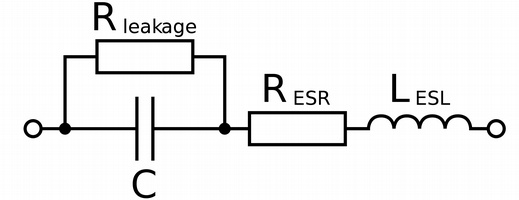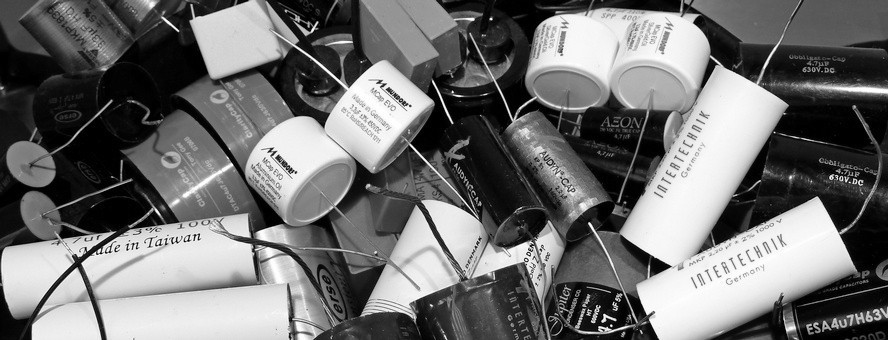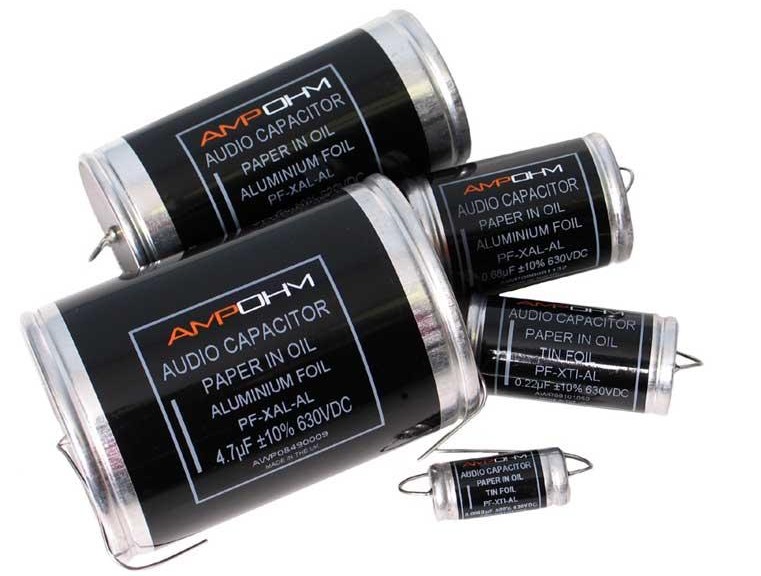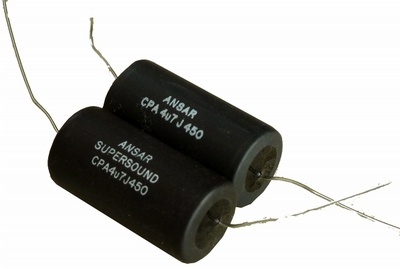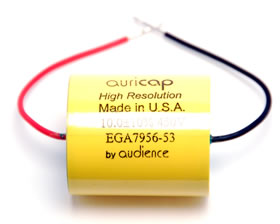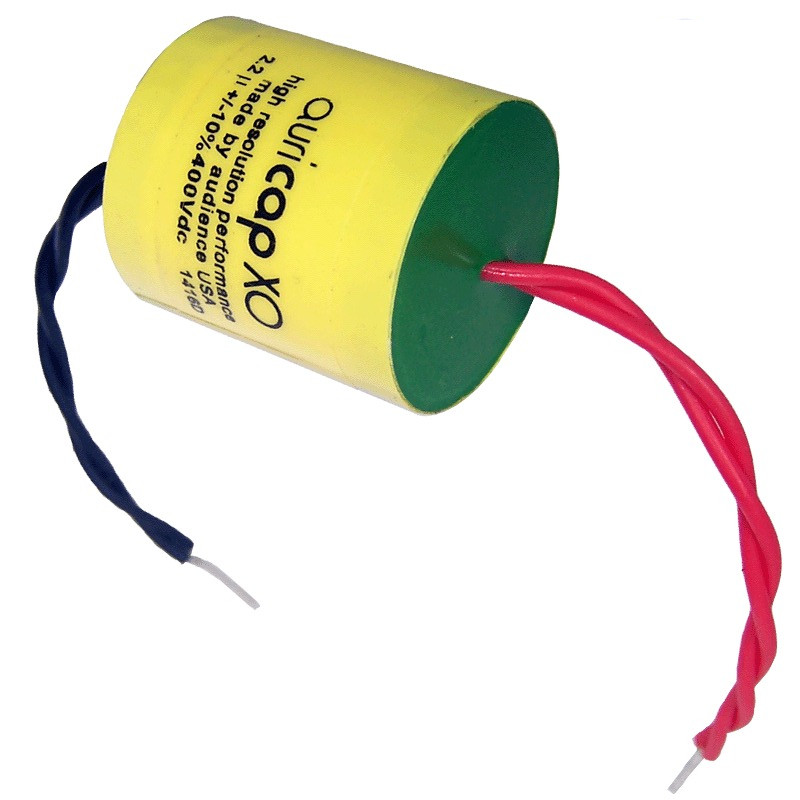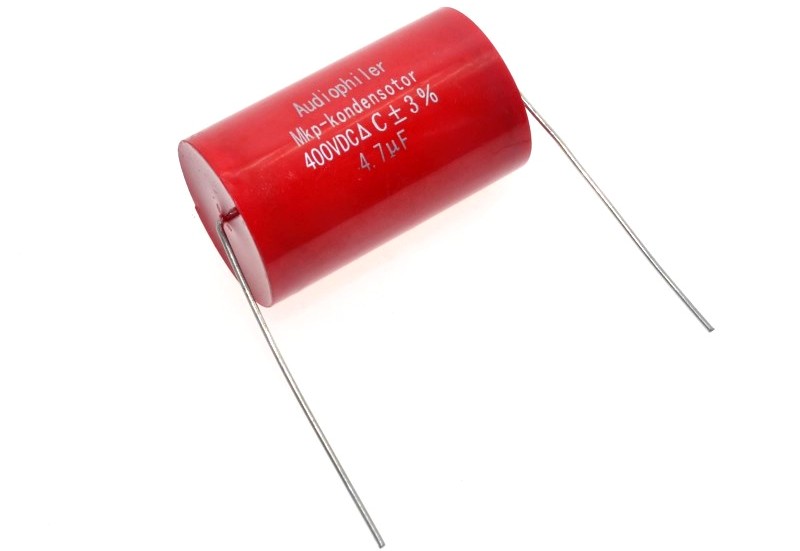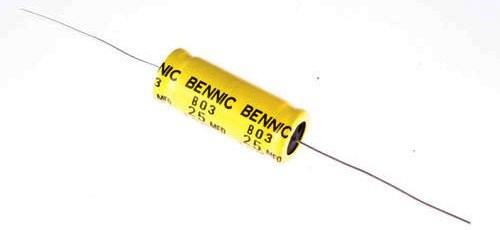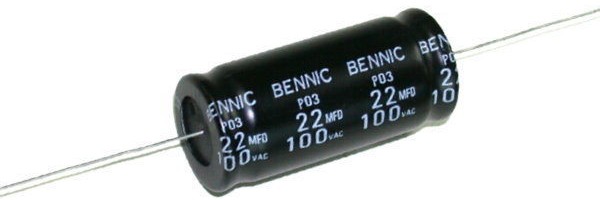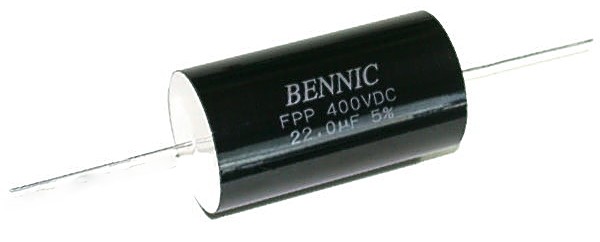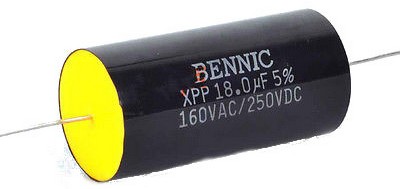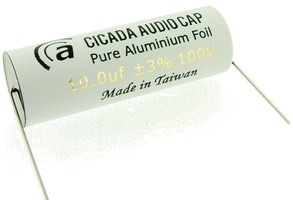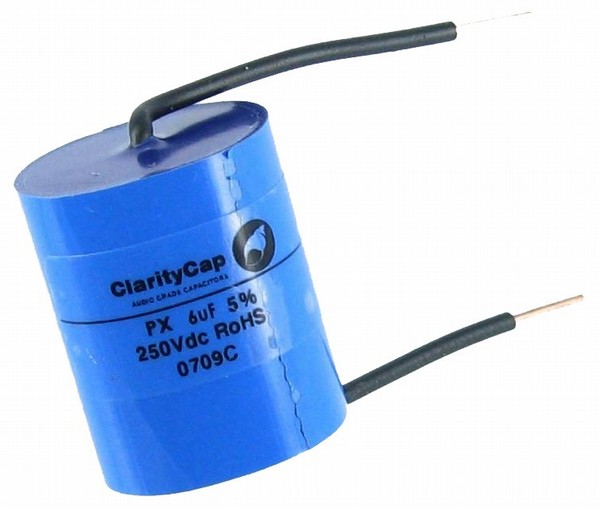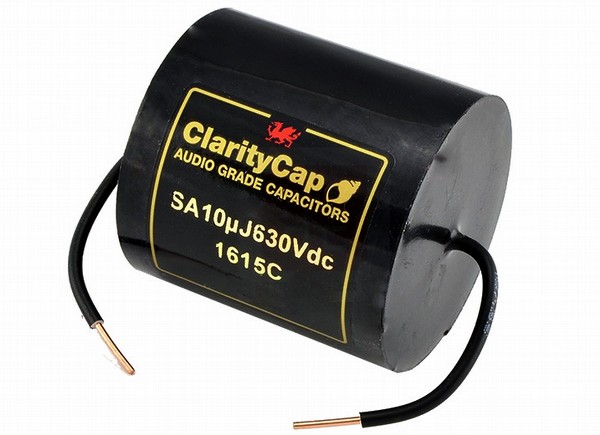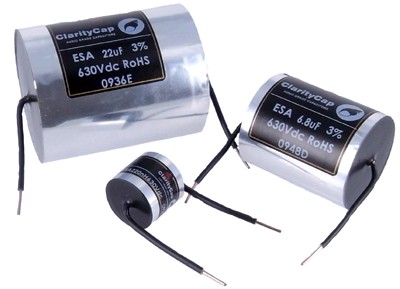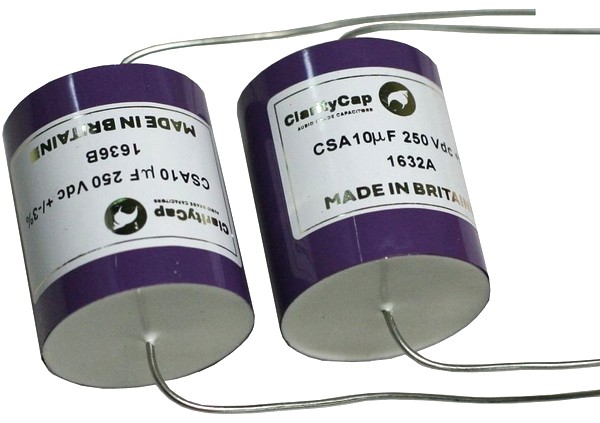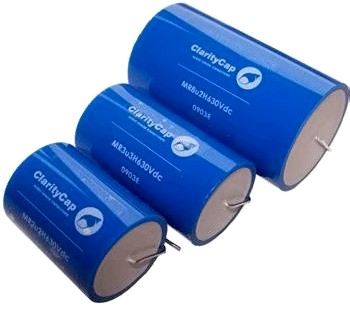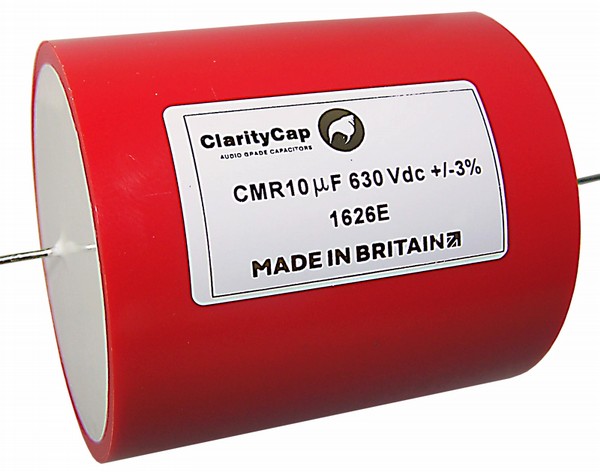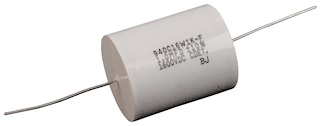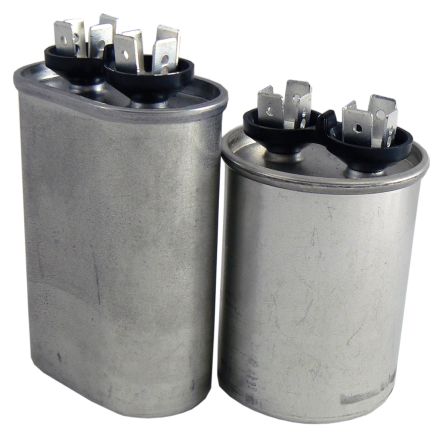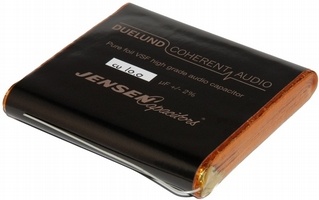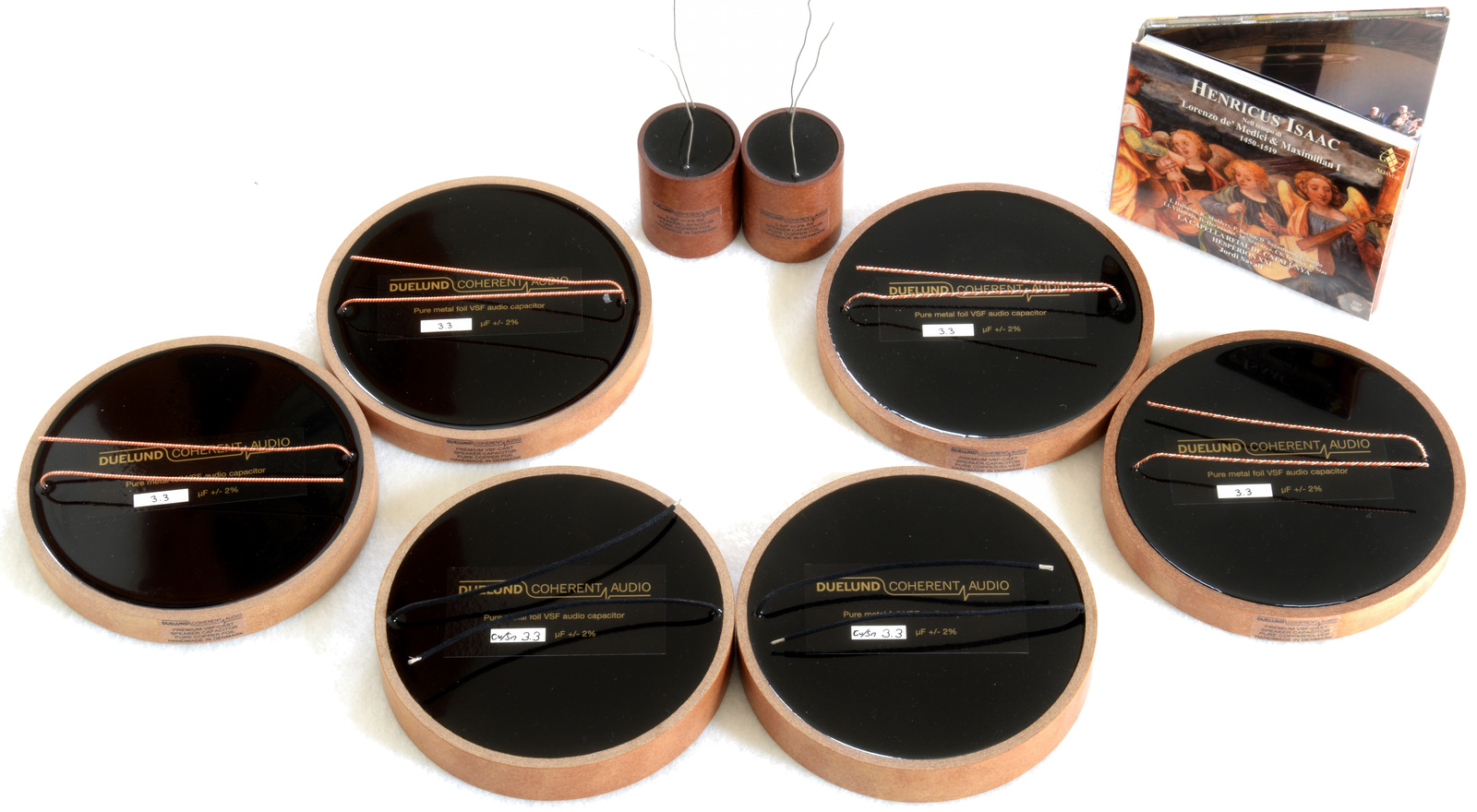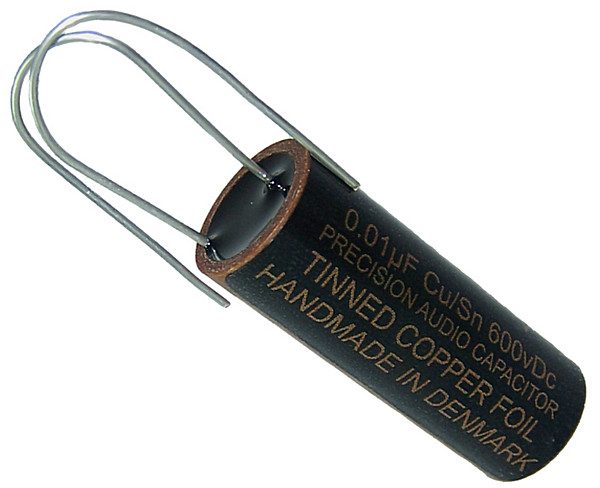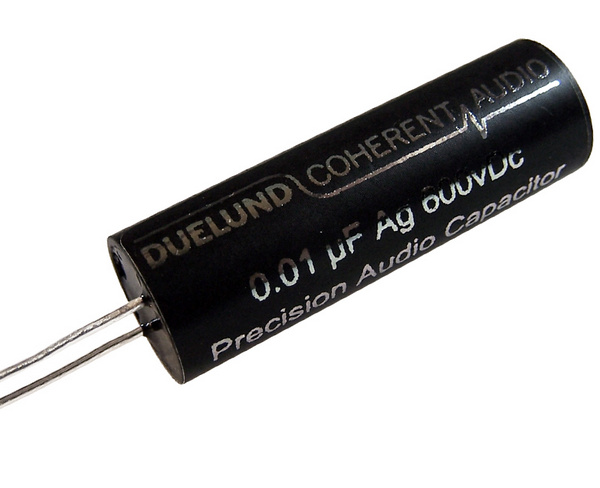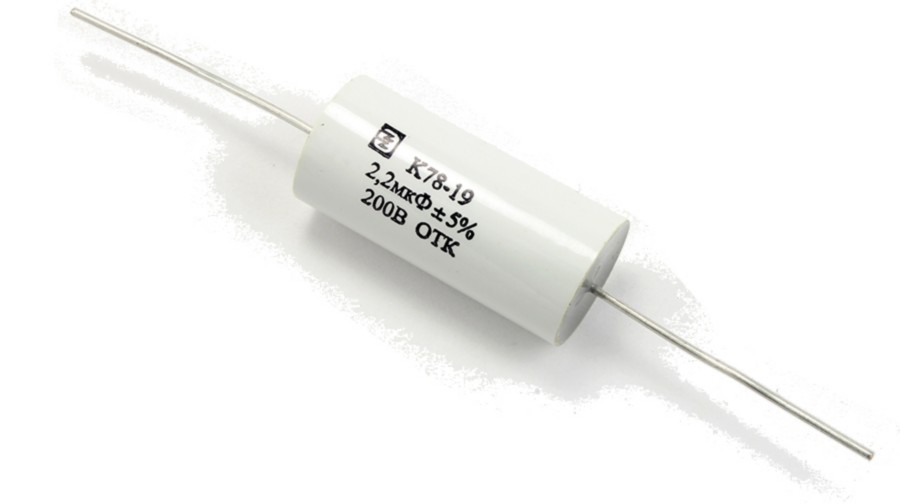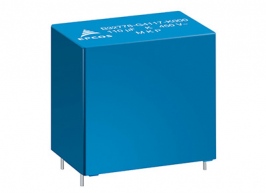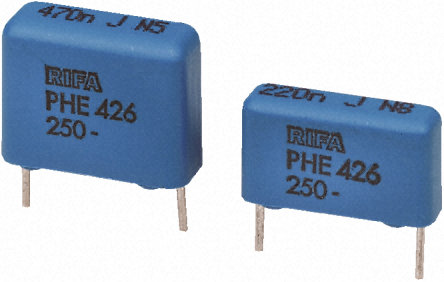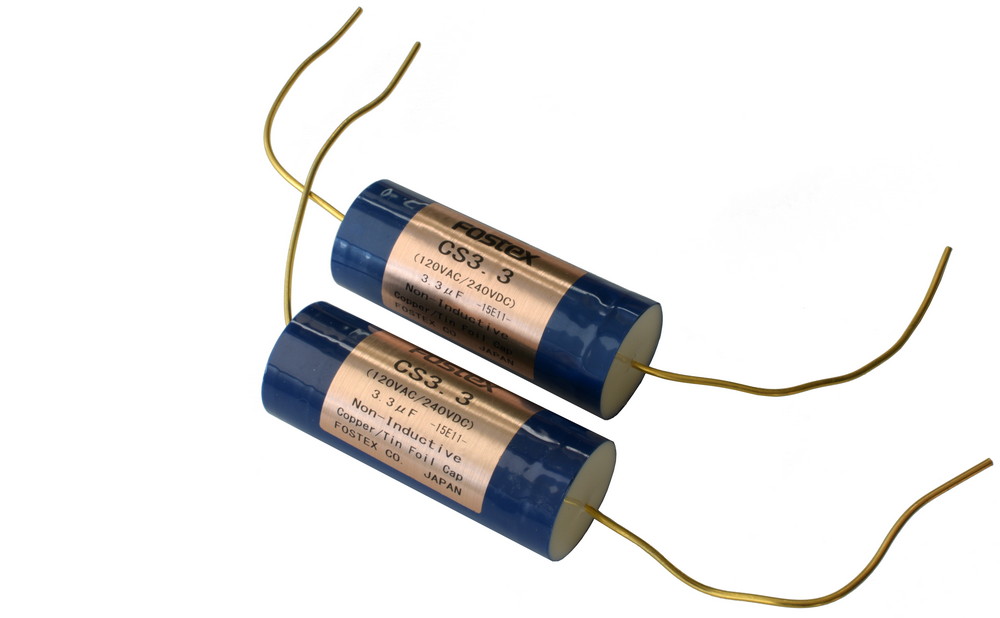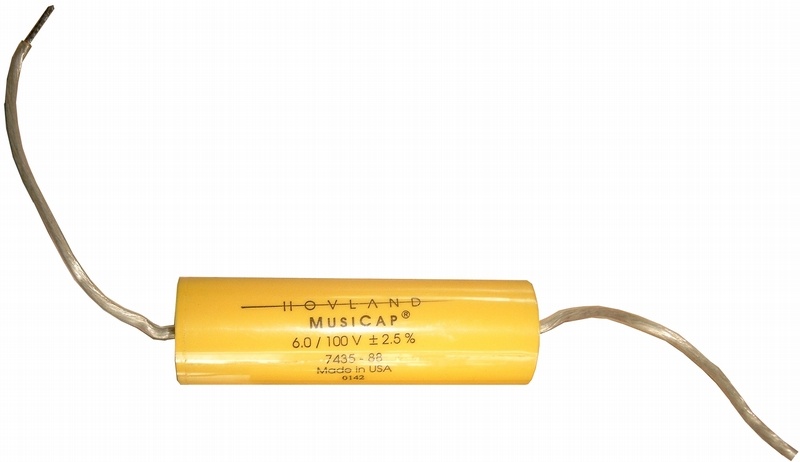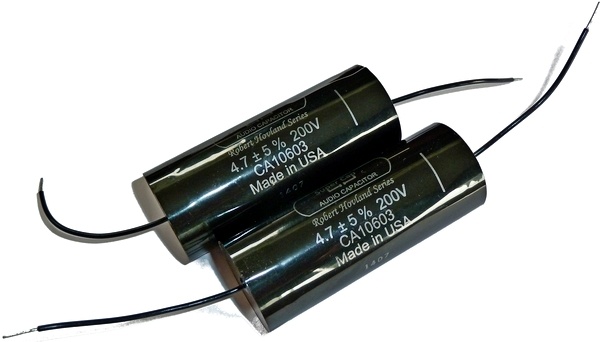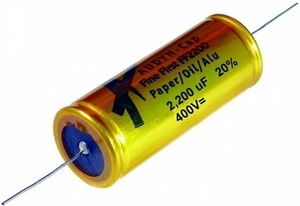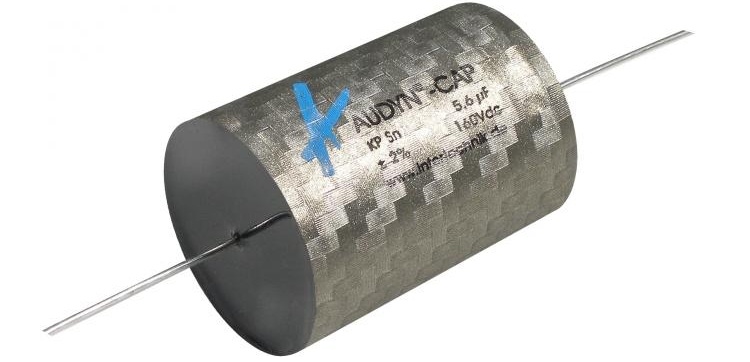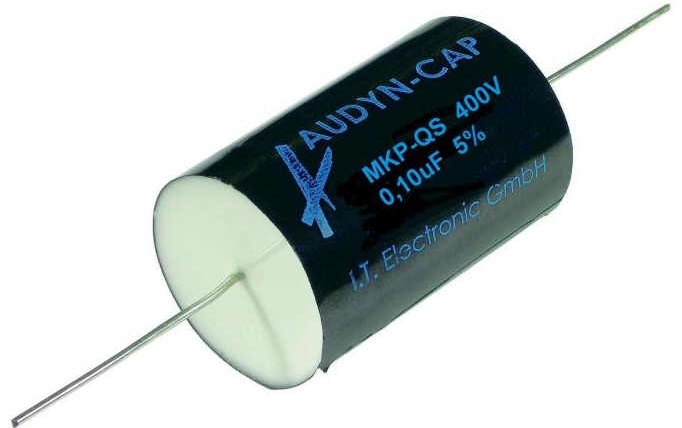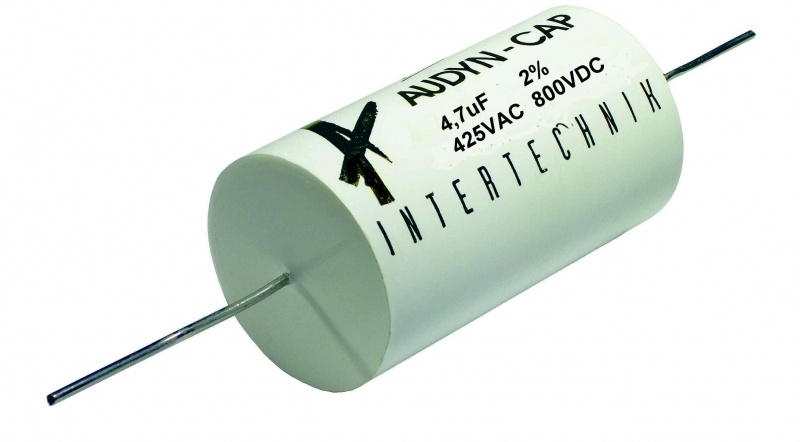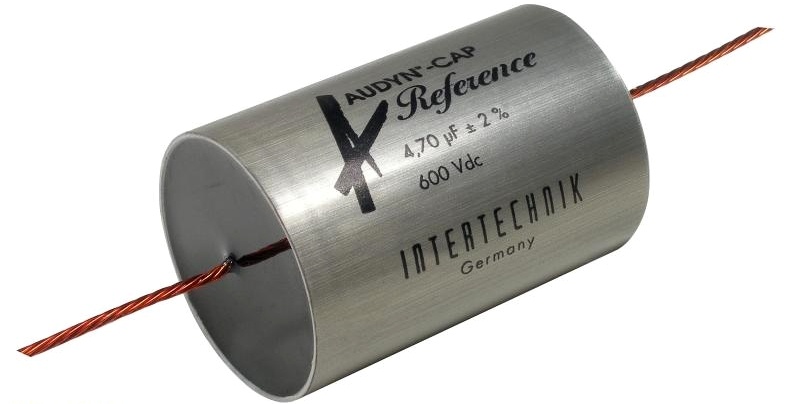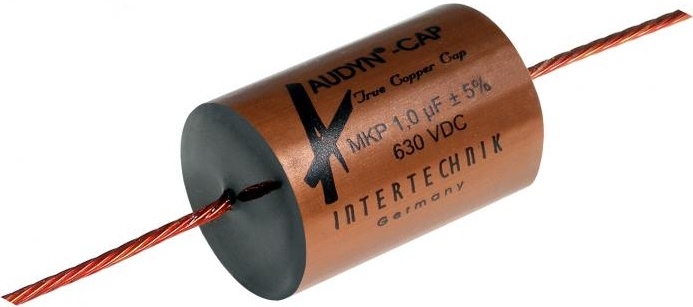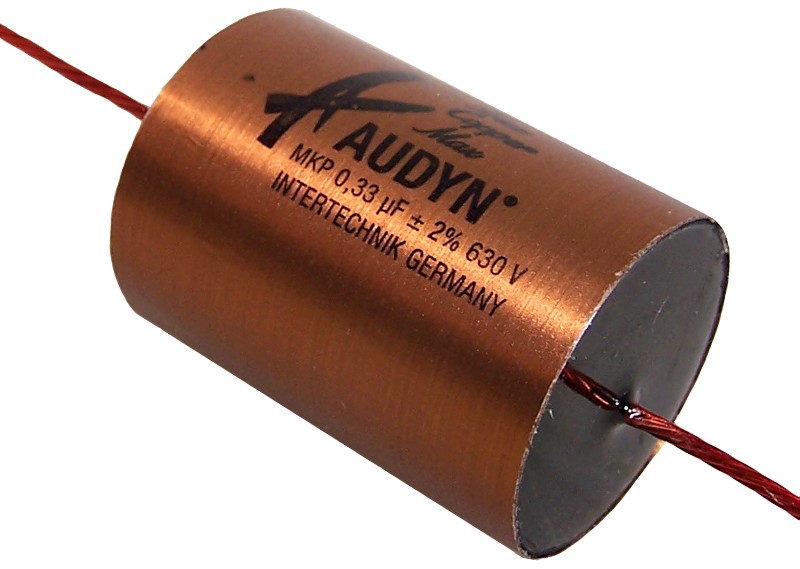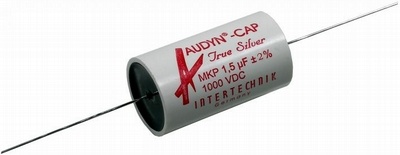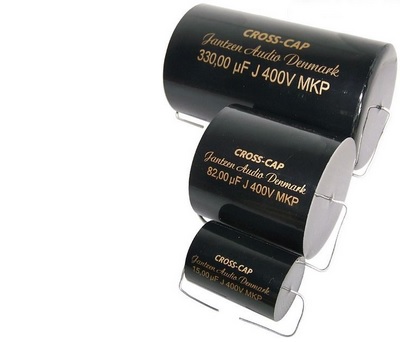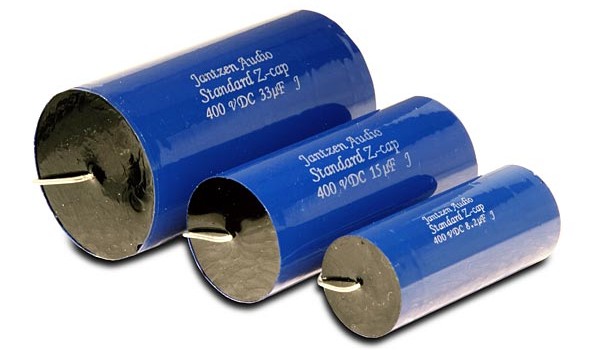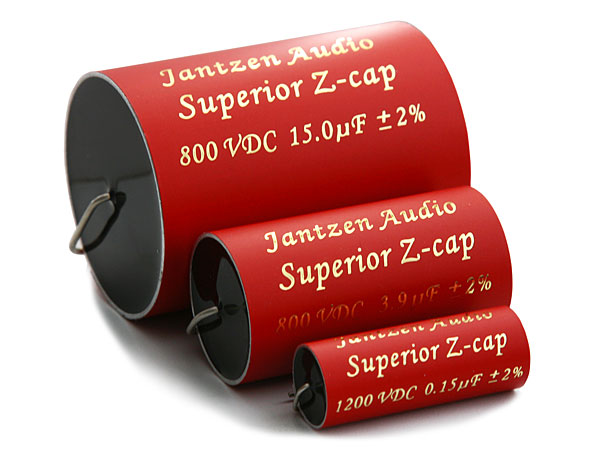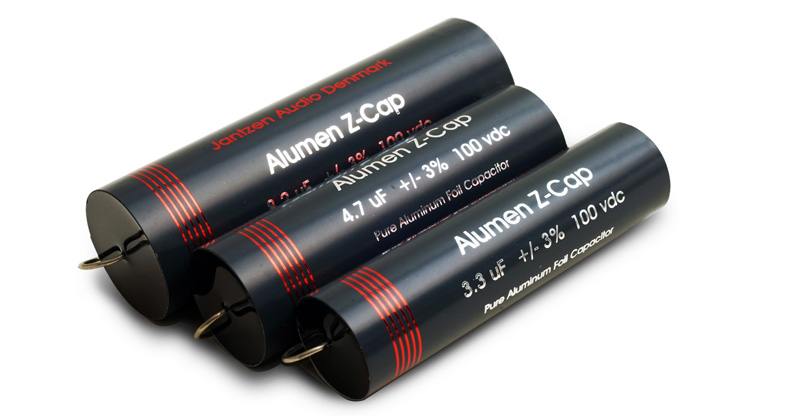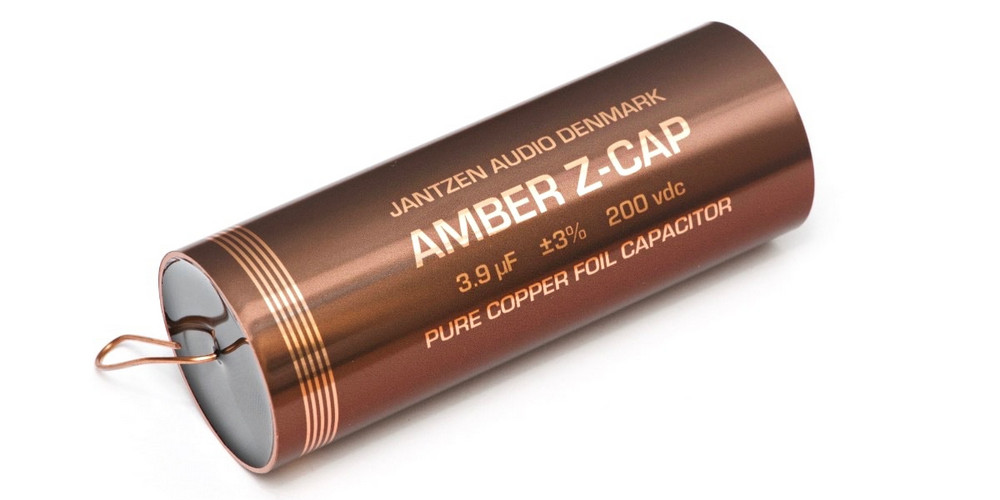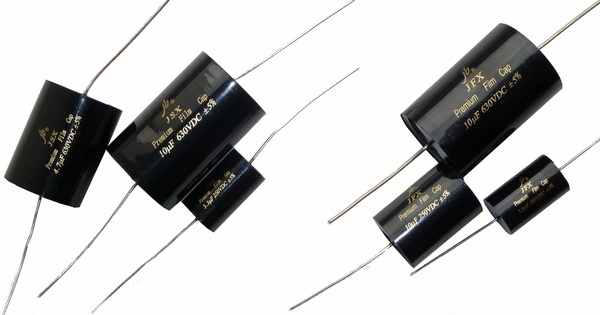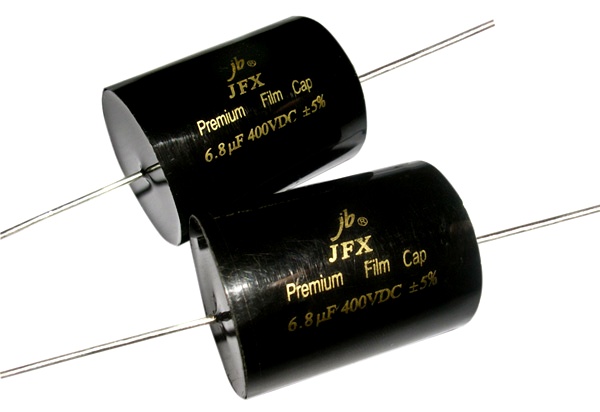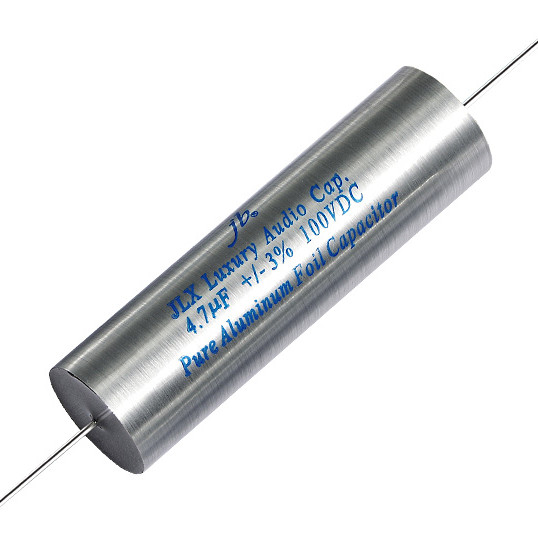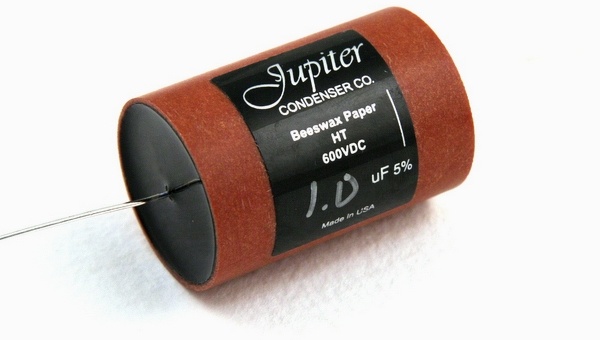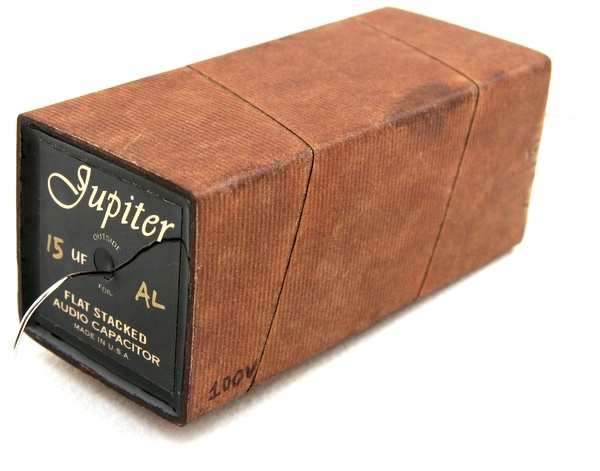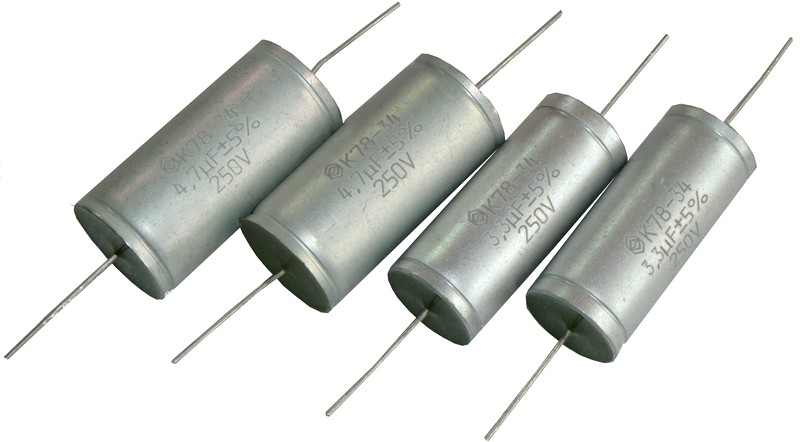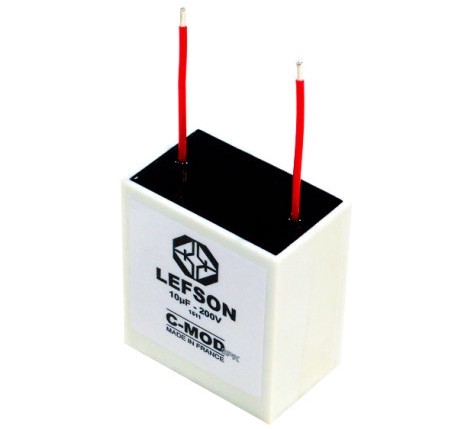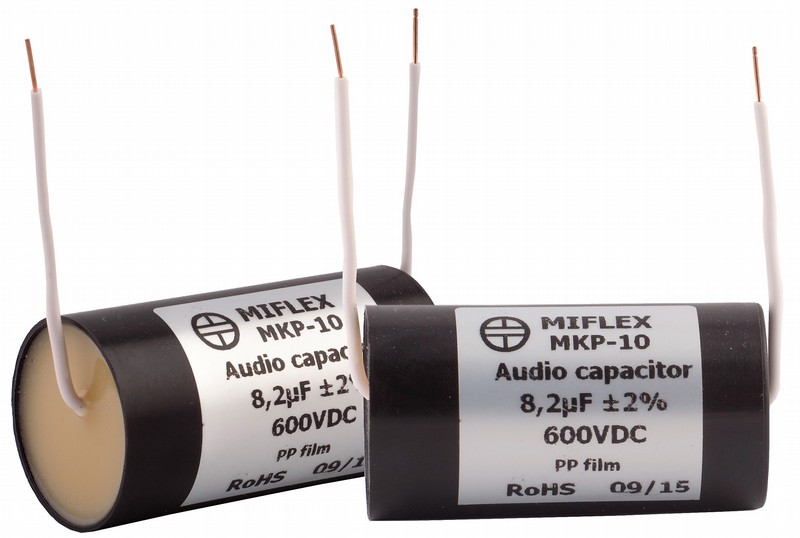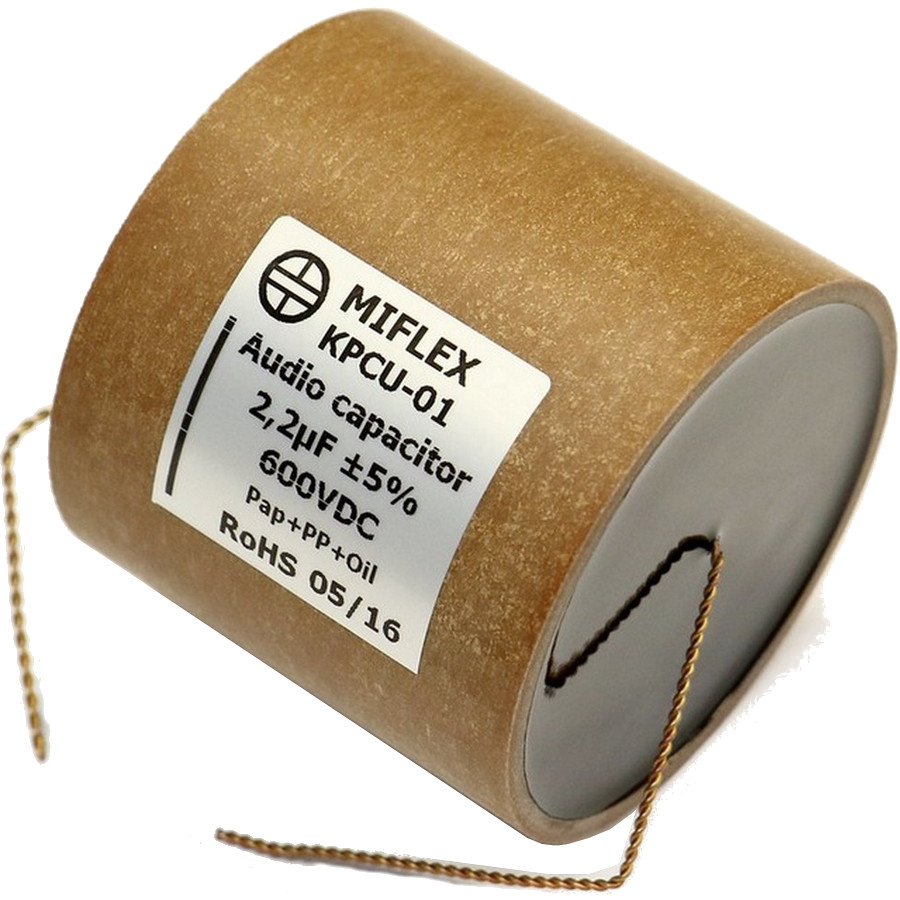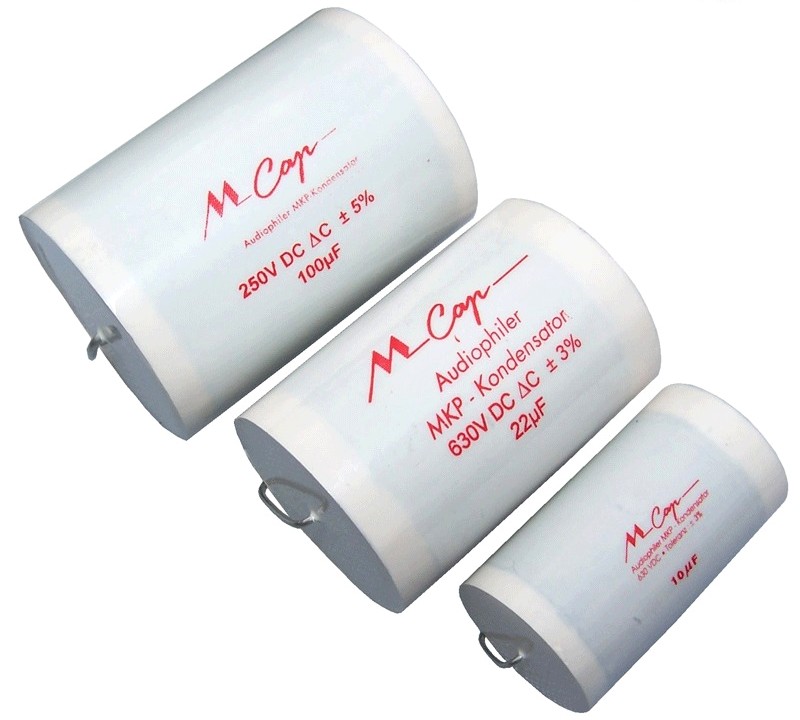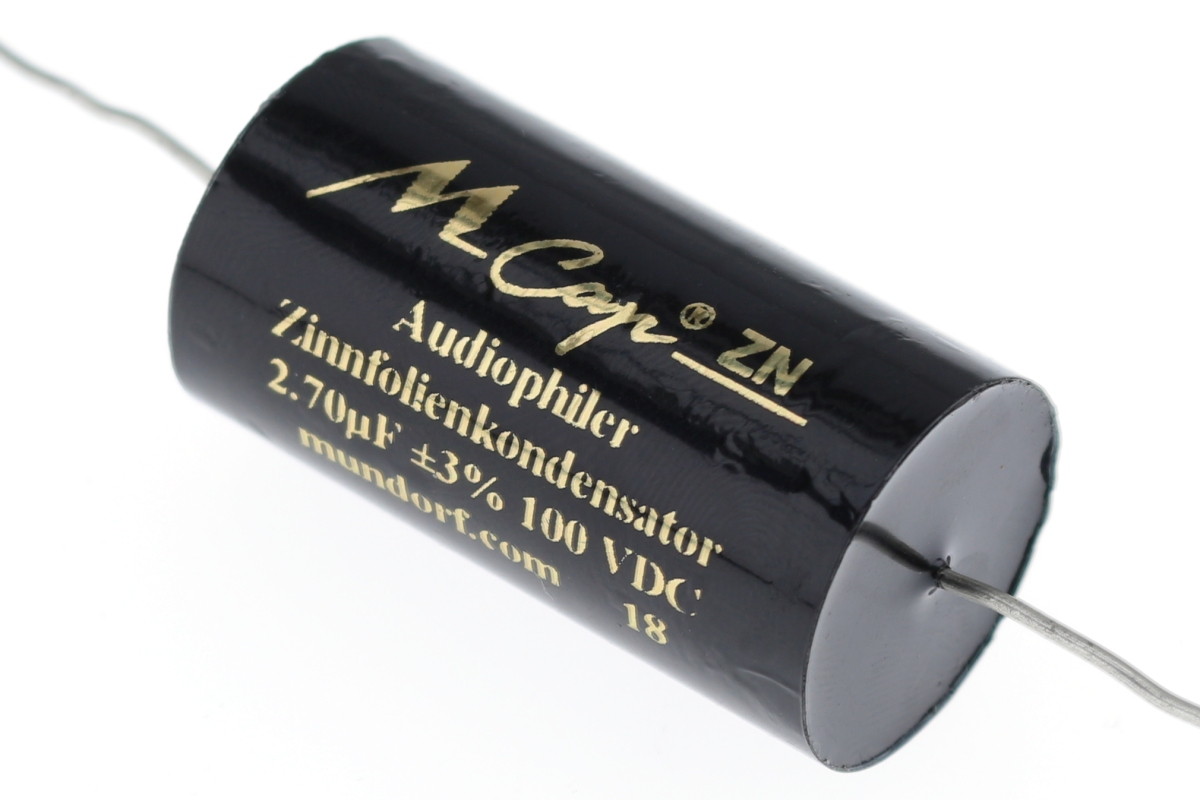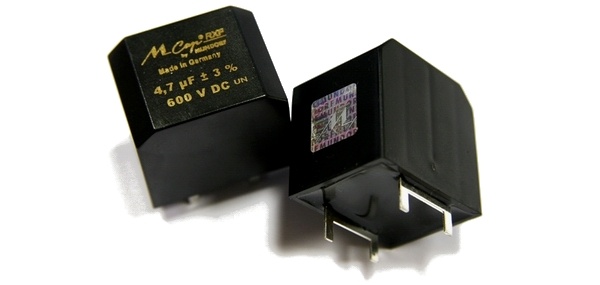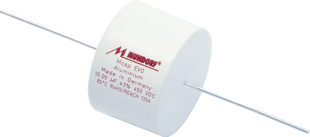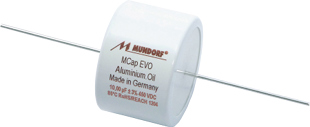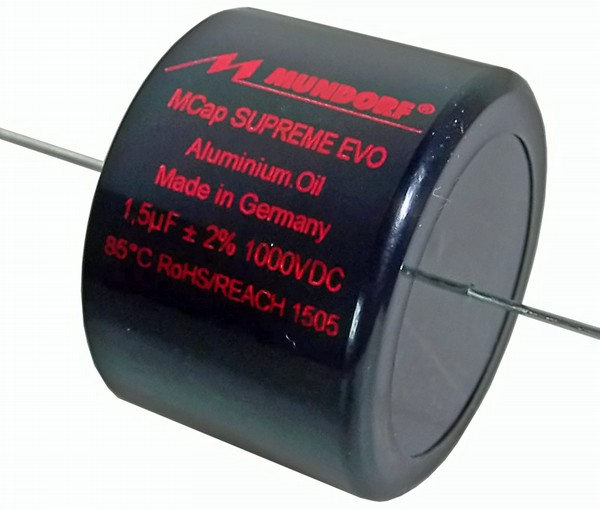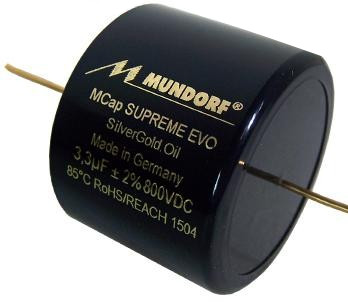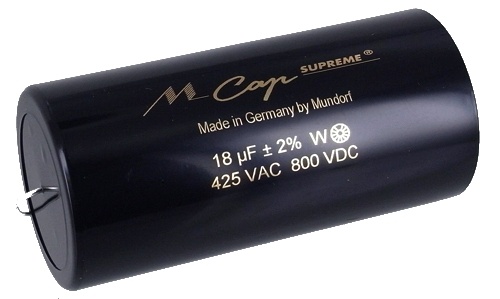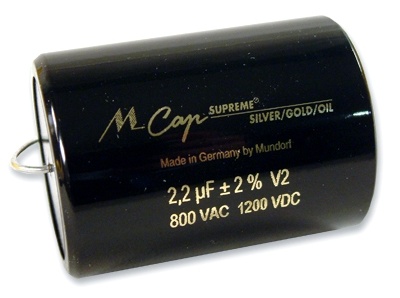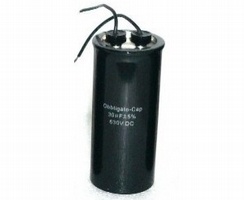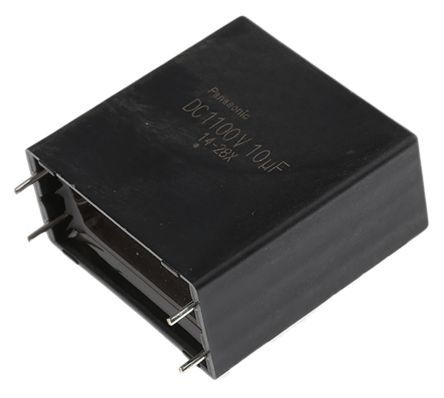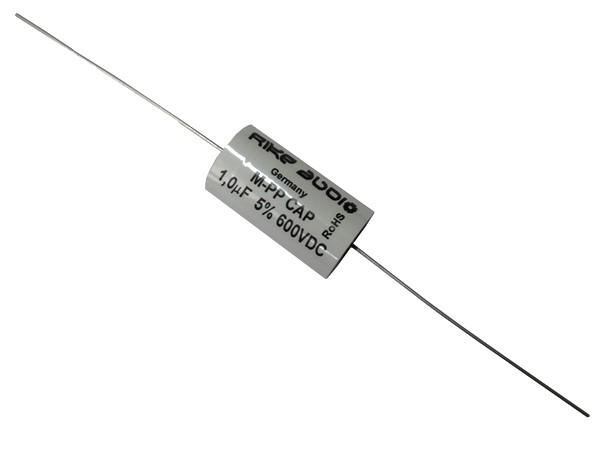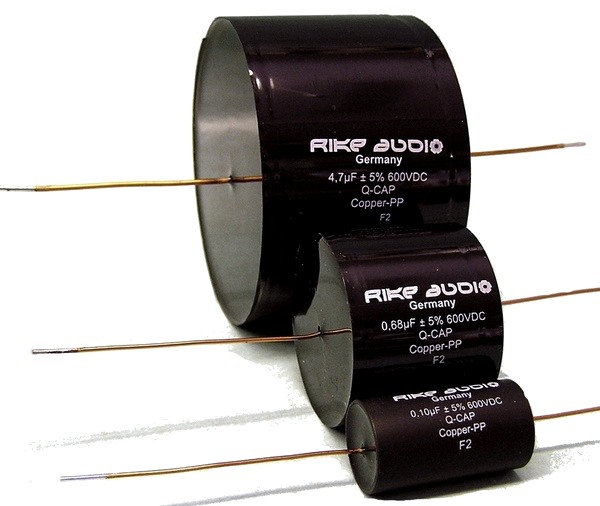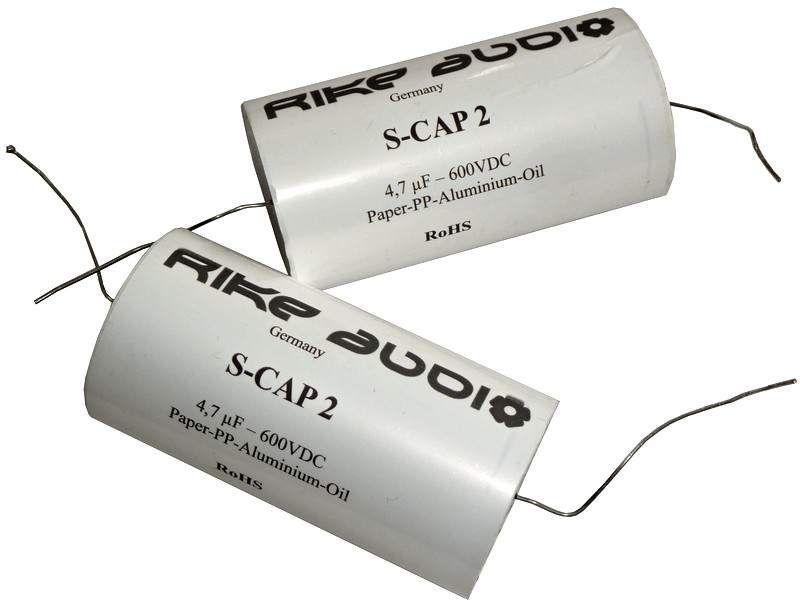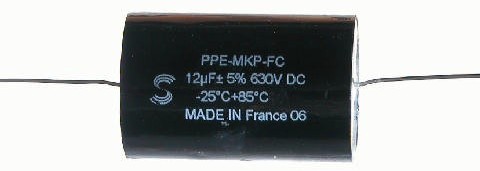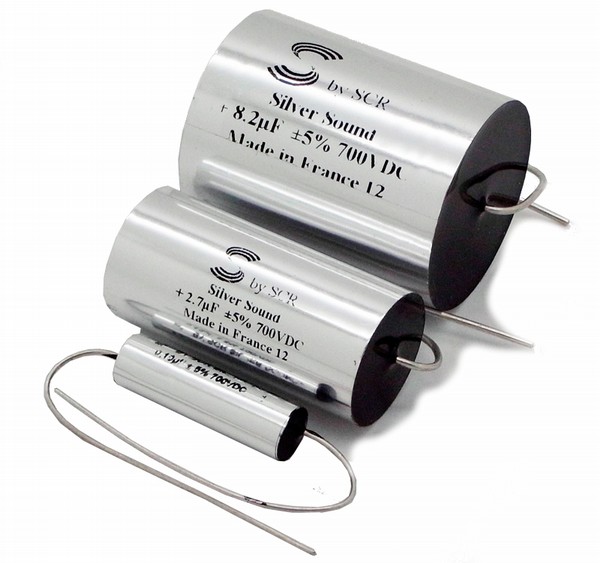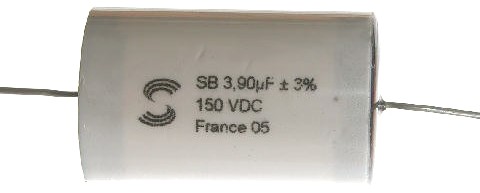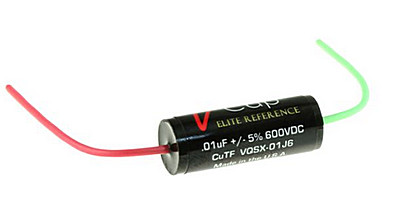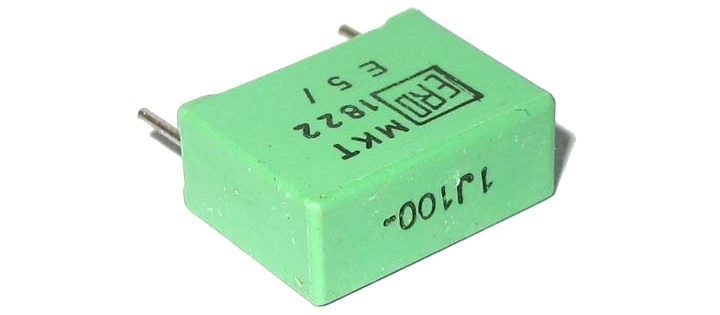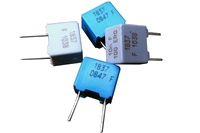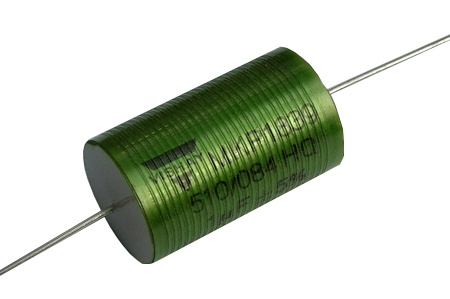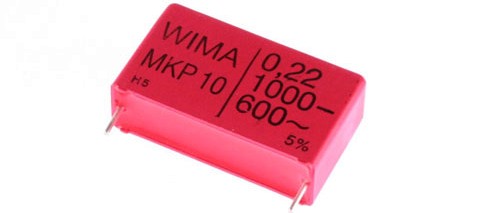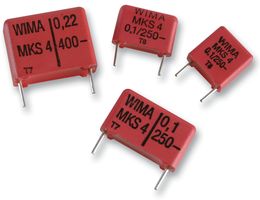|
Please read all of this information carefully before you start using this capacitor test because it contains important information for you. Bookmark this webpage. You may need to read it again. If you have any further questions, send me an e-mail. This webpage has been prescribed for you only. If passed on to others, it may harm them, even if their systems are the same as yours. If you get any side effects, go have a drink with a friend or relative :-)
The subjective results of this test are meant to give you a general idea of the audible differences between capacitors when used in passive loudspeaker crossovers. The capacitors are tested in many different loudspeakers, varying from the ones I happen to be building at the time, to the many other speakers I have. I use solid-state and tube amplification, analogue and digital source equipment and several different interlinks and speaker-cables during the process of evaluation that takes several months of extensive listening. Testing is done by listening to various good quality recordings on CD, hi-res streaming audio and internet radio. The evaluation consists of listening to capacitors over a longer period of time, this way I get a good idea of what each capacitor does and doesn't do in day to day use. I also do direct A-B comparsions with previously tested capacitors to determine the relative differences. Over time it is possible that I re-evaluate my previous conclusions.
The higher the quality of a hi-fi-system the more obvious the differences between various capacitors can be. A higher rating does not automatically mean "better", it is related to the implementation which capacitor will ultimately sound best in a given system. So just replacing everything with "the best" capacitor you can find usually doesn't lead to optimum results. Using different caps in different places throughout the crossover can help you achieve the sonic character you are after. It's just like cooking, a bit of pepper here, a pinch a salt there, etc. Try to obtain the blend of sound that matches your hi-fi system, personal taste and budget the best.
* Personal favourites!
In the past capacitors were just capacitors and sound quality was determined by the dialectric material with polypropylene considered by many as "the best" seeing as this type of capacitor had the lowest losses. But technology of the 21st century has brought us new measuring techniques and insights and there seems to be more to it. We can now measure things that were not possible a few years ago. In a nut-shell: microphony is the keyword - the mechanical resonance, a key feature of audio capacitors. This is a physical deformation of the capacitor plates which occurs as a result of the audio signal passing through the component, in some ways like how an electrostatic speaker works. This resonance is dependent on the size, shape, materials and manufacturing parameters of the capacitors. This effect has been known about for years as it plays a part in the impulse strength of capacitors. However, the effect has never been considered to be significant enough to affect a hi-fi system's audio reproduction due to the low energy involved. For more indepth information read the Clarity Cap white paper on mechanical resonances inside capacitors. AudioXpress also published an article about this study. Another interesting article was written by Martin Colloms back in 1985 in which he tested several capacitors on their sonic differences. A capacitor is more than just capacitance C!
Amp Ohm FP-CA-AU 630VDC - 5% tolerance Technical specifications (according to manufacturer): "Amp Ohm Audio Capacitors are specially designed for high performance audio systems. The capacitors are hand wound and have their insulated copper leads hand soldered before being assembled in a plastic case and resin sealed. The resin filled end identifies the outer winding. This construction results in the capacitors having low ESR and low inductance and possessing high stability with respect to both temperature and frequency. They are ideal for use in loudspeaker crossover networks and valve amplifiers where pure sound is at a premium. Line on label denotes outer foil". Sound: The Amp Ohm FP-CA-AU is a very neutral sounding capacitor that takes a nice smooth and calm approach to the reproduction of music. I found the balance of the midrange very pleasing letting acoustic instruments keep their natural warm tone. Absolute detail and air isn't quite up to the level of an Audyn Cap Plus or Mundorf Supreme but it comes very close although they do need some time to open up so don't judge them fresh out of the box. Spatiality is broad with reasonable depth but if you want "bowling alley" depth go for (the much more expensive) Mundorf Silver/Oil. Compared to the more luxurious Amp Ohm capacitors they are more 2D and a little rough, but again those cost far more. Verdict: 8,5 Amp Ohm PF-XAL-AL 300VDC Paper in Oil aluminium foil - 10% tolerance Technical specifications (according to manufacturer): "Amp Ohm paper in oil (PIO) capacitors are hand wound using high aluminum foil. They are oil impregnated before being assembled and oil filled. The capacitors are then hermetically sealed in an aluminum housing with phenolic resin and rubber end discs. Each lead is hand solder sealed to the eyelets in the end discs. The leads are 1.0mm in diameter and made of tinned copper. All Amp Ohm Audio Capacitors are individually hand tested. Line on label denotes outer foil." Sound: The Amp Ohm PF-XAL-AL 300VDC is very rich in harmonic textures and quite spatious. When fresh out of the box they can be a bit "chesty" or "nasal" sounding but they mellow out after quite some time of use (several hundred hours). Their tonal balance is very neutral and smooth, words like natural and analogue come to mind. Imaging depth is very good but not quite at the same level as their paper-in-wax or polyester-in-oil stable mates. Verdict: 10,5
Amp Ohm PF-XAL-AL 630VDC Paper in Oil aluminium foil - 10% tolerance Technical specifications (according to manufacturer): "Amp Ohm paper in oil (PIO) capacitors are hand wound using high aluminum foil. They are oil impregnated before being assembled and oil filled. The capacitors are then hermetically sealed in an aluminum housing with phenolic resin and rubber end discs. Each lead is hand solder sealed to the eyelets in the end discs. The leads are 1.0mm in diameter and made of tinned copper. All Amp Ohm Audio Capacitors are individually hand tested. Line on label denotes outer foil." Sound: The Amp Ohm PF-XAL-AL 630VDC is basically the same type as the above mentioned capacitor but with a higher voltage rating. The higher rating is obtained using thicker materials and therefore the 630VDC version (65mm) has a larger diameter than the 300VDC version (45mm). Both have the same length (95mm). The 630VDC version reminds me of a can of beer or coke. The higher VDC type is also very rich in harmonic textures and quite spatious. The tonal balance is very neutral and seems a fraction smoother than the lower VDC type. Imaging depth is very good but like the 300VDC version, not quite at the same level as their paper-in-wax or polyester-in-oil stable mates. My review notes also state: black background. Verdict: 11- Amp Ohm PF-XAL-W-AL 630VDC Paper in Wax aluminium foil - 10% tolerance Technical specifications (according to manufacturer): "Ampohm Audio Capacitors are specially designed for high performance audio systems, used in various applications. These paper in wax (PIW) capacitors are hand wound using high purity aluminium foil and have their 1.0mm diameter tinned copper leads hand solder sealed to the eyelets in the end discs. They are wax impregnated before being assembled and hermetically sealed in an aluminium housing with phenolic resin and rubber end discs, all being individually hand tested. Line on label denotes outer foil." Sound: The Amp Ohm paper-in-wax alumnium foil type seems a fraction flatter or condensed sounding when in direct comparison to the Ampohm paper-in-oil alumnium foil type. It is a little more direct in it's presentation compared to paper-in-oil but more laid-back when compared to the polyester-in-oil types. I also noted less "fleshy" and a tad thinner than the Ampohm PIO. There also seems to be a fraction more emphasis on the frequency extremes giving it a miniscule loudness effect when compared to the very analogue midrange character of the polyester-in-wax type. This is not meant in a negative way seeing the overall high quality sound level of this capacitor, as it's character could prove usefull when fine-tuning a loudspeaker in a certain direction. Verdict: 10 Amp Ohm FE-XAL-AL 630VDC Polyester in Oil aluminium foil - 10% tolerance Technical specifications (according to manufacturer): "Ampohm Audio Capacitors are specially designed for high performance audio systems. These polyester film capacitors are hand wound using high purity aluminium foil and have their leads hand soldered before being assembled and hermetically sealed in an aluminium housing with phenolic resin and rubber end discs.The 1.0mm diameter tinned copper lead out wires are solder sealed to the eyelets in the end discs This construction results in these components being ideally suited for use as coupling capacitors or as replacements for components in existing designs. Line on label denotes outer foil." Sound: The Amp Ohm polyester-in-oil alumnium foil is overall very coherent and neutral. This type has a pleasent midrange-highlight when in direct comparison to the Ampohm paper-in-wax alumnium foil type. The polyester-in-oil is very rich and extremely good in retrieving ambient information such as room or hall acoustics. Music is presented in a natural and full-bodied manner. Compared to the Duelund VSF-Cu copper-foil the image is more "see through". Compared to the Mundorf Silver-Gold-Oil the presentation is richer, especially noticable on massed strings or large vocal works. On small jazz-trio's etc the Silver-Gold-Oil high-lights micro detail a little more but doesn't quite reach the same level of overall coherence the polyester-in-oil does so well. Verdict: 11+ Ansar CPA polyproylene 450VDC - 5% tolerance (a.k.a. Ansar Supersound) Technical specifications (according to manufacturer): "General purpose Audio grade component. Axial design. Ideal for all general audio usage, a wide range of voltages and values available. This range of components was designed mainly for the loudspeaker crossover manufacturers. The components are manufactured with the aim of producing a highly transparent component for use in critical signal paths such as the crossover network. They are an excellent all round product which have been designed to offer the best compromise between quality and cost. Highly regarded throughout the industry they are used by many of the UK's leading loudspeaker manufacturers." Sound: The Ansar CPA has a vibrant, clean and clear nature that seems to be concentrated more on the top-end of the spectrum. Not completely neutral but therefore they can be usefull if you want to give a more open sound to a system that sounds a bit congested in the midrange and / or lower treble, in such a situation the Ansar CPA open's things up nicely. Used in a tonally neutral system they could do with a bit more presence and body, they tend to lean towards a slightly thin nature. This nature can make acoustic instruments like a grand piano or massed strings sound a bit distant. For example a Jantzen Audio Standard Z-Cap is more neutral and has more body weight but lacks the top-end "sparkle" the Ansar CPA produces. Nice thing though is that they never get harsh nor rough around the edges. Image depth is slightly flatter than higher grade capacitors but compared to other general purpose MKP's they perform very well. Top end detail is more prominant than the slightly rolled-off nature you find with a Clarity Cap SA. The Clarity Cap SA in return sounds more up-front in the lower treble range. They are nicely compact in size, so they can turn out handy when space is critical. Verdict: 7,5
Arcotronics MKP-C4G 600VDC - 5% tolerance Technical specifications: Self-healing metallised polypropylene snubber capacitor intended for use in power semiconductor circuits to suppress or attenuate undesired voltage peaks e.g. electronic ballasts and motor applications. Sound: The Arcotronics cap is a modest sounding capacitor, a little on the quiet side concerning dynamics. I quite like the midrange quality especially with percussion music. Drums, etc. had a nice natural timbre. There seems to be a focus on the midrange, the treble is slightly rolled off. Spatiality is a little compromised resulting in a slightly distant and compact image. Overall detail is slightly better than a standard Audyn Cap for example but doesn’t compete with an Amp Ohm or Mundorf Supreme. A good MKP for basic filter applications. Verdict: 7 ASC X386S MKP in oil 600VDC - 10% tolerance Technical specifications: Industrial application capacitor. Although the tolerance stated is meant to be a poor +/- 10%, I measured all of them and they were all spot-on the stated capacitance. Now that is what I call built to industrial standards! I guess they state such a large tolerance because being designed for industrial applications they will be used in varying temperature conditions. The vegetable oil inside will therefore vary in fluency. But at normal room temperature they seem to be at their best. The values are different to the standard range but they come in values from 1,0 to 60uF although small quantities are hard to get unless you want to order more than a hundred of them. ASC also supplies these metallized polypropylene types to other notable High-End Audio companies, including Conrad-Johnson. ASC polypropylene and oil capacitors feature a sealed metal 'oil can' construction and hefty four-way solder/connector lugs on the bottom. The capacitor itself is made of metallized polypropylene film, similar in construction to standard MKP's, but suspended in a bath of vegetable oil: some claim that this oil provides a damping effect in audio circuits. When you shake it you can hear the oil splash around! Sound: They sound a bit dull at first because they take a while to burn-in. But after a few days of normal use they deliver a wide and open sound stage. Nice and neutral, maybe a slightly warm and lush sound. One of those things that don’t impress at first but sort of grow on you after a while, you learn to appreciate their qualities - great! If you want a lively and bright sounding filter then this is not your cap (try a Hovland Musicap instead), if you are looking for a smooth, warm and relaxed sound then give these a try. Verdict: 8- Audience Auricap 200VDC - 10% tolerance Technical specifications (according to manufacturer): "Auricap metalized Polypropylene capacitors are cylindrically wound with epoxy end fill and have very good volumetric efficiency. They are wound to exacting industry leading specifications to meet or exceed the requirements of MIL-C-55514A and MIL-STD-E method 103B. As with all metalized polypropylene film capacitors Auricaps are self healing. Failure mode is as an open circuit. Auricaps are made with the very best film available and are constructed to center value. Special care is taken to insure industry leading ESR values. Auricaps are designed to be a general purpose capacitor for use in all applications where size, value and temperature considerations are suitable. They are useful in signal coupling, filtering and power factor correction applications. The outside foil connection of Auricaps is identified with either a black lead (when leads are red and black) or a shorter lead when leads are solid core type. This identification is not a voltage polarity indication but is a consideration for minimum noise pick up." Sound: I find these capacitors to have a pleasently smooth and clear presentation that is slightly forward if directly compared to bright-ish capacitors like the Jantzen Silver Z-Cap or Silver Gold Z-Cap. The Auricap retrieve enough amibent information that helps to make an orchestra properly placed in a concert hall (recording permitting) and project the image more in the width than in the depth. Overall performance is very satisfactory and has something correct / complete about it. Verdict: 9
Audience Auricap XO 200VDC - 10% tolerance Technical specifications (according to manufacturer): "Auricap XO is a new high performance capacitor product from Audience that is the result of rigorous consideration of every aspect in capacitor design and the manufacturing process. Audience has reconsidered a host of parameters including tension windings, baking times and cryogenic treatment among other proprietary procedures. Auricap XO is made using the very finest obtainable polypropylene film and new high purity continuous cast copper leads. This new capacitor design offers reduced parasitic such as ESR improving on its effective bandwidth, clarity and coherence. With these design changes a new level of performance is reached with even less coloration, micro-phonics and noise contribution than the famous Auricap. There are no drawbacks to the Auricap XO in comparison to the standard Auricap. Users can still expect all of the wonderful virtues for which the standard Auricap is known. In brief, the Auricap XO is simply more transparent allowing you to hear farther into the music. " Sound: I can agree with Audience AV in that the Auricap XO is definitly more transparent than the standard Auricap. I found the XO to still have a pleasently smooth and clear presentation but gone is the slightly forward nature. They are more open and have more fine detail. These characteristics make it easy to follow the leading edge of instruments and create a greater sense of depth in the recording. Compared to the extremely neutral Jantzen Audio Superior Z-Cap there is more clarity, while maintaining a similar level of neutrality. Although there is lots of detail the XO never becomes edgy or sharp like some other "detailed" capacitors can sometimes be. Comparing the Auricap XO to the Jantzen Audio Amber Z-Cap it is obvious what you don't get with the XO: the rich and natural tone that only true copper foil capacitors can give. But that is an unfair comparsion as those type of capacitors cost a multitude of the Auricap XO. Overall I found the Auricap XO to have a nice balance between detail, transparancy and smoothness. I have added it to my favourites list. Verdict: 11
Audio Cap PPMF MKP 200VDC - 10% tolerance Technical specifications (according to manufacturer): "The PPMF Audio Caps are metallized polypropylene, useful as upgrade from Mylar or inferior film caps, and available in values large enough to be ideal for speaker crossover networks. They are built of the best materials and exhibit excellent electrical and environmental characteristics. Their superior build quality and high capacitance values provide a high-quality stable, long-term performance not usually found in this price range. The gold-plated OFHC leads provide long-term high reliability and excellent solder ability, superior to silver wire because of gold's non-oxidising properties." Sound: Slightly more detail, depth and separation than a standard Mundorf M-Cap but slightly less than a Hovland Musicap. The M-Cap has a more round character, the Audio Cap PPMF a more laid-back character. For the rest I find them reasonably neutral. Verdict: 7,5 Audio Cap Theta PPT MKP-Sn 200VDC - 10% tolerance Technical specifications (according to manufacturer): "The PPT Theta Audio Cap is an excellent film & foil capacitor for all audio circuits and power supplies. It provides low distortion performance and long-term reliability. It exhibits excellent electrical and environmental characteristics at a reasonable price. Its sonic signature is rich and full and its superior build quality ensures a high-quality stable, long-term performance not usually available in this price range. The gold-plated OFHC lead wires provide long-term high reliability and excellent solder ability, superior to silver wire owing to gold's non-oxidising properties." Sound: These caps have a lean, clinical brightness to them and at the same time lack transparency. A form of artificial clarity is created by means of a treble glare in the top end - at least they don't have a loudness effect. They work well in opening-up a dull, lifeless speaker but that's about it. Use them as a small value parallel to a large "dull sounding" cap only; they will clean up a cheap Intertechnik Audyn Cap nicely. Verdict: 6,5 Audiophiler Mkp kondensotor 400VDC - 3% tolerance Technical specifications: Because there are no manufacturer's specifications to be found I measured several values myself. In general I found that values up to about 6,8uF measured well in regards to capacitance tolerances (often within about 1%) and also losses at very high frequencies were within what can to be expected for an MKP capacitor. Values above 6,8uF seemed to have greater capacitance tolerances (still within 3%) but losses became drastically higher as the capacitance increased. Making large values by putting multiple smaller value capacitors in parallel solved this issue. Sound: Before I get into talking about how these capacitors sound I would like to say a few words about the data on these capacitors. First of all I did not make a typo in the name of these capacitors, they really do have "Audiophiler Mkp kondensotor" printed on the side. Now I know that the Chinese manufacturer must be trying to look interesting by writing the name in German, but please, do your homework first. All German nouns start with a capital and the last word contains a spelling mistake. It should read "Audiophiler MKP Kondensator". Furthermore, the only information I could find about these capacitors was from sites such as Ebay, Amazon and AliExpress. "Audiophiler" don't seem to have their own website (correct me if I am wrong) so lots of misprint or wrong information can be found. For example some company on AliExpress is selling them as MKP's (polypropylene) but in their specifications they state that polyester is used as dialectricum. Some are pictured as "MKP-CYCAP" but sold as "Mkp kondensotor". I found another company selling them as "Home Amplifier" :-) Also pricing seems to be totally erratic. Anyway, make sure that you know what you are getting before you buy any. Now I have got that out of the way, time to explain how they sound. They have a slightly different character to a standard MKP like the Intertechnik Audyn Cap QS4, just to name one of many. The "Audiophiler" has an emphasis on the lower treble range making them a bit upfront or foward sounding. This nature does make them subjecively more dynamic which can work well in certain systems or with certain types of music such as solo piano or string quartets. Not completely neutral but they can be usefull in certain situations. They remind me a bit of the Solen PPE-MKP-FC in their presentation. Play vocals and they can get a bit shouty sometimes. Compared to a Bennic FPP the "Audiophiler" are slightly rougher, less smooth. All in all not bad but also nothing special. Like the Solen they are a good step up from standard MKT capacitors often found in factory built speakers in being a fraction more spatial and open. Verdict: 7
Axon True Cap 250VDC - 5% tolerance Technical specifications: Low cost polypropylene capacitor very similar in physical appearance to SCR, Solen and Angela branded capacitors. Sound: The Axon True Cap has a slight focus on the lower treble range giving it a fat and juicy character. They lack air and micro detailing, but what can you expect in this price range? They are not very subtle either but they never get harsh or over bright. Just your basic, standard quality MKP. It is rather like the Solen Chateauroux Fast cap but has a fraction more clarity so that is why it gets a higher rating. Nothing wrong with them but also nothing exciting. For example a WIMA MKP4 is more open, smoother and has better imaging. Verdict: 6,5 Bennic B03 100VDC - 10% tolerance Technical specifications (according to manufacturer): "Bi-polar electrolytic capacitor; Life test after rated voltage applied for 1000 hours at 85ºC: capacitance change within ± 20% of initial value and dissipation factor within 200% of initial value; Shelf life: after rated voltage applied for 1000 hours at 85ºC: capacitance change within ± 20% of initial value and dissipation factor within 200% of initial value; Sleeve standard color yellow." Sound: The Bennic B03 has a slight nasal character and lacks detail. It can be used in very low cost solutions as long as you take care to voice the system around the B03. Comparing the B03 to basic MKP's such as the Monacor MKPA or Jantzen Audio Cross Cap you can here that the extra money spent on an MKP is very much worth it. With such MKP's you get a gain in transparancy and weight. When complex material is fed to the B03 they start to get muddy. Personally I would only use the B03 in things like low frequency correction networks,etc. But I guess that is the only place you would use bipolar electrolytics anyway. Verdict: 5+
Bennic P03 100VDC - 10% tolerance Technical specifications (according to manufacturer): "Bi-polar electrolytic capacitor; Life test after rated voltage applied for 1000 hours at 85ºC: capacitance change within ± 20% of initial value and dissipation factor within 200% of initial value; Shelf life: after rated voltage applied for 1000 hours at 85ºC: capacitance change within ± 20% of initial value and dissipation factor within 200% of initial value; Sleeve standard color black." Sound: The Bennic P03 is similar in character to the B03 although I must say that the P03 is the more mature sounding of the two. It is better balanced (less nasal) and overall it sounds smoother. The Bennic P03 has a slight loudness effect to it which can work in certain systems that are a bit too forward sounding. Actually a bit like the Bennic XPP although the P03 can get a bit rough around the edges sometimes. Verdict: 6-
Bennic FPP 400VDC and 630VDC - 5% tolerance Technical specifications (according to manufacturer): "Pure Copper leads, minimum length 30 mm; solid lead diametre 0.8mm, colour black tape on white body; UL flame retardant body resin; capacitance tolerance ± 10%(K) or ± 5%(J) or ± 2.5% (H) or ± 1%(F); dissipation factor max 0.06% at 1Khz; operation temperature -40ºC to +105ºC; capacitance drift maximum 2% cycled through the operating temperature range; insulating resistance C less than 0.33µF , I.R. = 9000 Mega-Ohm (at 20 ºC, 1 min) C more than 0.33µF , I.R = 7500 Mega-Ohm (at 20 ºC, 1 min); life test 150% of rated working voltage at 105 ºC for 1000 hours." Sound: The Bennic FPP is a reasonably neutral capacitor for basic, allround solutions. Being neutral it does everything okay in all situations. Okay just about somes it all up actually. It blends in well into existing loudspeaker crossovers like most standard quality MKP's do. Compared to a JB Capacitors JSX, the FPP is not as spatial nor as tonally well balanced, being slightly on the dark side of neutral. Comparing it to a Cornell Dubilier 940C, the 940C gives a more open and dynamic sound that is also more finely detailed. Just to see how high on the sound quality ladder the Bennic FPP is, I tested it against the Jantzen Audio Superior Z-Cap. The Superior was superior (pun intended) in all fields. In direct comparison the Bennic FPP seemed to lack spatial information and the overall image was more stuck to the individual loudspeakers rather than floating around them. But as I said, this is just a reality check, the Jantzen Audio Superior Z-Cap is more expensive so you should expect it to do better anyway. Not that price says everything but over the years the Superior Z-Cap has acted as a solid reference in the mid priced range of loudspeaker capacitors. It might seem like I am toning down the FPP, on the contrary, the Bennic FPP is a good quality MKP that will blend into most situations very easily. Just don't expect miracles from it. Verdict: 7
Bennic XPP 400VDC and 630VDC - 5% tolerance Technical specifications (according to manufacturer): "Pure Copper leads, lead length min. 40mm; lead diametre 0.6mm; colour yellow epxoy body with black tape, silver wording; tolerance ±10%(K) or ±5%(J) or ±2.5%(H) or ±1%(F); dissipation factor (tan d) max 0.0007 (0.07%) at 1Khz; temperature range -40ºC to +105ºC; insulating resistance C is less than 0.33µF , I.R. = 9000 Mega-Ohm (at 20 ºC, 1min) - C is greater than 0.33µF , I.R = 7500 Mega-Ohm (at 20 ºC, 1min); life test 150% of rated working volatge at 85ºC for 1000 hours; humidity max. 5% D.F. max 2% I.R. min. 7000 Mega-ohm under relative humidity 95%@40ºC 1000 hours." Sound: The Bennic XPP has a slightly more open top-end than the Bennic FPP. The FPP is extremely neutral making the XPP sound a tad "toppy" but till overall reasonably neutral. Personally I prefer the FPP to the XPP for souding less "cheap". Although the XPP seems more detailed than most standard quality MKP's it lacks coherency and overview making complex programme material, such as large big band music, choirs or symphony orchestra's sound confused and muddled. The Bennic FPP performs better in this respect. The XPP give me a headache after a while of having to listen to them. Even a cheap Solen PB-MKP-FC is more pleasent to listen to, the Solen is more spatious and more neutral. Switch from the Bennix XPP to a Clarity Cap CSA and everything falls back into place in regards to the neutrality and coherency of the musical image. Compare an XPP to the Wima MKP-10 and the Wima is more neutral, maybe not as detailed as the XPP, but definitely more coherent. The Bennic XPP is one to skip if possible. Verdict: 6,5
Cicada Pure Aluminium Foil 100VDC - 3% tolerance Technical specifications: Film and foil type MKP from Taiwan. Sound: The Cicada Pure Aluminium Foil capacitor is similar in character to the Mundorf Supreme in that it has a slight top-end high-lighting except the Cicada lacks the fluidity and smoothness of the Mundorf. Compared to rich and harmonically natural capacitors like Jupiter BeesWax and the Obbligato Aluminium type, the Cicada Pure Aluminium Foil sounds a little rough and technical. After a very long burn-in time they did smooth a lot but they still maintained a sort of "hifi" sound. They are very accurate and good at retrieving detail. They put an emphasis on the leading edge of the note and have nice dynamic snap that can sound exciting on some recordings or types of music. But for me ultimately they could do with a bit more natural harmonic richness and fluidity to be able to shine in all situations. Verdict: 10
Cicada Pure Copper Foil 100VDC - 3% tolerance Technical specifications: Film and foil type MKP from Taiwan. Sound: The Cicada Pure Copper Foil capacitor is similar in character to the aluminium foil type except it is far more rich and fluid - bringing it closer to some other high-quality capacitors. Obviously it is the better of the two Cicada types. This richness and fluidity makes them more coherent and therefore the minor top-end emphasis is also less prominent making it easier for you to get into the music instead of listening to a good capacitor, if you know what I mean. The leading edge of the note and the nice dynamic snap are less detached, more in pace with the music. Verdict: 11 Clarity Cap PWA MKP 160VDC - 5% tolerance Technical specifications (according to manufacturer): "The PW range has long been established as an economical component producing improved sonic performance over many overseas brands. Over the years numerous companies have used this range as their entry-level products with great success. Available at ratings of 160Vdc, 250Vdc, 400Vdc and 630Vdc, it offers audio engineers the maximum flexibility when considering components for their circuits. Wound from 4µm, 6µm, 8µm and 10µm metallised film respectively, components can be selected using their slightly differing sonic performances and aspect ratios to give the optimum solution desired. Copper clad steel terminals are standard; however, others are available upon request Tape and resin colours are flexible with options shown in Custom products. Unless specified, capacitors would be supplied with white tape and red resin." Sound: The Clarity Cap range has an overall similarity in tonal balance, going up the range you gain clarity and spatiality. I found the PW to be quite neutral with a slightly warmish presentation. Compared to the PX there is a loss of detail but they never sound dark. Compared to a standard Mundorf M-Cap the stereo-image is a little larger. The price/quality ratio is very good. I can recommend this capacitor if you have a tight budget and like a speaker to be as smooth as possible. Verdict: 7 Clarity Cap APW MKP 160VDC - 5% tolerance Technical specifications (according to manufacturer): "Available at ratings of 160Vdc, 250Vdc, 400Vdc and 630Vdc, it offers audio engineers the maximum flexibility when considering components for their circuits. Wound from 4µm, 6µm, 8µm and 10µm metallised film respectively, components can be selected using their slightly differing sonic performances and aspect ratios to give the optimum solution desired. Copper clad steel terminals are standard; however, others are available upon request Tape and resin colours are flexible with options shown in Custom products. Unless specified, capacitors would be supplied with white tape and red resin." Sound: To be honest, I can't hear any difference between the Clarity Cap APW and PWA but that was to be expected, according to Clarity Cap they are the same. I found the APW also to be neutral with a slightly warmish presentation. Compared to the PX there is a loss of detail. The price/quality ratio is very good. I can recommend this capacitor if you are on a tight budget and are looking for a capacitor that doesn't stand-out too much. Verdict: 7 Clarity Cap PX MKP 250VDC - 5% tolerance Technical specifications (according to manufacturer): "The PX range was developed to address the performance gap between the PW and SA ranges. It is closer to the SA in terms of sonic performance but at a price very similar to the PW range. Since it was introduced, it has made significant inroads into the loudspeaker industry. Constructed from a 250Vdc(6µm) rated film, this component is spindle wound. It is then given a special heat treatment before it has insulated copper terminals hand soldered to give the best possible connection. The inherently low dissipation and dielectric absorption factors of polypropylene allied with excellent mechanical stability results in an extremely detailed sonic performance. The construction also results in a low self-inductance and ESR (Equivalent Series Resistance) and the devices are highly stable with regard to temperature and frequency. Tape and resin colours are flexible with options shown in Custom products. Unless specified, capacitors would be supplied with blue tape and blue resin." Sound: The Clarity Cap range has an overall similarity in tonal balance, going up the range you gain clarity and spatiality. I found the PX to be neutral with a slightly warmish presentation. Compared to a standard Mundorf M-Cap the stereo-image is a larger but less spacious than a Mundorf Supreme or Audyn Cap Plus. Clarity is a good step up from the PW and also the M-Cap. The price/quality ratio is very good. I can highly recommend this capacitor if you are looking for a nice, but not too expensive MKP. Verdict: 7,5
Clarity Cap SA MKP 630VDC - 5% tolerance Technical specifications (according to manufacturer): "The SA range, developed in conjunction with a renowned loudspeaker manufacturer, remains one of the most highly regarded axial components currently used in the audio market. Time and time again the component is specified as a benchmark for other manufacturers components to try to aspire to. Sales continue to grow year on year as new customers, in new markets appreciate its worth. Specially developed to meet the needs of the professional audio engineer in both hi-Fi and studio monitoring, these components are the result of extensive consultation between the audio industry and Clarity Cap. The capacitors are hand wound using a 10µm (630Vdc) rated polypropylene film. Following a special heat treatment cycle insulated copper terminals are hand-soldered to give the best possible connection. The inherently low dissipation and dielectric absorption factors of polypropylene allied with excellent mechanical stability results in an extremely detailed sonic performance. The construction also results in a low self-inductance and ESR and the devices are highly stable with regard to temperature and frequency." Sound: The Clarity Cap range has an overall similarity in tonal balance, going up the range you gain a bit in clarity and spatiality. I find the SA to be neutral with a slightly warmish presentation but also a bit closed-in. Compared to the Clarity Cap PX definition and separation are better, the stereo-image is also little larger. I did find the top end to be slightly rolled-off, not that they lacked detailed but on some recordings I wanted a fraction more transparency - but all in all still very nice. On the downside the "S" and "T" in vocals can be a bit plasticy, this is probably due to the lack in transparany in the top octave, making the octaves below sound a little masked. Making a capacitor using about 90% Clarity Cap SA and about 10% Mundorf Supreme works very well, this tends to open up the top end just nicely without altering anything else. Verdict: 8
Clarity Cap ESA MKP 630VDC - 5% tolerance Technical specifications (according to manufacturer): "The ESA range of components exploits the knowledge gained during the extensive research programme recently undertaken by Clarity Cap. The research programme looked into ways of reducing mechanical resonances inherent in a wound capacitor to hitherto unachievable levels. ESA capacitors are designed to offer a mid way house between the highly regarded SA range and the new no compromise MR range. Manufactured from polypropylene film the component is supplied in the familiar wrap and end seal style, wrapped in a polyester tape and encapsulated in an epoxy resin." Sound: Similar in overall character to the Clarity Cap SA but with more clarity and therefore a fraction more spatial. Like the SA they could still do with a bit more transparency but with a small capacitor placed parallel to the ESA this can be improved. The ESA also has a slightly warmish presentation and also benefits from making a total value using about 90% Clarity Cap ESA and about 10% Mundorf Supreme. This opens up the top end just nicely without altering anything else. Good overall qualities and an upgrade from the standard Clarity Cap SA. Verdict: 8,5
Clarity Cap CSA MKP 250VDC and 630VDC - 5% tolerance Technical specifications (according to manufacturer): "Clarity Cap’s unique Copper Connect Technology addresses a hitherto under explored area of audio capacitor performance. Dielectric, electrode and lead wire materials have all been extensively optimised over the years. Connection of capacitor electrodes to the leads has always relied on thermal arc spray of tin-zinc, which results in hundreds of thousands of oxidised grain boundaries introducing distortion and phase shifts at boundary crossings and increasing propagation impedance with diameter. Copper Connect Technology introduces an embedded copper lattice to the end connection, dramatically reducing grain boundary crossings and signal path resistance, freeing capacitor designs achieve new levels of audio performance. Taking inspiration from the highly regarded ESA range, the CSA employs the same carefully researched micro-phonics reducing processing parameters. Copper Connect Technology dramatically reduces grain boundary crossings in the end connection and enables designs to employ narrower films for reduced capacitor ESR without introducing the corollary increase in end connection impedance. The philosophy of eliminating as many crystal boundaries as possible is extended to the use of premium grade 1mm2 tinned oxygen free copper leads." Sound: The tonal character of the Clarity Cap CSA has in common with all Clarity Cap capacitors that it's well balanced and never fatiguing. The CSA shows a pleasent intimacy combining the clarity (pun intended) of the ESA with the smoothness of the larger MR. Relatively speaking, I actually found the step up in sound quality from the ESA to the CSA to be greater than from an MR to a CMR. Both the CSA and CMR use Clarity Cap's Copper Connect Technology but it seems to have a greater effect on the SA range than of the MR range. Maybe it's easier to improve lower down the scale than further up it, I don't know, but that is how it cames across to me. Anyway, in direct comparison to the CSA the ESA sounds a little rougher, the CSA seems to produce a more civilized image that is at the same time more neutral. "S" and "T" sounds that were first maybe a little bit rough around the edges with the ESA (I am being very nit-picky here) become free from grain with the CSA. I also found the CSA to mix extremely well with the Jantzen Audio Alumen Z-Cap. A mix of a minimum of 20% Alumen Z-Cap with the rest Clarity Cap CSA enhanced realism of space and lushness of tone. They blend together seamlessly. All in all the Clarity Cap CSA is a well balanced, neutral capacitor that is a welcome addition to capacitors in the lower price range. Verdict: 9
Clarity Cap MR MKP 630VDC - 3% tolerance Technical specifications (according to manufacturer): "The MR range of capacitors is the result of an extensive ground breaking two year research programme into audio grade capacitors. The resulting capacitor is, we believe, at the leading edge of today's high quality audio grade capacitors. The component is manufactured in such a way to substantially reduce the negative effects of resonance on sonic quality which is inherent in a wound component. This results in a sonic characteristic which is difficult to equal. Manufactured from metallised polypropylene film the component is housed in a coloured acrylic tube and encapsulated in an epoxy resin to assist in the overall sonic performance." Sound: Like the Clarity Cap DTAC, the Clarity Cap MR doesn't have that dark character of the standard Clarity Caps and sounds in comparison very spatial and clear. Spatiality is one of the main strengths of this capacitor supported by very good separation of the individual instruments and vocals. The music is placed before a very quiet background with lots of detail making retrieval of ambient information like the natural reverberation of a concert hall easily distinguishable. Compared to a Mundorf Silver-Gold-Oil they are ultimately a little less transparent, presenting the information more up-front with a slight focus on the lower treble range. In comparsion the Mundorf SGO has a slight focus on the upper treble range. Verdict: 10,5
Clarity Cap CMR MKP 400VDC and 630VDC - 3% tolerance Technical specifications (according to manufacturer): "Clarity Cap’s unique Copper Connect Technology addresses a hitherto under explored area of audio capacitor performance. Dielectric, electrode and lead wire materials have all been extensively optimised over the years. Connection of capacitor electrodes to the leads has always relied on thermal arc spray of tin-zinc, which results in hundreds of thousands of oxidised grain boundaries introducing distortion and phase shifts at boundary crossings and increasing propagation impedance with diameter. Copper Connect Technology introduces an embedded copper lattice to the end connection, dramatically reducing grain boundary crossings and signal path resistance, freeing capacitor designs achieve new levels of audio performance. Taking inspiration from the highly regarded MR range, the CMR employs the same micro-phonics series film construction and acrylic tube damping. Copper Connect Technology dramatically reduces grain boundary crossings in the end connection and enables designs to employ narrower films for reduced capacitor ESR without introducing the corollary increase in end connection impedance. The philosophy of eliminating as many crystal boundaries as possible is extended to the use of premium grade 1mm2 tinned oxygen free copper leads." Sound: I found the Clarity Cap CMR to have a very neutral and "mature" sound. There is absolutely no artificial enhancement of any part of the spectrum making this capacitor extremely well balanced. Compared to a Jantzen Audio Superior Z-Cap, that I have grown to know as also being very well balanced, you get a tad more richness of tone with the Jantzen but I would say that the Clarity Cap is even more close to absolute ruler flat neutrality. Compared to a Jantzen Audio Alumen Z-Cap, the CMR has a less contrast but again it is closer to absolute ruler flat neutrality. Down to a matter of implementation which is best I would say. In a direct A-B comparison with some top of the range Mundorf capacitors the CMR can sound a little midrange forward but that actually says more about the character of the Mundorf's rather than that of the CMR. All is relative. The CMR has a very good leading edge with convincing dynamics and the whole image seems very coherent. I also did a cross check with the Clarity Cap MR on which the CMR is based to hear if this "Copper Connect Technology" does anything. The CMR comes across to me as being more complete and more organic. The MR seems to have a bit more bass and a bit more air giving it (relatively speaking) a sort of very mild loudness effect. If you had to choose between the two, I would say that the MR has a bit more "flair" and the CMR is smoother. I can imagine if a high resolution system has already been tuned using Clarity Cap MR capacitors, replacing them all with Clarity Cap CMR could possibily make the system sound a little too neutral and you might find the need to tweak around a bit. But in the end I would choose the CMR over the MR for it's coherency and good long term listening qualities. The Clarity Cap CMR is simply spot-on, a no-brainer. I have added it to my favourites list. Verdict: 11
Clarity Cap PUR 250VDC - 3% tolerance Technical specifications (according to manufacturer): "Taking inspiration from the CSA, the PUR employs the same carefully researched micro-phonics reducing processing parameters. CopperConnect technology for reduced capacitor ESR without introducing the corollary increase in end connection impedance. By increasing the thickness of CopperConnect to 10mm, Purity opens up a wider channel for the audio-signal to flow through – setting a new standard of performance for audio capacitors. Silver-coated, multi-strand Van den Hul cable lead-outs. Enhanced Super Audio (ESA) winding, tape-wrap finish." Sound: If you don't want to spend time on endless tweaking and experimenting with capacitors, just use Clarity Cap PUR types. They are simply 'plug and play' no fuss capacitors. Positioned in a similar price bracket to the Jantzen Audio Silver Z-Cap and Mundorf Supreme Classic, the Clarity Cap PUR seems to blend the best of both worlds with the clear and open character of the Mundorf combined with the neutral timbre of the Jantzen Audio. The Mundorf's detailed nature can make it a little picky when implementing in an already revealing system. The Clarity Cap PUR never gets sharp which makes it very easy to use in a wide range of systems and broad personal preferences. Comparing the Clarity Cap PUR to it's lower cost sibling CSA, the CSA sound in direct comparison a bit clogged up when fed complex source material. I realy like the CSA but the PUR just seems less congested, more open. But it should be at roughly twice the price ;-) Comparing the PUR to the CMR the PUR sounds a bit more dynamic but at the cost of some richness and maturity. Clarity Cap PUR: sit back and enjoy! Verdict: 10,5 Clarity Cap PUR-S 800VDC - 3% tolerance Technical specifications (according to manufacturer): "Taking inspiration from the CMR, the PUR-S employs the same carefully researched micro-phonics reducing processing parameters. CopperConnect technology for reduced capacitor ESR without introducing the corollary increase in end connection impedance. By increasing the thickness of CopperConnect to 10mm, Purity opens up a wider channel for the audio-signal to flow through – setting a new standard of performance for audio capacitors. Silver-coated, multi-strand Van den Hul cable lead-outs. Minimum Resonance (MR) winding, tape-wrapped." Sound: The Clariy Cap PUR-S sounds even more direct and dynamic than the basic PUR version without ever getting harsh of over enthousiastic. Compared to the MR and CMR you get a bit more weight and body with the MR but also the MR (and even CMR) are a little less open and clear. The difference is not in quality, more in taste. I would rate the CMR and PUR-S very similar in terms of overall sound quality, it will simply depend on the siuation if you prefer the fuller sounding MR / CMR or the more open sounding PUR-S. If you are looking for a even more open and clear character, then there are options like the Duelund CAST-PP (that leans more towards intimacy) or the good old Mundorf Supreme Classic (that has heaps of detail). But what I really like about the PUR-S is it's overview in every situation, for example mass choir can be played louder before getting congested. And if you have a bright sounding system or room the PUR-S will help to keep things calm without it becoming dark or veiled. Verdict: 11 Clarity Cap PUR-ST 800VDC - 3% tolerance Technical specifications (according to manufacturer): "Taking inspiration from the CMR, the PUR-ST employs the same carefully researched micro-phonics reducing processing parameters. CopperConnect technology for reduced capacitor ESR without introducing the corollary increase in end connection impedance. By increasing the thickness of CopperConnect to 10mm, Purity opens up a wider channel for the audio-signal to flow through – setting a new standard of performance for audio capacitors. Silver-coated, multi-strand Van den Hul cable lead-outs. Minimum Resonance (MR) winding, acrylic tubed product." Sound: With the physically larger Clarity Cap PUR-ST the open and smooth nature of the PUR gets even more spatious, with more authority and weight. Similar in character to the CMR but more open. Like a hosed down version of the CMR. Compared to the Duelund CAST-PP I had in for review at the same time the Clarity Cap PUR-ST sounds more mature and open. In direct A-B comparison the Duelund CAST-PP is more forward and slightly blurred. But I guess you get what you pay for, the Duelund CAST-PP is a lot cheaper than the Clarity Cap PUR-ST. And just one of my many notes: I was working on a three-way loudspeaker during part of the evaluation period and had great results with Mundorf Supreme Silver Oil in series with the paper cone midrange and Clarity Cap PUR-ST for the beryllium dome tweeter. Just thought I would mention that. If budget is less of an issue then the Clarity Cap PUR-ST is the way to go. I have added it to my favourites list. Verdict: 11,5
Clarity Cap DTAC MKP 630VDC - 5% tolerance Technical specifications (according to manufacturer): "A narrow 10um (630Vdc) polypropylene film with a special spray and heat treatment contribute to the exceptional performance of this capacitor. These measures combined with hand soldered M8 male or female terminations ensure that the ESR is greatly improved when compared to the traditional axial leaded components. It has been designed to produce the lowest possible resistance within the component, which Clarity Cap believe has a direct relationship to sonic performance. The low ESR is particularly relevant in high quality crossover networks, ensuring that loudspeakers perform to their optimum. Tape and resin colours are flexible and unless specified, capacitors would be supplied with gold tape and black resin." Sound: The Clarity Cap range has an overall similarity in tonal balance except for the DTAC. It doesn't have the rounded character of the other Clarity Caps and sounds in comparison much cleaner. I may be exaggerating a little here, but the DTAC makes a Clarity Cap SA sound a bit cheap. Compared to a Mundorf Silver/Gold they still seem a fraction rounder and they are as transparent and clear as a Jantzen Audio Silver Z-Cap without being over bright. If you were looking for lots of depth, ambient information and concert-hall reverberation then I would advise to look at the Mundorf Silver/Gold, but if you prefer a slightly smoother top-end then the Clarity Cap DTAC is an interesting alternative. Verdict: 10 Cornell Dubilier 940C / 600VDC - 10% tolerance Technical specifications (according to manufacturer): "Type 940 round, axial leaded film capacitors have polypropylene film and dual metallized electrodes for both self healing properties and high peak current carrying capability. This series features low ESR characteristics, excellent high frequency and high voltage capabilities; high dV-dt for snubber applications; capacitance range 0,01 to 4,7µF; capacitance tolerance ±10%; rated voltage 600 to 3000 VDC (275 to 500 VAC, 60 Hz); operating temperature range with ripple 55ºC to 105ºC / full rated voltage at 85ºC - derated linearly to 50% rated at 105ºC; insulation resistance more than 100.000 MO x µF; test voltage between terminals @ 25ºC 160% rated DC voltage for 60s; test voltage between terminals & case @ 25ºC 3kVac @ 50/60 Hz for 60s; life test 2000 h @ 85ºC, 125% rated DC voltage; life expectancy 60.000 h @ rated VDC 70ºC; case material UL510 polyester tape wrap; resin material UL94V-0 epoxy fill; terminal material tin plated copper." Sound: The Cornell Dubilier 940C is a well balanced souding capacitor in which nothing is exaggerated and that is a good thing. The general timbre seems quite natural, for example the voice of Marco Horvat on "Il Giardino di Giulio Caccini " is well rendered, has a certain warmth to it and his voice doesn't "shout". Furthermore the retrieval of ambient information is done rather well by the 940C making it easier to visualise the size of the building in which this recording was made. The overall sound of the Cornell Dubilier 940C is quite pleasing, in some respects it reminds me a bit of the Clarity Cap ESA with its nice balance between warmth and the amount of detail. There is more space, especially depth, when in a direct A-B comparison with the Clarity Cap SA, which in return sounds a tad forward and also veiled. Other things I wrote down during the extensive listening sessions were: nice ping on ride cymbals, convincing and realistic percussion. I think I will add the Cornell Dubilier 940C to my favourites list :-) Verdict: 8,5
Cornell Dubilier 940C / 0,01uF / 3000VDC bypass - 10% tolerance Technical specifications (according to manufacturer): "Type 940 round, axial leaded film capacitors have polypropylene film and dual metallized electrodes for both self healing properties and high peak current carrying capability. This series features low ESR characteristics, excellent high frequency and high voltage capabilities; high dV-dt for snubber applications; capacitance range 0,01 to 4,7µF; capacitance tolerance ±10%; rated voltage 600 to 3000 VDC (275 to 500 VAC, 60 Hz); operating temperature range with ripple 55ºC to 105ºC / full rated voltage at 85ºC - derated linearly to 50% rated at 105ºC; insulation resistance more than 100.000 MO x µF; test voltage between terminals @ 25ºC 160% rated DC voltage for 60s; test voltage between terminals & case @ 25ºC 3kVac @ 50/60 Hz for 60s; life test 2000 h @ 85ºC, 125% rated DC voltage; life expectancy 60.000 h @ rated VDC 70ºC; case material UL510 polyester tape wrap; resin material UL94V-0 epoxy fill; terminal material tin plated copper." Sound: Using the 3000VDC Cornell Dubilier 940C as a bypass capacitor in the value 0,01uF really is the "icing on the cake" when you are looking for a low cost bypass capacitor that gell's everything into one coherent sound. Best bang for the buck! Over the years I have used these in many different combinations and everytime they just added more to the overall sound. More coherency and more ease. Especially when you have been "cooking" to find your favourite mix of capacitors and only need to cement the different characters together. Adding the 940C creates an overall more mature sounding speaker. And no, they are not better than the Duelund or VCap bypass capacitors that excel's in naturalness and richness of tone and in transparancy and air. The Duelund and VCap are in another league, not only in sound quality but also in price ;-) Compared to the Jupiter Copper Foil Paper & Wax used as a bypass, the Jupitor is has richer overtones and has a tonally slightly warmer balance. The Vishay MKP1837 used to be my favourite low cost bypass capacitor but now it is the Cornell Dubilier 940C / 0,01uF / 3000VDC. It surpasses the Vishay with quite some margin :-) Verdict: use them everywhere possible! Cornell Dubilier SF Polypropylene in Oil 370VAC - 10% tolerance Technical specifications (according to manufacturer): "Type SF Motor-run and power supply capacitor, oil filled and impregnated metallized polypropylene; Type SF provide starting torque and power factor correction for split phase motors typically used in refrigeration and air conditioning motorrun applications. Type SF also may be used to provide noise suppression, voltage regulation and line current reduction in power supply applications; Highlights: self healing, fault current protection up to 10,000 amps AFC, low energy consumption, 1/4” quick connect lug terminals are standard, meets EIA Standard EIA-456-A and UL recognized File Number E71645; The service life objective for this series is 60,000 hours of operating life with a 94% survival rate when operated at full voltage, 60 Hz, and rated ambient temperature." Sound: Things like hall acoustics and richness of tone are two of the Cornell Dubilier SF's strong points. This richness in tone is nowhere near as good as that of real copper foil capacitors but far better than that of standard MKP's. Compared to the extremely neutral Panasonic EZPE the Cornell Dubilier SF sounds more spatious, smooth and open. Tonally the SF is on the smooth, or even dark side of neutral which makes them ideal if your system is on the "hot" side of neutral. In such cases the SF Polypropylene in Oil will bring some welcome warmth to make the system more balanced. The soundstage is portrayed a little further back than most MKP's, again adding to the "easy listening" character of the Cornell Dubilier SF Polypropylene in Oil. I also found them to score points for good decay of notes and realistic room ambience. So all in all maybe not ruler flat neutral, but still very pleasing to use. Verdict: 9-
Ducati 4.16.10 400VAC - 5% tolerance Technical specifications (according to manufacturer): “The dielectric is polypropylene film, the electrodes consist of an extremely thin metal coating obtained by vacuum evaporation. Case and cover are made with self-extinguishing plastic material; the capacitive element is sealed with polyurethane resin. The main characteristics of these capacitors are: Low losses non-inductive winding; Self-healing property avoiding short circuits; Small size and limited weight; No leakage risk; Capacitance tolerance: ± 5%; Working frequency range: 50 ÷ 60 Hz; Individual test voltage: Between terminals: 2.15 Vn for 2 sec.; between terminals and case: 3KV for 2 sec; Dissipation factor tan δ: <20 10–4@ 20°C V=Vn, 50Hz; Protection Case and cover in self – extinguishing plastic material; Terminals: twin cable, unipolar leads; Protection degree: with terminals: IP00; with twin cable IP55; Threaded fixing bolt M8” Sound: This industrial type capacitor (like the ASC and Inco) is quite nice! They sound a bit dull at first because they take a while to burn-in. But after a few days of normal use they deliver a reasonably wide and open sound stage. Nice and neutral, maybe a slightly warm sound. One of those things that don’t impress at first but sort of grow on you after a while, you learn to appreciate their qualities – great! Not the ultimate in sound staging or micro-detail and if you want a lively and bright sounding filter then this is not your cap. But if you are looking for a smooth, warm and relaxed sound then give these a try. Verdict: 7,5 Duelund VSF-Cu Loudspeaker Capacitor 100VDC - 2% tolerance Technical specifications (according to manufacturer): "The Virtual stack foil capacitor, a capacitor made specially for loudspeaker crossovers. This capacitor is the realisation of a lifelong ambition. It consists of copper foil and high-density paper, soaked in pure mineral wax, coated with pure cocoon silk and finally, treated with special lacquers made from natural materials. It is without question a "green" product. The actual construction was overseen by Mr. Steen Duelund Chief Engineer of Duelund Coherent Audio. Mr. Duelund had dictated the capacitor's special characteristics, i.e. its flatness, giving the opportunity to create its stack-foil working manner ensuring very low inductance, forming a solid block resulting in a form free of internal resonance. Furthermore, the flatness makes it easier to achieve greater values by connecting the capacitors in parallel". Sound: I found the Duelund VSF-Cu to have a very natural timbre, smooth, clear, open, and at the same time they stay calm and controlled but delivering dynamics when the music calls for it. The tonal balance is near perfection, especially audible on well recorded acoustic instruments and the human voice. This makes my classical music collection so much more realistic. I was also very pleased with the separation of every individual instrument in an orchestra, the string section is much more a group of individuals rather than just a group. In direct comparison to the Duelund I found the Mundorf Silver/Gold to be a little over-etched sometimes, they seem to have a slight top-end emphasis. The Duelund VSF-Cu in return has a slight top-end roll-off. Which would be best for you will depend on the rest of your system and personal taste. Verdict: 12,5
Duelund RS-Cu Loudspeaker Capacitor 100VDC - typical tolerance 2% Technical specifications (according to manufacturer): "The all new RS series from Duelund is a further improvement on the VSF line of capacitors. After many years of research and development Duelund decided to improve upon the original VSF by applying the elaborate manufacturing process used in making the CAST version. Using high purity copper foil with a wax impregnated dielectric and treating it with the anti-resonance CAST material the RS series was born. These capacitors approach the CAST performance in a number of ways, but at a lower cost. The lead out, closest to the edge of the capacitor, is connected to the outer foil and as such should be connected to the lowest impedance path to ground". Sound: After many hours of burn-in time the main thing that I kept writing about in my notes was how natural the Duelund RS-Cu sounds. This is one of the few capacitors with which I didn't have the urge to do some fine-tuning or mixing with other types / brands to reach an optimum result. In all the loudspeaker crossovers I tested them in, they just sounded so logical everytime. It didn't seem to matter if the tweater had a textile, magnesium, ceramic or beryllium dome - the Duelund RS just portrayed the sonic signature of the tweeter as it was. Nothing added, nothing hidden, no need to tweak, a real no brainer. Comparing the Duelund RS to the old Rike Audio S-Cap I found the RS to give a richer tonal balance, like most copper versus aluminium caps do. The old Rike Audio S-Cap seemed more up-front and a little more forward in the lower treble. In direct comparison the Duelund RS had more depth and was a fraction more forgiving to the ear. Not that the old S-Cap is rough, not at all, but the RS just seemed to "flow" a little more. Focussing on the highest frequencies, again the Duelund RS seemed to sound the most natural. Various high-grade Mundorf capacitors that I compared the RS to all seemed to high-light that area a bit. This can be usefull or pleasent in some cases, but for me, they were not strictly neutral. Compared to the Duelund VCF-Cu the top-end has improved. Although a very nice capacitor, I always found the VSF-Cu to have a slightly rolled-off top-end. The Duelund RS, like the CAST-Cu, has more top-end clarity and together with that, more spatiality. Are we then looking at a CAST-Cu in disguise? No, the CAST-Cu still is the no-compromise capacitor with a blacker back-ground, making it more silent than the RS. Also the RS-Cu doesn't quite have the same image depth as the CAST-Cu. But like I stated earlier, the Duelund RS Copper Capacitor is a real no brainer, once you have put this capacitor in your loudspeaker crossovers you will never need to tweak again! Everything just sounds so logical. Verdict: 12,5
Duelund CAST Cu Loudspeaker Capacitor 100VDC - 2% tolerance Technical specifications (according to manufacturer): "The Duelund CAST Capacitor is a no holds barred flagship capacitor. The construction builds on the foundation of the Virtual Stack Foil design but does so with the addition of a proprietary Waxed Paper in Oil dielectricum which necessitates several days of impregnation under very high pressure. This creates a form with incredible damping properties giving a mechanical stability hitherto unheard of. On top of this casting process, a ring of hard pressed paper strengthens the damping properties of the design helping music flow effortlessly. The Duelund CAST capacitor is available for speaker use and as the CAST 630v for DC-applications". Sound: The CAST capacitor has all the same characteristics as the VSF but with added top-end clarity and together with that, more spatiality. They are (like the VSF) super natural, smooth, clear and open. The tonal balance is extremely neutral, especially audible with good recordings of acoustic instruments and the human voice, so mainly with classical music. This is the closest to absolute, ruler flat neutrality you can get! Like the VSF the separation of the individual instruments is very good and in an orchestra, the string section is a group of individuals rather than just a group. Soprano's have clarity without becoming hard to the ear, wind instruments (especailly the copper section) have that nice "metal" edge without becoming rough. Where in the past you had to choose between a Mundorf Silver/Gold/Oil (very good depth, imaging and top-end detail) or a Duelund VSF (extremely neutral presentation) you can now have the best of both worlds in the form of the Duelund CAST-Cu. I did find they needed quite a while to fully come to bloom, so give them a chance to burn-in. The Duelund CAST-Cu is one of the most neutral sounding capacitors available. Verdict: 14 Duelund CAST Cu-Ag Hybrid Loudspeaker Capacitor 100VDC - 2% tolerance Technical specifications (according to manufacturer): "Inside the Duelund CAST hybrid silver-copper capacitor there are two capacitors: a main copper foil capacitor that is bypassed by a small silver capacitor. They are both potted together. The lead-outs are intertwined from both the pure copper foil capacitor & the pure silver bypass capacitor hidden within the CAST potting. Premium VSF-CAST speaker capacitor; pure copper / silver; handmade in Denmark." Sound: The CAST copper silver hybrid capacitor is very similar to the pure copper version but with added top end openness. The hybrid is same as the CAST-Cu in regards to having an extremely neutral tonal balance with very life like harmonics, especially audible with acoustic instruments but things seem a little clearer, more "there". For example, William Lawes' "Consort Sets in Five & Six Parts" (performed by Jordi Savall with Hesperion XXI) is known for it's rich and structured nature, with the Duelund CAST-Cu-Ag Hybrid this layered form of music becomes more obvious, more tangible than with the pure copper version. It seems like the silver content makes the top end "shine" a little more, making it easier to differentiate between all the rich harmonic overtones this type of music is well known for. In direct comparison to a Mundorf Supreme EVO Silver Gold Oil they sound darker but that is only relative because the Mundorf focusses on the top end with (to my ears) a little too much energy. The Duelund CAST-Cu-Ag Hybrid simply sounds so much more like real music to me, more intimate as well. The Duelund copper silver hybrid has a natural ease, is just about tonally perfect, spatious, smooth and open at the same time. Comparing it with the lower cost Duelunds such as the Rs-Cu, the RS seems a little "calmer" and less well defined in the top octave. Now, I did find rating this capacitor to be a little difficult because one could be inclined to say that the Duelund CAST-Cu-Ag Hybrid must be "at least 2 points better" than the Duelund CAST-Cu, especially after having such great results with Duelund's seperate 0,01uF pure silver bypass capacitors. I would be more inclined to say that if you have a system that is performing extremely well, tonally well balanced, coherent and musical and you want to get some more "life" out of it, the Duelund CAST-Cu-Ag Hybrid is the only way to go. As from now I will be supplying the Plutone loudspeaker with this capacitor as an optional extra. That prooves just how good it is. You won't be dissapointed :-) Verdict: 14,5 Duelund CAST Cu-Sn Loudspeaker Capacitor 100VDC - 2% tolerance Technical specifications (according to manufacturer): "The construction builds on the foundation of the Virtual Stack Foil design but does so with the addition of a proprietary Waxed Paper in Oil dielectricum which necessitates several days of impregnation under very high pressure. This creates a form with incredible damping properties giving a mechanical stability hitherto unheard of. On top of this casting process, a ring of hard pressed paper strengthens the damping properties of the design helping music flow effortlessly". Sound: It is hard to describe what Duelund CAST Cu-Sn tinned copper foil capacitors can do but they have a certain richness and colour that makes things like voices and acoustic instruments sound very convincing. With "colour" I don't at all mean "coloured", it is more like richer and deeper colours with more nuances. I guess "tangible" is a good word to use to describe them. The sound is intimate and at the same time open. Smooth but never dark. In direct comparison, the CAST-Cu (not tinned) sounds some what stark. I have to be careful here because the CAST-Cu is the most neutral sounding capacitor I know. Saying that the CAST Cu-Sn sounds different could mean that it isn't neutral. But for some reason it simply does come across as the more realistic of the two. I also tried bypassing the CAST Cu-Sn with the 0,01uF Pure Silver Foil. Thinking that this would be turn out extremely good, after all the CAST Cu-Ag is proof that adding a little bit of silver into the mix can realy make a difference. But I prefer the Cu-Sn on it's own. Adding the bypass capacitor does increase the amount of detail but the total sound becomes less coherent (not a good thing), sometimes even a bit "nervous". Comparing the Duelund CAST Cu-Sn to other capacitors, the Cu-Sn seemed to sound more "mature" than for example the Jupiter Copper Foil Paper & Wax. This sense of "matureness" was created by a slightly bigger and more spatious presentation. Swapping the Cu-Sn for the Mundorf Supreme Classic Silver Gold Oil did give an increase in top end detail but at the same time the overall sound was less spatious, actually even a bit flat and technical sounding. Now I am nitpicking here, the Mundorf is an extremely good capacitor, it's just that the Duelund is even better. I could get carried away here if I let personal taste get in the way too much. So as a reality check I tried the much lower cost and still very good Jantzen Audio Alumen Z-Cap, just to see if I should indeed rate the Duelund so high. The Jantzen Audio capacitor is a 100VDC aluminium foil type, the Duelund CAST Cu-Sn a 100VDC copper foil type: huge difference! With the Duelund CAST Cu-Sn all types of music flow, become more involving, to such an extent that I was forgetting that I was testing capacitors - I haven't had that experience for years. For example, listening to Kendrick Lamar's album Damn, it seemed as if Lamar was even "cooler" than usual ("cool" = "swag" for all you youngsters out there). When direct A-B comparing between the Duelund CAST Cu-Ag and CAST Cu-Sn I would say that with the Cu-Ag the sound is a fraction more detailed at the very top end where as with the Cu-Sn the overall sound has a fraction more body to it. So by now you must know that I like my music to be as neutral and natural as possible and as coherent as possible. The Duelund CAST Cu-Sn does all these things at an extremely high level - plus it also adds a "being there" effect. The CAST Cu-Sn tinned copper foil capacitor is something special. Verdict: 15
From left to right: Duelund CAST Cu copper foil / CAST Cu-Sn tinned copper foil / CAST Cu-Ag copper and silver foil hybrid. At the rear a pair of Duelund RS-Cu. All the capacitors have the same value of 3,3uF / 100VDC. Duelund CAST-PP Audio Capacitor 250VDC - 5% tolerance Technical specifications (according to manufacturer): "Duelund CAST-PP capacitors are the perfect combination of high performance, impressive sound and an affordable pricepoint. Just like their famous brothers the pure metal foil WPIO Duelund CAST, which were designed as audio capacitors from the very beginning, these audio capacitors made from polypropylene provide a great synergy between low, mid and high frequencies. They will allow you to enjoy your music with ease no matter what genre you are listening to. Conductive foil: metalized polypropylene film. Lead out type Ø 1.0mm tinned copper." Sound: My hand written notes during the extended evaluation period of the Duelund CAST-PP contain many adjectives: open, clear, tidy, smooth, dynamic, warm and intimate. That seems to be quite a diverse range of qualities to describe the subjective character of a capacitor. And I guess you could say that is exactly what the Duelund CAST-PP does, it does a lot of things very well. The combination of clarity and warmth makes the Duelund CAST-PP portray things like cymbals and bells in a very convincing manner. Compared to the similarly priced Mundorf Supreme EVO Oil the Mundorf creates a sharper edge around the cymbals but the overall timbre seems a bit more realistic with the Duelund. In turn, the Duelund CAST-PP has a slightly more forward character creating a sence of intimacy whereas the Mundorf takes a step back in the soundstage. If I go to the top of the range Mundorf Supreme Classic Silver Gold Oil (at three times the price), the SGO creates a more open and spatious image. As does the Clarity Cap PUR-ST. The Duelund CAST-PP is in contrast flatter and more 2D. Comparing capacitors with extremes like that helps put things into perspective. As does comparing the CAST-PP to it's own stable mate the CAST-CuSn. With the aluminium metalized polypropylene foil CAST-PP you don't get the realism of tone nor the rich and spatious nature of a true tinned copper foil / WPIO type. So anyone who was hoping to get 90% of the best sound at a fraction of the cost - keep dreaming :-) What you do get is a capacitor that is capable of conveying the musical content in a coherent and convincing way. Open and dynamic when the music asks for it, smooth and tidy as not to get in the way of things. On a side note: I prefer using the CAST-PP to the CAST-PP Silver (the CAST-PP Silver features a pure silver foil bypass capacitor built in) because the standard CAST-PP gives me the freedom of adding a silver bypass to the mix when the situation requires it. Or for that matter also a tinned copper bypass. The Duelund CAST-PP is a great allrounder and a welcome addition to the scope of high quality capacitors to choose from. I have added the CAST-PP to my favourites list. Verdict: 10,5
Duelund Tinned Copper Foil Bypass Capacitor 0,01uF / 600VDC - 2% tolerance Technical specifications (according to manufacturer): "Precision Speaker Capacitor; Tinned Copper Foil; handmade in Denmark". Sound: These 0,01uF tinned copper foil bypass capacitors are really fun to work with. Like most copper foil bypass capacitors you get that increase in realism of tone, intimacy and a richness in the harmonic overtones. In direct comparison to the V-Cap CuTF they sound a fraction more forward but that's more down to personal taste and system matching, rather than anything to do with sound quality difference. Top of the range Mundorf capacitors in the value 0,01uF seemed in comparison to add brightness but this brightness was sort of sitting on top of the recording, not merging into it. The Mundorf's came across a tad artificial in that respect. Compared to the silver bypass, I find the tinned copper bypass to be a little darker but all the information contained in the recording does seem to come across in a more natural way, there is more drive and more body. Maybe it's they way I listen to music in general so let me explain this in more depth. My wife and I both come from families where playing a musical instrument is a normal, everyday thing to do. We continue this with our own family, our main instruments being the violin and double bass and our children play acoustic drums, piano and have stared in opera's and theatre productions. All of the instruments are acoustic instruments, which are very complex things to reproduce via loudspeakers. If I just stick to my double bass: it is far more than just low notes, the sound of an acoustic upright bass is a complex mixture of a spruce and maple body resonating, of stainless steel strings vibrating on an ebony fingerboard, of callus covered fingertips plucking or resin covered horse tail's hair bowing the strings. With the Duelund Tinned Copper bypass this complex mix and interaction of timbres comes across in an extremely natural manner, so it just lets me get deeper into the music. It's closer to real music for me. Where I found the Duelund Silver bypass to perform best parallel to a woofer or midrange driver in a low-pass network, the Duelund Cu-Sn bypass seems to work best when placed parallel to the series capacitor of a midrange or tweeter high-pass network. Since spring 2020, when Duelund moved production in house, the Duelund Cu-Sn Tinned Copper Foil Bypass Capacitor has been significantly reduced in price. With this new lower price it has become a real no-brainer that should be part of every DIY audio enthousiasts tool box. Verdict: add about 2 points to whatever capacitor you are connecting it in parallel to.
Duelund Pure Silver Foil Bypass Capacitor 0,01uF / 600VDC - 2% tolerance Technical specifications (according to manufacturer): "Precision Speaker Capacitor; Pure Silver Foil; handmade in Denmark". Sound: I have used these 0,01uF pure silver foil capacitors as bypass capacitors in many different systems. In just about every case there was an improvement in overall openness and realism of tone. With realism of tone I mean that acoustic instruments and vocalists seemed much more tangible, more intimate. The Duelund Silver bypass capacitor brings out a certain harmonic richness in overtones, for example with brass wind instruments the tone gets a sort of "glow" or "shine" making them so much more realistic. Big-band music is bright and warm at the same time if you know what I mean, just like in real-life. And now for a cliché: the Duelund Silver bypass capacitor really does remove a curtain from the sound, creating more depth and insight to the recording and it generally does a very good job in cleaning things up. It does this without getting harsh nor adding artificial emphasis on any part of the spectrum, something that can happen with certain types of bypass caps. Compared to the Duelund Tinned Copper bypass the Silver Foil bypass is a little brighter and a tad dryer. This brings me to where I like to use them the most: parallel to the capacitor in a second or third order low-pass network of a (mid)woofer crossover. Their clarity and openness makes (for example) an acoustic drumset sound more realistic. It improves the definition of a bass drum by providing a clearer image of the beater-head hitting the skin of the drum. Without the Silver Foil bypass it just sounds like any bass-drum, with the Silver Foil connected across the woofer low-pass capacitor it makes it easier to determine if you are listening to a Pearl, Yamaha, Ludwig or Gretsch drum kit, if you know what I mean. Quite interesting what such a small value capacitor can do. Since spring 2020, when Duelund moved production in house, the Duelund Pure Silver Foil Bypass Capacitor has been significantly reduced in price. With this new lower price it has become a real no-brainer that should be part of every DIY audio enthousiasts tool box. Verdict: add about 2 points to whatever capacitor you are connecting it in parallel to.
Duelund JDM Tinned Copper Foil Bypass 0,01uF / 600VDC - no tolerance rating Technical specifications (according to manufacturer): "JDM stands for Jensen Domestic Market, a tribute to the closed Jensen capacitor manufacturing company that used to make the capacitors for Duelund. They are constructed with a wax paper in oil dielectricum. The paper separating the copper foil is vacuum impregnated in a deep vacuum 100 times lower, than what was possible at the old factory. Following this, the windings are also wax impregnated to help seal the winding completely. This formula makes an incredibly robust high performing capacitor. The outer material is made from paper, which the capacitor wind sits within, it is further potted inside using the same material as their CAST models. The outer lead out, closest to the edge of the capacitor, is connected to the outer foil and as such should be connected to the lowest impedance path to ground, generally the signal output. The JDM series are the replacement for the discontinued Duelund Tinned Copper Foil Precision Bypass Capacitors". Sound: Initialy I didn't find the difference to be that much between the old tinned copper bypass capacitor and this new version. I was expecting more after first having tested the new JDM Silver bypass capacitors. But after a longer burn in things started to improve. Maybe due to the clearer nature of the silver bypass the difference was more obvious with those from the start. The JDM tinned copper, being slightly darker in character, seemd to be more of a "wallflower". Anyway, with burn-in out of the way I found the JDM tinned copper bypass capacitor to be similar in character to the old model with a rich and organic character. I would describe the relative difference to the old type in a positive way as more of the same. So even more rich in harmonic overtones and more organic than the old model. For example if the treble in your loudspeakers is well rendered and already neutral in tone, then adding a JDM tinned copper bypass parallel to the main tweeter capacitor will make the overall sound more convincing. I used to prefer the Tinned Copper Foil bypass over the Pure Silver Foil bypass on overall performance but now the relative difference is smaller. It's more music / recording quality / personal taste / system dependent. So if you are looking to add richness and realism of tone to your system, I can highly recommend to use the Duelund JDM Tinned Copper Foil bypass capacitors. Verdict: add about 2 points to whatever capacitor you are connecting it in parallel to.
Duelund JDM Silver Foil Bypass 0,01uF / 600VDC - no tolerance rating Technical specifications (according to manufacturer): "JDM stands for Jensen Domestic Market, a tribute to the closed Jensen capacitor manufacturing company that used to make the capacitors for Duelund. They are constructed with a wax paper in oil dielectricum. The paper separating the silver foil is vacuum impregnated in a deep vacuum 100 times lower, than what was possible at the old factory. Following this, the windings are also wax impregnated to help seal the winding completely. This formula makes an incredibly robust high performing capacitor. The outer material is made from paper, which the capacitor wind sits within, it is further potted inside using the same material as their CAST models. The outer lead out, closest to the edge of the capacitor, is connected to the outer foil and as such should be connected to the lowest impedance path to ground, generally the signal output. The JDM series are the replacement for the discontinued Duelund Pure Silver Foil Precision Bypass Capacitors.". Sound: The JDM Silver's are similar in character to the old model, so clarity and openness combined with a "glow". Compared to the old model there is an increase in smoothness. This added smoothness makes them suitable for an even larger range of applications. I used to prefer the Tinned Copper bypass on overall performance but now I am leaning more towards the JDM Silver over the JDM Tinned Copper. Their blend of clarity and smoothness can become addictive, I realy like the JDM Silvers on percussion instruments, for example stick definition is wel defined with the correct balance between attack, brightness and warmth. A simliar effect can be found when listening to brass wind instruments. For example the opening number "Money" on Moonchild's NPR Music Tiny Desk Concert starts with an intro of alto saxophone, tenor saxophone and flugelhorn. The three gel together very nicely with the lush wind noise of the instruments being outligned by a bright and at the same time warm leading edge. Vocals also benefit, becoming more tangible. So, like the JDM Tinned Copper bypass highly recommended. Verdict: add about 2 points to whatever capacitor you are connecting it in parallel to.
Elcod K78-19 200VDC - 5% tolerance Technical specifications (according to manufacturer): "Metallized polpropylene film capacitor. Designed to operate in DC, AC and ripple current circuits and in pulse mode. Design: wrapped with adhesive tape, capacitor ends sealed with compound. Operating time 15000 hours. Shelf life 12 years." Sound: The Elcod K78-19 is a neutral, well balanced and coherent sounding capacitor. The overall sound has body and seems to do quite well with all types of music in many different systems. Spatial information is above average in this price-range and it's slightly warm presentation makes it ideal for long listening sessions. Furthermore the level of detail is just right, not too much nor not too little. Again, overall very well balanced. Comparing the K78-19 to the K78-34 you do hear that the K78-19 is a little more forward sounding and less spatious than the K78-34 which in turn is more laid-back. Verdict: 7,5
Epcos B32523-Q3475-K26 MKT 250VDC - 10% tolerance Technical specifications (according to manufacturer): "Metallized polyester film capacitors (MKT) B32520 ... B32529 General purpose (stacked/wound). Typical applications: blocking, coupling, decoupling, bypassing RFI for automotive; Max. operating temperature: 125°C; Dielectric: polyethylene terephthalate (polyester, PET); Stacked-film technology for lead spacing 5 to 15 mm = code C, D or E in digit 7 of ordering code; Wound capacitor technology for lead spacing 10 to 27.5 mm = code N, Q or R in digit 7 of ordering code; Plastic case (UL 94 V-0); Epoxy resin sealing (UL 94 V-0); Features: High pulse strength, High contact reliability; Terminals: parallel wire leads, lead-free tinned, special lead lengths available on request." Sound: Suprisingly good sounding polyester type. For tonal balance I actually prefer them to the Epcos B32656 MKP type. Not quite as coherent as the Vishay MKT1822 but still pleasent. I can imagine them to work well in woofer impedance correction networks, where as the Vishay MKT1822 actually works well in the direct signal path. Verdict: 6 Epcos B32656-A6475-J MKP 750VDC - 5% tolerance Technical specifications (according to manufacturer): "Metallized polypropylene film capacitors (MKP) B32651 ... B32656 High pulse (wound). Typical applications: electronic ballasts, switch-mode power supplies; Max. operating temperature 110°C; Dielectric polypropylene (PP); Wound capacitor technology with internal series connection for VR 1250VDC; Plastic case (UL 94 V-0); Epoxy resin sealing; High pulse strength, high contact reliability; Terminals: parallel wire leads, lead-free tinned; Special lead lengths available on request." Sound: Sounds kind of "plastic" with a rather 2D, flat image. Midrange is snappy and there is some pleasent treble bite that brings them just above basic quality polypropylene types. Fine for parallel sections in woofer and midrange sections of a loudspeaker crossover, but personally I would not use them in the direct signal path of a tweeter. Verdict: 7
Epcos B32774-D1505-K MKP 1300VDC - 10% tolerance Technical specifications (according to manufacturer): "Metallized polypropylene film capacitors (MKP) B32774 ... B32778 MKP DC link; High density series; Typical applications for compact design of: Frequency converters, Industrial and high-end power supplies, Solar inverters; Max. operating temperature: 105°C (case); Dielectric: polypropylene (MKP); Plastic case (UL 94 V-0); Epoxy resin sealing (UL 94 V-0); Capacitance values up to 110uF; Excellent self-healing properties; Overvoltage capability; Low losses with high current capability; High reliability; Long useful life; Terminals: parallel wire leads, lead-free tinned." Sound: Similar in looks and sound to the Evox-Rifa PHE 426. Snappy and dynamic but rather up-front and forward in the midrange. The top-end treble has a slight glaze over it (not quite as strong as the Evox-Rifa) and therefore lacks a bit of sparkle and transparancy. Less of a "plastic" taste to it than the Epcos B32656-A6475-J. Fine for parallel sections in woofer and midrange sections of a loudspeaker crossover, but personally I would not use them in the direct signal path of a tweeter. Verdict: 7+ Erse Pulse-X MKP 630VDC - 5% tolerance Technical specifications (according to manufacturer): "ERSE's Pulse X caps are a premium audiophile grade capacitor designed for quick transient response and ultimate musical performance. Every attention to detail was put into the PulseX capacitor line to insure premium performance. A premium grade of defect free aluminum metallized polypropylene film was chosen from an industry leading film supplier. Specially designed German winding machines with tension feedback control allow for precision repeatability during manufacturing. This industry first technique allows us to virtually eliminate mircrophonics and obtain a tight ±3% tolerance, with virtually no scrap. All leads are lead free (RoHS Compliant), oxygen free 99.99% pure copper. Each lead is attached to the body of the capacitor with ultrasonic welding. To further reduce equivalent series resistance and improve long term reliability, the leads are then soldered with lead free silver solder. PulseX caps are then wrapped in flame proof polyester tape and the ends are epoxy filled. Before final packing, each PulseX cap is tested with certified premium quality Wayne Kerr capacitance bridges to insure a ±3% tolerance centered on the nominal value. The PulseX caps display signs of a near perfect capacitor. Total harmonic and IMD distortion and phase distortion are virtually immeasurable, while all losses are near zero in every aspect. PulseX caps will allow your music to be accurate and uncolored in every way." Sound: Compared to the Transient-X from the same brand, the Pulse-X sounds rather dull and 2D. The treble is produced in a slightly "mushy" manor. This is fine when used in parallel sections and as a less critical midrange series capacitor but if you are looking for something in the tweeter's direct signal path, go for the Transient-X that is far more open, dynamic and has less background noise. Things like massed baroque choir become a mess, the Erse Pulse-X doesn't seem to keep a clear overview when the programme material gets complex. But the Transient-X is in another price-range, so not a fiar comparison. The Pulse-X basically is in the same league as capacitors like the Axon True Cap, Intertechnik Audyn Cap QS, Jantzen Audio Cross Cap, SCR Chateauroux MKP-PB, Solen Fast Cap PB-MKP-FC, etc. It's a fine overall standard quality capacitor for use when your budget is very tight. Verdict: 6,5 Erse Transient-X MKP 1200VDC - 3% tolerance Technical specifications (according to manufacturer): N.A.
Sound: The Erse Transient-X has lots of "in your face" detail without getting aggresive, it does a good balancing act in hearing enough detail but not too much. These capacitors are very usefull if you need to add some clarity to your system. They seem to do well in improving stick definition on the ride cymbal of a drum-set, like going from a hickory 5A to a 7A stick size. They also bring out the leading edge of a guitar nicely. The character of the Erse Transient-X is less well suited for classical music, it lacks some harmonic coherence at the top end, most noticable on un-processed acoustic music. So summing things up: they are very good in clearing up a dull system but only if you don't listen to classical music ;-) Verdict: 9,5 Evox-Rifa PHE 426 MKP 250VDC - 5% tolerance Technical specifications (according to manufacturer): "Single metallized polypropylene film pulse capacitor. Pulse operation in SMPS, TV, monitor, electrical ballast and other high frequency applications demanding stable operation. Polypropylene film capacitor with vacuum evaporated aluminium electrodes. Radial leads of tinned wire are electrically welded to the contact metal layer on the ends of the capacitor winding. Encapsulation in self-extinguishing material meeting the requirements of UL 94V-0. Two different winding constructions are used, depending on voltage and lead spacing." Sound: Similar to the Evox-Rifa PHE 450, the PHE 426 is transparent and clear sounding but less grainy. The treble still has a slight glaze over it, but it can be removed by putting a 0,01uF Vishay MKP1837 parallel to it. Imaging is quite good with a nice sized sound stage but only average separation. Dynamics are nice and snappy and the treble is well detailed. Similar in character to the Obbligato aluminium dry type, only it misses the analogue feeling to it. Compared to a Mundorf RXF it is a little brighter. This capacitor has a high price/quality ratio and matching it with other capacitors to create a custom capacitor gives very good results. Verdict: 7+
Evox-Rifa PHE 450 MKP 250VDC - 5% tolerance Technical specifications (according to manufacturer): "Double metallized polypropylene film pulse capacitor intended for high frequency, high current stress applications. Typical Application: Protection circuit in SMPS and Electronic Ballasts. Encapsulated in self-extinguishing material meeting the requirements of UL94V-0." Sound: The Evox-Rifa PHE 450 is a very transparent and clear sounding capacitor, some times a little too "fresh" sounding but this character can be compensated by adding a capacitor with a more round character – I had very good results with about 10% of the total value made up from Angela (Jensen) paper in oil. On its own I find the midrange a little under exposed and the treble has a slight glaze over it, which again can be removed by putting a 0,01uF Vishay MKP1837 parallel to it. Imaging is quite good with a nice sized sound stage but only average separation. Dynamics are nice and snappy and the treble is well detailed. It might seem that I am not too keen on the PHE 450 but this is just a way of trying to describe its character in words – I still find it a very nice little capacitor considering the price. This capacitor has a high price/quality ratio and matching it with other capacitors to create a custom capacitor gives very good results. Verdict: 7 Evox-Rifa SMR 63VDC - 10% tolerance Technical specifications (according to manufacturer): "Metallized polyphenylene sulphide. Construction: polyphenylene sulphide film capacitor with vacuum-evaporated aluminium electrodes. Radial leads of tinned wire are electrically welded to the contact metal layer on the ends of the capacitor winding. Encapsulation in self-extinguishing material meeting the requirements of UL 94V-0. Typical applications: automotive and other applications with high ambient temperatures; applications requiring high stability and low losses; offers excellent sound quality in audio applications." Sound: Very compact little capacitor that sounds slightly on the bright side of neutrality. It is clearer than a Clarity Cap APW or PWA for example and has a reasonably wide image but lacks depth. So the sound stage is good in left to right positioning but poor in front to back placement, rather 2D. Its sonic character is quite close to that of the polyester Vishay MKT1822. The nice compact build designed for use on PC's can be the reason why one may prefer it above other low priced brands. Verdict: 6 Fostex CS Copper-Tin Foil 240VDC - 5% tolerance Technical specifications (according to manufacturer): "CS series are high-grade and compact capacitors with low DC resistance and superior electrical characteristics stacking ultra-thin coppper foil + tin foil + alamica films in layers. Specially processed ø 1.6mm copper lead is employed. Tolerance Range : +/- 5%; Dissipation Factor: less than 2.5% (@1kHz); Working Voltage: 240VDC/120VAC; Insulating Resistance: more than 1000mOhms; Operating Temp: -20° to 60°C" Sound: The Fostex CS with it's calm, mellow and smooth nature has lots of flow and texture. It is all about intimacy and richness of tone. Vocals appear more to the front of the soundstage, that combined with the tone being on the warm side of neutral, give them that intimate character. Fresh out of the box they can emphasize "S" and "T" sounds a bit, but they mellow out after about 100 hours of normal use. I found the Fostex CS to be more lush when compared directly to the Duelund RS, Jantzen Audio Alumen Z-Cap and Jantzen Audio Amber Z-Cap but at the same time to have a little more open top-end. This open top end reminded me of the Mundorf Supreme Classic Silver Gold Oil due to the fact that it outlines vocals nicely, making them easy to follow. The Mundorf SGO is a little more transparant, more finely detailed and accurate in the way it does that, the Fostex CS more lower treble forward. The Fostex CS seems to have overall more character (or colour if you wish) than some other high quality capacitors, so this can make them a little more critical to implement. If you have speakers that have lots of detail then upgrading to the Fostex CS will add smoothness and warmth, thus creating a more neutral presentation. If your system is already pleasently intimate and mellow, then the Fostex CS could be too much of a good thing if you are striving for ruler flat neutrality. Even though the Fostex CS is not completely neutral, I still like them a lot ;-). Verdict: 12
Hovland Musicap MKP 100VDC - 2,5% tolerance Technical specifications (according to manufacturer): "Separate layers of polypropylene film & conductive foil; Large flexible 16 gauge, stranded, silver-plated copper leads; Lead-free silver-bearing solder used in tinning and attachment of leads; Manufactured in U.S.A. Hand soldered lead termination; Extremely low DA, DF and ESR; 100% pre-testing for quality assurance; Consistent, even, winding tension." They are slightly squiggly, when you squeeze them their capacitance changes! Sound: "Musicaps deliver fine dynamics, speed, focus, correct timbre and depth of field, and good inter-transient silence" I can't agree more on this! But I must say I have a love/hate relationship with them: they don't mate with all types of tweeters. If in series with a very nice soft-dome tweeter they seem to bring out more detail than usual from such a tweeter compared to when used with other caps. I had good results with Scan speak soft domes and for the Dynaudio D260 Esotec I couldn't imagine a better cap in this price range. But if the tweeter tends to be a tad on the bright or clinic side they sound awful. Of course you do get more detail and a better sound-stage compared to if you used an Audyn Cap or Le Clanché but for example I tried them with the Focal tweeter in the Auriga and this didn't work at all! It hurt my ears! Here's a good tip: When tweaking a combo with a Scan speak D2905-9700 I found the best to be a 50/50% combination of the Hovland Musicap with a Mundorf Supreme Cap. Verdict: 8
Hovland SuperCap (Robert Hovland Series) MKP 200VDC - 5% tolerance Technical specifications (according to manufacturer): "Film & Foil polypropylene capacitor precision-made in the USA. The leads are 22 gauge fine strand silver-plated copper with PTFE (Teflon®) insulation". Sound: Quite detailed without getting edgy or aggressive. High in contrast with a slight emphasis on the top end but always smooth souding. More lush and warm than, for example, a Jantzen Audio Silver Z-Cap. On occasions I could hear a slight "loudness" character in the treble range but nothing to worry about. The overall clean and intimate character combined with good image depth lets you pick out things in the background that would otherwise (with standard quality MKP's) get lost in the total mass of musical information. This character also lets you judge the sound quality of the programme material very well, they are honest. A quality I rather like. Verdict: 10
Inco Sintex 45T D2BS MKP 425VAC - 5% tolerance Technical specifications (according to manufacturer): "Metallized Polypropylene Film Capacitors to be used with Alternate Current. The most specific use of these capacitors concerns the starting and running of single-phase and three-phase motors when the latter are to be connected to any single-phase power supply mains. Self-healing metallised polypropylene capacitors for motor run applications. Stud mount M8, flexible wire ended, plastic case". Sound: This industrial type capacitor (like the ASC) is quite nice! They sound a bit dull at first because they take a while to burn-in. But after a few days of normal use they deliver a reasonably wide and open sound stage. Nice and neutral, maybe a slightly warm sound. One of those things that don't impress at first but sort of grow on you after a while, you learn to appreciate their qualities - great! Not the ultimate in sound staging or micro-detail and if you want a lively and bright sounding filter then this is not your cap. But if you are looking for a smooth, warm and relaxed sound then give these a try. Verdict: 7,5 Intertechnik Audyn Cap Fine First FFC alu-foil / paper in oil 400VDC - 20% tolerance Technical specifications (according to manufacturer): "Signal capacitor with mineral oil impregnation; anode: aluminum; capacitance range from 0,01 uF to 4,7 uF; voltage rating: 400VDC; connection lead length: min. 50mm; Loss factor tan: less than 0,002 at 1 KHz; construction: paper / aluminum / oil. High-quality capacitor for active audio and excellent for tube amplifiers". Sound: I find the Intertechnik Audyn Fine First Cap to be smooth and calm in it's approach to music. It will play loud and always stay civilized. The texture of acoustics instruments is quite natural, big-band's sound lush and rich but sometimes I miss that nice rough edge and sense of power you get with massed brass going full steam. Large symphony orchestra's are well spaced out around a realistic and not over-sized sound field. The FFC is not as spatious, nor does it have as much depth as the higher grade Mundorf capacitors but what it projects is still very convincing and realistic. The Fine First Cap scores lots of points for solo piano music giving a very believable presentation of the instrument in size and texture. Natural timbre with rich, although slightly rolled-off harmonic overtones. Works well as a series capacitor for compression drivers. Verdict: 10+
Intertechnik Audyn Cap KP SN 160VDC - 2% tolerance Technical specifications (according to manufacturer): "Tin foil capacitor; connection leads: tinned copper; capacitance range from 0,10uF to 4,7uF; nominal voltage: 160VDC / 250VDC / 630VDC; C-Tolerance: ± 2%". Sound: The Intertechnik Audyn Cap KP SN has a slightly flat image when compared with higher grade capacitors but does perform better than basic quality MKP's with a tad more detail. On loud passages things can a bit compressed, but again that is only when comparing them with capacitors of many times the price. So basically the Intertechnik Audyn Cap KP SN seems to fill the sonic gap between standard MKP's and high-grade types quite nicely. A good step up from it's cheaper brother the Audyn Cap MKP-QS. Verdict: 8,5
Intertechnik Audyn Cap MKP-QS 400VDC - 5% tolerance Technical specifications (according to manufacturer): "The Intertechnik MKP QS series of capacitors are recommended for use in medium quality loudspeaker crossovers. Two voltage ratings are available, 400VDC/250VAC and 630 VDC/400 VAC." Sound: The Audyn Cap is a good step–up from cheap electrolytic capacitors often found in standard quality factory built speakers. Nothing wrong with them but also nothing exciting. Compared with electrolytics they have much more detail, smoothness and a wider stereo image. Compared to an Audyn Cap Plus they sound dull, mushy and closed-in. Your basic good old MKP for all simple filter applications, especially when not in the signal path. A good substitute for bi-polar electrolytics. Verdict: 6,5
Intertechnik Audyn Cap Plus MKP 800VDC - 2% tolerance Technical specifications (according to manufacturer): "These low loss capacitors have been developed for extreme impulse/power handling. An important design/constructional feature is the power handling of the connection between the foils (electrodes) and the end. The Audyn Cap Plus has a vastly improved system of connecting the electrodes to the end leads. Audyn Cap Plus also utilises an internal series connection system whereby layers of metal foil are combined with a one-side metallized "blind" layer. As a result of the double metallization performance is greatly enhanced. Dielectric: polypropylene winding: induction free: 2 windings series connected Layers: Vacuum metallized body: aluminium, synthetic material (plastic)". Sound: The Audyn Cap Plus is a nice capacitor! They sound a bit hard and up-front at first and have a sort of midrange haze because they take quite a while to burn-in. But after a few weeks of normal use they deliver a spatial sound with lots of depth that only gets better as time passes. Good reproduction of musical nuances. Clarity, depth, detail and openness are there. When I first switched over to these I thought "this is it!" (but that was a few years ago). They do sound a little more mid-range forward compared to the equally good but more transparant sounding Mundorf Supreme Cap. Verdict: 9-
Intertechnik Audyn Cap Tri-Reference MKP 600VDC - 2% tolerance Technical specifications (according to manufacturer): "Very high long term stability; mechanically stabilized; vibration free casting; induction free winding technique; metallized film; self-healing design; due to the special contact surfaces and massive copper plates, the end plates are completely contacted. In conventional capacitors the contact is made only via two solder points; improved conductivity; larger surface by Tritec multi-stranded wire; stable housing; reduced loss factor compared to conventional MKP's". Sound: The Audyn Cap Reference is a very nice capacitor! After plenty of burn-in time they produce very good lower treble articulation. In direct comparison to an Erse Transient-X of Mundorf Supreme Silver Gold they are not as direct, but personally I like that. They make a Jantzen Audio Superior Z-Cap seem a little nervous. The Intertechnik Audyn Cap Tri-Reference is very coherent, maybe not as "round" as a Clarity Cap MR or Jupiter Condensers BeesWax, but a little clearer with a blacker background. I find the Tri-Reference to be spatious and have good seperation of the individual instruments with a realistic amount of fine detail. They let you hear deep into the recording without ever exaggerating any part of the spectrum. There seems to be a nice "one-ness" feel about their overall character. Verdict: 11+
Intertechnik Audyn True Copper Cap MKP 630VDC - 2% tolerance Technical specifications (according to manufacturer): "High-quality polypropylene capacitor for audiophile applications. Electrode: copper foil; Tritec end leads; induction free winding technique; self-healing design; encapsulation: epoxy resin; connections: 7x0,50mm Tritec wires; capacitance values from 0,10 uF to 2,20 uF; nominal voltage: 630 VDC; C-tolerance: ± 2%; temperature range: -25C to +70C; insulation resistance 30000/CMohm; uF) IEC60384-1, EN130000; Tang: less than 0,0002 at 1 kHz 25C". Sound: The Audyn True Copper Cap is quite spatial with lots of air around the individual instruments. Very nice and coherent sounding with rich natural harmonics, all in all rather musical. Woodwind instruments come across with natural ease and brass instruments sound bright and warm at the same time - very convincing. The Audyn True Copper Cap has a perfect balance between warmth and detail. The amount of detail and spatial information lets you hear the acoustics of the recording venue well, placing an orchestra correctly about the stage (recording quality permitting of course). Very nice indeed and one of my personal favourites! Verdict: 12+
Intertechnik Audyn True Copper Max MKP 630VDC - 2% tolerance Technical specifications (according to manufacturer): "The 3rd Genaration of the Audyn True Copper series of capacitors. The Copper Cap Max, combines the technology and advantages of the Audyn True Copper, Audyn Reference and the Audyn Plus in one component without compromise. Copper-Copper-Polypropylene capacitor for very high-grade audiophile applications. Characteristics: full OFC copper foil; copper metallized foil dielectric; non inductive selfhealing construction; Tritec 7x0.5 mm tinned wire leads gives bigger surface by flexible connections; 630 VDC; tolerance: 2%; temperature: -25C to + 70C; IEC60384-1, EN130000; Ris more than 30000/C(Mohm,uF); test V between terminals: Ur:630VDC, Ut:650VDC 1min. at 25C; test V between short connected terminalsand case: 1000VDC, 1min at 25C; The Audyn Copper Max is in addition to the Copper Cap, the Copper Max will not replace the Copper Cap." Sound: The Audyn True Copper Max is expremely honest, neutral and natural. Like the Audyn True Copper Cap, the True Copper Max has a very nice and coherent sound with rich natural harmonics and does so in an even more convincing manner than the already excellent Copper Cap. Woodwind instruments come across with natural ease and brass instruments sound bright and warm at the same time. The Audyn True Copper Cap has a perfect balance between warmth and detail. Vocals are tangible and have space around them. The amount of detail lets you hear the acoustics of the recording venue well without ever getting too detailed. For example, in direct A-B comparison to the higher grade Mundorf capacitors, the Copper Max might seem to focus a tad more on the lower treble but that is only because the Mundorf's put most of their energy in high-lighting the top octaves. The Copper Max has a much more rich and full bodied sound than the Mundorf Supreme EVO Silver Gold Oil, maybe not quite as rich as the Jupiter Copper Foil Paper & Wax, but not far off. Comparing the Intertechnik True Copper Max to various Duelund capacitors I found the Duelund "signature" in general to be just a tad richer, but again the Copper Max wasn't far off. Very nice indeed and one of my personal favourites. They are now used in the Plutone DIY loudspeaker kit as standard! Verdict: 12,5
Intertechnik Audyn Cap True Silver 1000VDC - 2% tolerance Technical specifications (according to manufacturer): "Silver metallized polypropylene capacitor; pure silver wire circuit; induction free winding technique; bifilar winding technique; sturdy plastic housing protects against external damage; self-healing design; housing: plastic tube epoxy encapsulated; connections: solid core silver wires; capacitance range from 0,10uF to 15uF; nominal voltage: 1000VDC; C-tolerance: ± 2%; temperature range: -25C to +70C Tang: less than 0,0002 at 1kHz". Sound: The Intertechnik Audyn Cap True Silver can be a bit "toppy" sometimes, it depends a bit on the system you use it in and the programme material you feed it. The Audyn Cap True Silver reminds me of the Jantzen Audio Silver Z-Cap in character although I do find the Audyn Cap True Silver to be the more neutral of the two. There is heaps of detail and lots of transparancy, all well in balance with it's other qualities, but it does need some attention when implementing it as an upgrade in an existing system. If you will be using this capacitor as the bases for a new crossover-design in which you can create good synergy with the rest of the system, then you will be rewarded with music that sounds rich detail, well balanced and never over-etched. It lets you look deep into recordings like Consort Music by William Lawes for example with all it's complex textural interaction. Verdict: 11-
Jantzen Audio Cross Cap MKP 400VDC - 5% tolerance Technical specifications (according to manufacturer): "High quality and affordable entry level PP capacitor made from high quality foil, produced and metalized in Finland. This capacitor is virtually distortion free and has a neutral sound profile. Multi-purpose appliance for all sections of passive crossovers. Capacitors are wound from metallized (ZnAl) polypropylene foil, Fronts are sprinkled with Zn powder, which guarantees firm contact to terminal leads, Flooded with epoxy resin, Terminal leads are made from round tinned 4N copper wire, Capacitor parameters are related to standard IEC 384-16, Voltage rating: 400V DC, Tolerance on capacitance: 5%, Climatic category: 40/85/21." Sound: Like many basic quality MKP's they lack sophistication but their overall tonal balance is quite neutral. Due to their very low cost they are ideal for parallel capacitors in the low-pass of a woofer for example where in low budget systems electrolytics are often found. Also fine in basic quailty parallel correction networks. They are also quite compact in size, so they can turn out handy when space is critical. Verdict: 7+
Jantzen Audio Standard Z-Cap 400VDC - 5% tolerance Technical specifications(according to manufacturer): "Single foil PP capacitor featuring extremely high quality German made foil, metalized with Aluminum and Zinc particles. Featuring terminal leads made from PCOCC copper (oxygen free). Voltage rating: 400VDC, Non inductive construction, Terminal leads are made from PCOCC copper (Pure Copper Ohno Continuous Cast Wire),Capacitance tolerance : +/- 5%, Loss factor: 1K 0.00002, Non-polarized capacitor". Sound: A step up in clarity from the Jantzen Audio Cross Cap but they lack the sophistication of the Jantzen Audio Superior Z-Cap. After extensive burn-in they smooth out nicely. In a direct A-B comparison they make the Cross Cap sound a little midrange forward. The Superior Z-Cap paints a bigger and quieter image. The Standard Z-Cap is good if you are looking for a capacitor that renders well without getting too bright. Compared to the Mundorf EVO I would say the Standard Z-Cap is a fraction more neutral but the difference is small. The Standard Z-Cap doesn't have that "mushy" sound the Audyn Cap QS has and their tonal balance is quite neutral. They do emphasise "S" and "T" sounds a little, but that is quite normal for all low-cost capacitors. Due to their low cost they are ideal for budget sensitive systems in the series signal path or for higher grade parallel capacitors in the low-pass of a woofer for example where in low budget systems electrolytics are often found. They are compact in size, so they can turn out handy when space is critical. Verdict: 8-
Jantzen Audio Superior Z-Cap 800VDC - 2% tolerance Technical specifications (according to manufacturer): "Double foil super PP capacitor featuring extremely high quality German made foil, metalized with aluminum and zinc particles. Featuring terminal leads made from PCOCC copper (oxygen free). Nitrogen filled instead of dielectric fluid, offering more foil per capacitor and eliminating risk of evaporation. Voltage rating 0,10uF - 0,33uF: 1200VDC or 600VAC, Voltage rating 0,47uF - 22uF: 800VDC or 425VAC, Non inductive construction, Terminal leads are made from Pure Copper Ohno Continuous Cast Wire (oxygen free), Capacitance tolerance : +/- 2%, Voltage rating: 800 - 1200VDC, Loss factor: 1K 0.00002 10K 0.00001, Non-polarized capacitor". Sound: Very neutral and coherent balance, they don't seem to high-light anything and I mean that in a positive way! They are a little flatter in presentation than their more expensive brother, the Silver Z-Cap but still better than the Clarity Cap ESA in depth and spatial information. In direct comparison with a Clarity Cap ESA they are less up-front in the lower treble and have a better texturing of acoustic instruments like a violin for example. In the upper treble they are slightly clearer than a Mundorf Supreme Silver/Gold which probably explains the good spatial information and separation. Compared to the Jantzen Audio Silver Z-Cap I find them the more musical of the two. The Jantzen Audio Superior Z-Cap is a no-brainer if you are looking for a capacitor that performs well in all area's and is very well balanced. One of my personal allround favourites :-) Verdict: 10+
Jantzen Audio Silver Z-Cap 800VDC - 2% tolerance Technical specifications(according to manufacturer): "Double foil super PP capacitor. Featuring extremely high quality German made foil, metalized with Aluminum and Zinc particles. Nitrogen filled instead of dielectric fluid, offering more foil per capacitor and eliminating risk of evaporation. Zinc / Aluminum Metallized Polypropylene, Voltage rating 0,10uF - 0,33uF: 1200VDC or 600VAC, Voltage rating 0,47uF - 22uF: 800VDC or 425VAC, Non inductive construction, Terminal leads are made from pure silver (1 mm in diameter), Capacitance tolerance : +/- 2%, Voltage rating: 800 - 1200VDC, Loss factor: 1K 0.00002 10K 0.00001, Non-polarized capacitor". Sound: More transparent than the slightly less expensive Superior Z-Cap, very detailed. This can make them less coherent than the Superior Z-Cap but this can only be an issue in systems that are already on the bright side of neutral. They give some emphasis on the upper treble but are still more civilised than a Clarity Cap ESA for example; they have a so-called "high-end" flair. Objectively speaking they are better than the Superior Z-Cap but I prefer the Superior Z-Cap for it is more neutral presentation. I guess you could call the Jantzen Audio Silver Z-Cap the "audiophile" capacitor and the Jantzen Audio Superior Z-Cap the "musical" capacitor. Verdict: 11
Jantzen Audio Silver Gold Z-Cap 250VDC - 2% tolerance Technical specifications (according to manufacturer): "Extremely high quality German made foil, using metalized foil containing 99% silver and 1% gold particles. Terminal leads are made from pure silver. Non inductive construction, Terminal leads are made from pure silver (1 mm in diameter), Capacitance tolerance : +/- 2%, Voltage rating: 250 - 1200V DC, Loss factor: 1K 0.00002 10K 0.00001, Non-polarized capacitor". Sound: Also like the Silver Z-Cap, the Janzten Silver Gold Z-cap is very detailed and sometimes too detailed for my liking, although I do find them less analytic than the Silver Z-Cap, they are smoother and therefore more pleasant to listen too. They do well in upgrading existing crossovers of speakers that are a bit on the laid-back side of neutral, they will pump some life and energy into such a system. Jantzen Audio themselves state: "more resolution, more sound stage. Lots of dynamics. Fast reaction, live feeling and natural sound" I would say the same except for the last bit, live pop-music feeling yes, live classical music feeling and natural sound, no. But still overall a very nice capacitor. Verdict: 11- Jantzen Audio Alumen Z-Cap 100VDC - 3% tolerance Technical specifications (according to manufacturer): "Pure aluminum foil with PP dielectric insulation; voltage rating 100 VDC; capacitance tolerance +/- 3% centered on nominal value; temperature range -30C to +85C; extremely low ESR and SEL; non inductive construction; terminal leads are made from PCOCC copper (oxygen free); dissipation factor .0001; non-polarized capacitor. The Alumen Z-Caps are made with a much thinner dielectric insulator compared to the market standard. This is done because a high voltage rating is not needed for application on crossovers for passive loudspeakers. The usage of a thinner dielectric insulator allows for capacitors with less "memory" and allows for a much faster reacting capacitor. The performance is very close to our Silver Gold Z-Cap, but with slightly less brightness and a little more natural top end balance, for customers who prefer a slightly less bright system. The Alumen Z-Cap will offer a more “neutral” presentation in the overall sound in certain crossover designs, and by “neutral” we refer to the focus will be shifted from what can be a somewhat overemphasized brightness from a Super PP cap, being replaced with a more even balance between the depth of the midrange and the presence of the tweeter." Sound: Jantzen Audio seem to know what they are doing with this Alumen Z-Cap. They have created a modern day capacitor that doesn't sound "modern". This might be a strange way of describing what I mean, but to me it combines the best of both "modern" and "vintage" worlds. The music flows, has a smooth presentation and at the same time it is high in contrast. The Alumen Z-Cap has high resolution in a natural way, it is without glare that you usually get with some of those "high-end" capacitors. There is an adictive balance between warmth on one side and and openness on the other. Tonally speaking it is the exact opposite of the Mundorf Supreme EVO Gold Oil that is at a similar high quality level. The Mundorf MCap Supreme EVO Silver Gold Oil is a very clean, detailed and open sounding with lots of contrast, great depth and heaps of micro detail. The Jantzen Audio Alumen Z-Cap is also open and also has lots of contrast but does it with a warmish undertone. Where as the Mundorf can get a bit on the lean side of neutral in some situations, the Jantzen maintains coherency under all conditions. The combination of and balance between these characters is spot on and make the Jantzen Audio Alumen Z-Caps create music with a great sense of realism. Comparing the Alumen Z-Cap to other aluminium foil capacitors like the Jupiter HT BeesWax Paper you understand what I mean with a modern day capacitor that doesn't sound "modern". The Jupiter HT Beeswax has a similar clear and open presentation but also slightly rounder and softer, more "vintage" if you like. In direct comparison the Alumen Z-Cap is more neutral (as you might of guessed by now, I like my music to sound neutral). Compared to the extremely neutral Duelund RS copper foil, the Duelund gives you richer harmonic overtones but with slighlty less sparkle at the top. In the end the Duelund does show you what real absolute neutrality is - although to obtain that you need to spend a lot more money. Taking that into consideration, the Jantzen Audio Alumen Z-Cap is an absolute bargain! I also found the Jantzen Audio Alumen Z-Cap to mix extremely well with the Clarity Cap CSA and CMR. Both types blend together seamlessly with the Alumen Z-Cap. Overall the combo with the CMR is more lush and spatious with a wide and deep image. It paints a bigger image. The combo with the CSA projects the image more forward and sounds a little brighter. Although the slightly brighter presentation with the CSA can be welcome in some cases / recordings, over extended periods of time I prefered the smoother sound of the Clarity Cap CMR with the Alumen Z-Cap. The Alumen is a very nice capacitor with a nice balance between clarity, timbre and texture. Very good price / performance ratio. Objectively speaking the Amber are better, but they just cost a lot more to get you from 11,5 points to 12,5 points ;-) I have added the Jantzen Audio Alumen Z-Cap to my favourites list. Verdict: 11,5
Jantzen Audio Amber Z-Cap 200VDC - 3% tolerance Technical specifications (according to manufacturer): "The Amber Z-Cap is a pure copper foil capacitor designed specifically for passive crossovers. The Amber Z-Cap builds on the same design principles of our already critically acclaimed Alumen Z-Caps. The differences between the two are subtle but to the connoisseur listener, the listening experience will still be a clear improvement in the overall tonal balance. Copper foil has a noticeable positive impact on the “flavour” of the sound. This “flavour” of copper foil is best described as an even more neutral / natural depiction of vocals and and instruments. This is paired with the enhancements in transparency and detail richness on an even higher level compared to metalized polypropylene capacitors. Ultra thin dielectric insulation to eliminate memory effect in the capacitor. Extremely low ESR, SEL, inductance and dielectric absorption data. High quality pure copper foil wound with highly specialized machinery and and precision winding techniques. The center of the capacitor is enforced by small steel balls to further ensure stability and shape of the capacitor The specialized winding technique and overall quality of this capacitor enables us to offer a high-end product with a lot less distortion compared to the market standard. Can also be used as coupling capacitors capacitors for transistor amplifiers. Dielectric: Polypropylene film; Construction: Four-layer round tubular type axial leads; Winding: Copper foil spliced to polypropylene insulation film; Rated Voltage: 200VDC / 160VAC; Electrodes: Pure copper foil; Contacts: Non-inductive zinc thermally sprayed extended film; Coating: Bronze plastic tape wrapped black resin, sealed in a copper colored anodized aluminum tube; Leads: Tin plated oxygen free pure copper." Sound: In general (like all copper foil types) the Jantzen Audio Amber Z-Cap has a nice realism of tone, very convincing in the way it portrays vocals and acoustic instruments. The Amber Z-Cap is extremely neutral, nothing stands out (in a positive way) so I would group it with other very neutral copper foils like the Duelund RS and Audyn True Copper Max. Not quite as dynamic as the Rike Audio S-Cap nor as rich and lush as the Jupiter copper foils and Duelund CAST Cu-Sn, just simply middle of the road neutral which I find to be very pleasing when listening to a wide range of music types and recording qualities. Basically copper foil capacitors can be split into two camps, one that is absolutely neutral, the other that has a slightly more "character" to the tone. I would consider the Audyn Cap True Copper Max, Duelund RS, Jantzen Audio Amber Z-Cap and Miflex KPCU-01 to be very neutral. All Jupiter types, Duelund CAST series, Rike Audio Q-Cap have a bit more character or colour. It's up to you which suits your system and taste the best! I have added the Jantzen Audio Amber Z-Cap to my favourites list. Verdict: 12,5
JB Capacitors JFX 250VDC and 630VDC - 5% tolerance (old model) Technical specifications (according to manufacturer): "Pemium Metallized Polypropylene Film Capacitor; quick transient design; very low dielectric absorption factor; very low dissipation factor; very low ESR; very low inductance; excellent handling of high current audio pulses; capacitance range 0,047-100uF; capacitance tolerance ±3% and ±5% @ 1KHz; dissipation factor 0,002 @ 1KHz; leads tinned pure copper." Sound: First of all I must mention that JB Capacitors were very kind to send me a large selection of different values and voltage ratings of their JFX capacitors. This made it easier to test the capacitors in a large range of different loudspeakers and I could also check the tolerance ratings. All the capacitors that I received measured well within the 5% tolerance rating. How do they perform? Well, after plenty of burn-in time (that they need to open-up) they deliver a wide and open sound stage. Nice and neutral, but the signature can be a bit upfront and flat. In some cases the "flat" sound can work well, for example if you just want to keep things tame or if you are replacing some old electrolytics or MKT's and don't want to shift the tonal balance too much. One of those things that doesn't impress at first but sort of grows on you after a while. They are also fine when used in parallel woofer sections or as a less critical midrange series capacitor. But if you are looking for something in the tweeter's direct signal path I would advise to look elsewhere - in a similar range their JSX types for example are more open and clear, especially the higher voltage types. During testing, the JB Capacitors JFX actually reminded me quite a lot of the Erse Pulse-X that I tested a couple of years ago, so I got the Erse out again and plugged them into the same test loop. They seem so similar that, to be honest, I couldn't tell if I was listening to a JB Capacitors JFX or an Erse Pulse-X! With the JFX things like massed baroque choir become muddled, they don't seem to keep a clear overview when the programme material gets complex. Also brass missed that shine that is so typical for such wind instruments. I guess I would add the JB Capacitors JFX to the list of capacitors like the Axon True Cap, Intertechnik Audyn Cap QS, Erse Pulse-X, etc. The price / quality ratio is very good. I can highly recommend this capacitor if you are looking for a nice, but not too expensive MKP. Verdict: 6,5
JB Capacitors JFX Premium 250VDC and 630VDC - 3% tolerance Technical specifications (according to manufacturer): "Passive flammability GB10191-88 IEC384-16; operating temperature -55°C~+85°C; capacitance range 0,047-100uF; Capacitance tolerance ±3%(I)/±5%(J) @1KHz; dissipation factor =0,002 @1 KHz; leads tinned pure copper." Sound: Sound: The JB Capacitors JFX Premium sounds quite organised when compared with other standard MKP's in this price range. Like all basic MKP's thay can get a bit muddled when complex progamme material is fed to them but they do have a certain tidyness to them which makes them go further before that sets in. The JFX Premium is reasonably well balanced and neutral and in a positive way nothing sticks out. If you are looking for a basic MKP at a very fair price then the JB Capacitors JFX Premium is a good contender. Verdict: 7
JB Capacitors JLX 100VDC - 3% tolerance Technical specifications (according to manufacturer): "JLX - Luxury Aluminum Foil and Film Metallized Polypropylene Capacitors - Axial. Top of the range pure aluminum foil capacitor; High Precise Capacitance ±3%; Very Low Dielectric absorption factor; Very Low Dissipation factor; Very Low ESR; Very Low Inductance; Leads Diameter 1.0 Tinned Copper Wire; Capacitance range 1-10uF; A luxury capacitor designed especially for modern high-end tweeters and mid-range drivers." Sound: The physical size and shape of the JB Capacitors JLX is very similar to that of the Jantzen Audio Alumen Z-Cap 100VDC and Cicada Pure Aluminium Foil 100VDC. The JLX has a clear top end, more detailed than that of the Alumen Z-Cap but therefore less smooth. The Alumen's smoother nature makes it sound more intimate in a direct A-B comparison. Furthemore the Alumen had better depth, imaging and a slightly richer tone. Compared to the Cicada Pure Aluminium Foil the JLX Aluminum Foil and Metallized Polypropylene is far more open and clear, it just sounds less closed-in. If we go to a different breed of capacitors from the Mundorf stables the Supreme Classic sounds less mature than the JLX although it does have a similar amount of clarity in the top end. Vocal with the JLX have more richness making the Supreme Classic sound a little forward, a little more in your face. From Mundorf's EVO range, the Supreme EVO Oil also lacks a little overview compared to the JLX. But if we go up the Mundorf scale to the Supreme EVO Silver Gold Oil we get far better reverberation information and heaps more low level detail. This makes the Supreme EVO Silver Gold Oil keep the overview in complex orchestral music where the JLX tends to get muddled up. In direct comparison the JLX sounds rather bland. So all in all I found the JLX to be the best capacitor so far from JB Capaitors that I have tried. Maybe not quite at the same level as the higher grade Mundorfs or Jantzen Audio's aluminium foil Alumen Z-Cap but still a reasonably neutral and very usable capacitor. Verdict: 11
JB Capacitors JSX 250VDC and 630VDC - 5% tolerance (old model) Technical specifications (according to manufacturer): "Passive flammability GB10191-88 IEC384-16; operating temperature -55°C~+85°C; capacitance range 0,1-100uF; capacitance tolerance ±3%(I)/±5%(J) @ 1KHz; dissipation factor = 0,001 @ 1KHz; leads silver-plated copper wire." Sound: First of all I must mention that JB Capacitors were very kind to send me a large selection of different values and voltage ratings of their JSX capacitors. This made it easier to test the capacitors in a large range of different loudspeakers and I could also check the tolerance ratings. All the capacitors that I received measured well within the rated 5% tolerance. Soundwise you can hear that the JSX comes from the same family as the JFX but I prefer the JSX to the JFX because they are clearer (especially the higher voltage types) which makes them less muddled and therefore easier to follow the musical content. When compared to one of my favourite low-cost capacitors, the Mundorf EVO Oil, it is evident that the JB Capacitors JSX still lacks some clarity and sound a bit forward. The Mundorf EVO Oil emphasizes the top-end a fraction anyway, so maybe that comparison is not completely fair. But on the otherhand it does explain on which side of neutral both capacitors stand regarding the amount of top end clarity. What the EVO Oil does do much better is reproducing spatial information, the image lacks some depth with the JSX but not as much as with the JFX. Comparing the JB Capacitors with other low cost types I would say that it comes closest to the Jantzen Audio Cross Cap or Jantzen Audio Standard Z-Cap. Comparing them to the Obbligato aluminium-foil MKP there are similarities in that they are both a little upfront sounding when compared to higher grade types, but at least the Obbligato aluminium-foil MKP shows a more open tonal balance. Like many of these basic quality MKP's JB Capacitors JSX lacks some sophistication but their overall tonal balance is reasonably neutral. The price / quality ratio is very good. I can highly recommend this capacitor if you are looking for a nice, but not too expensive MKP. Good overall qualities and an upgrade from the standard JFX. Verdict: 7,5 JB Capacitors JSX Superior 250VDC and 630VDC - 3% tolerance Technical specifications (according to manufacturer): "Passive flammability GB10191-88 IEC384-16; operating temperature -55°C+85°C; capacitance range 0,1-100uF; capacitance tolerance ±3%(I)/±5%(J) 1KHz; dissipation factor =0,001 @ 1KHz; leads silver-plated copper wire." Sound: The white JB Capacitors JSX Superior is similar in character to the old black JSX type but now has added clarity making them a little more open sounding. This works especially well on recordings of jazz-trio's or other small ensembles making it easier to pick out the details. The Clarity Cap SA and ESA will give you more image depth and richer harmonic overtones and the Mundorf EVO Oil will give you sharper leading edges to notes but it must be stated that those capacitors are in a higher price bracket. It is just to give you an idea in what sound quality range we are looking at here. Personally I actually prefer the JFX Premium in being a tad more expressive and coherent but I could imagine the JSX Superior to work well if you are looking for a more clean presentation. Verdict: 7+
Jupiter Condenser HT BeesWax Paper 600VDC - 5% tolerance Technical specifications (according to manufacturer): "Old Concept New Technology - A unique blend of the old sound with refinements of the new. New high temp series replaces the original beeswax/paper design. Jupiter Condenser HT line of capacitors features a reinforced beeswax paper dielectric and (with further improved impregnation techinques) is now cased in a non drip/melt casing and can withstand higher operating temperatures. Perfect for DIY and OEM use where natural sound is demanded. Operating Temperature: 70°C; Voltage: 600VDC - Tested at 1200VDC at two stages of production; Aluminum Foil; Silver Lead wire 20AWG; Cryogenic Treatment; Made in USA of US materials." Sound: I found the Jupiter HT BeesWax Paper to be very spatious and rich in harmonic texture. They are clear and open but there is never and over-emphasis on any area. Compared to AmpOhm aluminium foil types the Jupiter has more air and they produce a wider image where as the AmpOhm project more front to back. Still not quite as neutral and coherent sounding as the Duelund VSF but at the same high quality level as the top of the range Mundorf's. They have a nice fleshy treble with a rich midrange to match. They act well under all conditions and don't seem to have any preferences. I find them very pleasing to listen to. Verdict: 12
Jupiter Condenser Flat Stacked Beeswax Cryo Capacitors 100VDC / 300VDC / 400VDC - 5% tolerance Technical specifications (according to manufacturer): "Jupiter Condenser have applied the same materials and processes used to make their HT line of capacitors to make there all new Flat Stack capacitors, the VT range is rated at 100V and has been specifically designed for loudpeaker crossover use. They feature a reinforced beeswax paper dielectric cased in a non-drip/melt casing and can withstand higher operating temperatures. Available values are 1uF to 15uF. For higher voltage application there is the Flat Stack HT range. For production, a computer controlled wax vacuum impregnation system was engineered and built by Jupiter Condenser and section processing is based on techniques developed by Western Electric and RCA. This is capable of deep vacuum and high pressure, providing consistent impregnation with more gas and moisture removal. New proprietary measures of strengthening dielectric properties have been developed and employed which yield higher insulation resistance and allow greater operating temperatures. Wax and paper construction yields a very well mechanically damped capacitor, free from electrostatic and mechanical ringing. Tolerance ±5% standard; Rated voltage 100VDC (VT type) 300VDC and 400VDC (HT types); Pure silver leadouts 1mm diameter; Max temperature +70°C; Beeswax impregnated paper dielectric; Aluminum Foil electrode material; Cryogenically treated." Sound: The Jupiter Flat Stacked capacitors are similar in sound to the HT BeesWax Paper types in that they are very spatious and have a nice fleshy treble and a rich harmonic texture. Compared to the HT BeesWax Paper types the Flat Stacked capacitors are actually even meatier and more intimate, in a direct A-B comparsion the HT BeesWax sounds a tad more forward. The Flat Stacked are warmer and richer in texture than the Rike Audio S-Cap but also a little more laid-back in presentation, slightly romantic sounding if you like but never to the point where you could call them "slow" - on the contrary. The Rike Audio S-Cap seems a little more dynamic and open but also more "in your face" than the Jupiter's. When comparing the Flat Stacked to a Jantzen Audio Superior Z-Cap you get a more rich and colourfull image with the Flat Stacked, especially noticable when listening to things like a solo piano where the harmonic overtones have more layers to the texture making things more convincing. I found the Jupiter's to take all types of music with no particular preference for one type over another, which is a good thing in my opinion. Also, the higher voltage types seemed to sound a tad more spatious, not much, but noticable in a direct AB comparison. Overall very nice indeed! Another plus point: their tolerances are relatively small for paper based capacitors, you usually see higher tolerances with this type of capacitor. Verdict: 12
Jupiter Condenser Copper Foil Paper & Wax 100VDC - 5% tolerance Technical specifications (according to manufacturer): "Tolerance +/- 5%; Operating temperature: 80°C; Voltage: 100VDC; Dielectric: Paper & Wax Pure Copper Foil CDA-101 Oxygen Free, Purity 99.99%; Silver 4N Wire Leads 20AWG; RoHS Compliant; Made in USA" Sound: The Jupiter Copper-Foil Paper & Wax seems to have everything you are looking for in a capacitor: a coherent and organic presentation, detail and smoothness come hand-in-hand, a well controlled and focussed image, rich and transparant overtones, they are all there. The image is produced against a quiet background making it sound spatious with good retrieval of the recording venue. For example on Jordi Savall's mulit-channel recording of "Esprit d'Armenie", when you close your eyes it is as if you are sitting there in the old church building with the musician's only a few metres away. The texture and timbre of acoustic instruments seems very realistic. Comparing the Jupiter with other high quality capacitors, you get similar amounts of fine detail as you do with the Mundorf Supreme Silver Gold Oil but with more weight and coherence. The top end clarity of the Jupiter also has certain richness to it. It's organic texture and smoothness is very similar to that of the Duelund RS but with a tad more "shine" in the top octave. I guess if you want to be as close to absolute, ruler flat neutrality as possible then the Duelund RS would be your favourite. If you are looking for a tad more air at the top, then the Jupiter Copper-Foil Paper & Wax is a serious alternative. A matter of personal taste I would say. Switching to a different copper-foil capacitor, the Rike Audio Q-Cap, you get more body especially noticable with solo piano. But the Q-Cap doesn't have that same lush and intimate character that makes the Jupiter so convincing and lovable. Comparing the Jupiter with the Duelund CAST-Cu, I found there was a tad more blacker background and a little more "being there" effect with the CAST-Cu but the Jupiter did seem more airy than the Duelund. Anyway, the Jupiter Copper Foil Paper & Wax is one of my favourite capacitors! Verdict: 13,5
Jupiter Condenser Copper Foil Paper & Wax / 0,01uF / 600VDC bypass - 5% tolerance Technical specifications (according to manufacturer): "Tolerance .001uf – .047uf +/-10%, .1uf – 4.7uf +/- 5%; Operating Temperature: 80°C; Voltage: 600VDC – Tested at 1200VDC; Dielectric: Paper & Wax; Pure Copper Foil – CDA-101 Oxygen Free, Purity 99.99%; Silver 4N Wire Leads 20AWG; RoHS Compliant; Made in USA" Sound: The Jupiter Copper-Foil Paper & Wax used as a bypass capacitor in loudspeaker crossovers creates a nice balance between warmth and detail creating a very pleasent overall sound. I found myself plugging them in and leaving them there, easy to listen to. Comparing the Jupiter with the Duelund bypass types, I found there was a more black background and a more "being there" effect with the Duelunds but the Jupiter only costs about half, so very well done Jupiter! Compared to the low cost Cornell Dubilier 940C / 0,01uF / 3000VDC the Jupiter sounds more mature with more natural harmonic overtones. Verdict: A very affordable ticket to the world of high quality copper foil bypass capacitors!
KZK K78-34 250VAC / 375VDC - 5% tolerance Technical specifications (according to manufacturer): "K78-34 - Brand new Russian audio capacitors; special design of KZK (Kuznetskiy Zavod Kondensatorov, established 1958) brand, based on military grade capacitors K73-16. Taking into account the purpose of this capacitor, sound systems, we produce them with following features: we replaced PET to state-of-the-art polypropylene film, which is more "musical" dielectric and industry standard in audio applications; we use special film with heavy Al-Zn edges for low dissipation factor and more clarity in highs; in contrast to traditional capacitor metal end spraying with Zn + Alloy we use only ultra-pure Zn with special grain structure in order to eliminate parasitic effects in contact areas; our proprietary electrical and thermal treatment allows to get very stable parameters of capacitors and also gives natural musical tone without any harshness of high-order harmonics. Tech Specs: available at ratings of 250Vdc, 400Vdc, 630Vdc, 1000Vdc; capacitance range 0,01 to 100µF; capacitance tolerance ±5%; dissipation factor less than 0,002; operating temperature range -60ºC to +85ºC; insulation resistance greater than 100.000 MO; life expectancy 219.000 h; case material: aluminium tube." Sound: The KZK K78-34 is a full bodied, slightly warmish sounding capacitor with a very smooth top end. The tonal balance gives slightly more attention to the lower part of the treble making it not as finely detailed as Mundorf capacitors for example but which does give it a nice intimate character that is very pleasing on long term listening sessions. The smooth top end gives a calm and natural presentation that is slightly on the dark side of neutral. As a reality check I compared the K78-34 with the absolutely ruler flat (and far more expensive) Duelund RS-Cu. The Duelund sounded in a direct A-B comparison more open in the top end and overall more balanced. Switching to the other end of the scale, comparing the K78-34 with standard quality MKP's such as the Intertechnik Audyn Q4 or Solen Fast Cap PB-MKP-FC, you notice how nicely full-bodied and rich the presentation of the K78-34 is. It can get a little bit muddy on complex orchestral works or massed choir music but I guess that is due to it being slightly on the dark side of neutral. The soundstage is placed slightly in front of the speakers, again making the overall sound quite intimate. In contrast to various Mundorf capacitors that tend to place the soundstage a little more to the back. That the K78-34 doesn't have heaps of outlined detail at the top end can be quite usefull at times, for example, if your system is a bit on the hot side of neutral the K78-34 should bring everything nicely back into balance. Verdict: 8,5
LCR Capacitors FSC tubular foil polystyrene 0,01uF 160Vdc - 2,5% tolerance Technical specifications (according to manufacturer): "Polystyrene is a superior dielectric material with exceptionally high insulation resistance and low loss. Aluminium foil electrodes are used and terminal wires are welded to them to ensure satisfactory performance at low voltage and high frequency. Low temperature coefficient. Close capacitance tolerance. Extreme capacitance stability. Low power factor. High insulation resistance. Small physical size. These are recommended for use in I.F. transformers, tuned circuits, pulse networks, laboratory standards, timing circuits, analogue and digital computing circuits and many other applications where superior qualities are used to advantage. Marking: Wherever possible capacitance tolerance and working voltage are clearly indicated by black digital lettering, but on small components a letter code is used for tolerance." Sound: Like the Vishay MKP1837 they really clear things up when used as a small parallel capacitor. They take away the grainy edge from most capacitors. They give a gain in clarity and detail making instruments better separable from each other, the violins in an orchestra are a group of individual violins instead of one mass. They don't do the disappearing-act quite as well as the Vishay MKP1837 but they come close. I also find them to match well with "analogue" sounding capacitors like paper-in-oil types, etc in which they improve clarity at the top end of the spectrum. Verdict: An alternative to the Vishay MKP1837 if you are looking for a detailed sounding bypass capacitor. They should be implemented with care, using them through out your loudspeaker crossovers could tip the tonal balance a little towards the bright side.
Le Clanché PPM MKP 250VDC - 5% tolerance Technical specifications: Industrial application capacitor. Although the tolerance stated is meant to be +/- 5%, I measured all of them and they were all spot-on the stated capacitance. Sound: Similar in character to the Mundorf M-CAP but with more detail right down into the midrange. Pleasant open sounding and smooth. Less depth than the ASC MKP in oil. I quite like these! Verdict: 7,5 Lefson C-MOD SPK 200VDC - ?% tolerance Technical specifications (according to manufacturer): The Lefson C-MOD SPK is a high performance audio coupling module for high current and high level signals. It’s named «coupling module» instead of «capacitor» because it was designed with care in the point of view of an audio coupling system. Extremely low loss operation is one of its best features, this is our «Wire Like» technology. Specially designed to process high current and high level AC signals (power amplification, speaker), the LEFSON C-MOD SPK is the perfect solution when an audio capacitor is needed, in the crossover filter of a speaker. As all C-MOD products, it's fully handmade in our workshop in France. To perfectly match your configuration, the length of the wires and the capacitance value of the Lefson C-MOD SPK are customizable. Mains features of the Lefson C-MOD SPK are: Non-polar capacative module; extremely low loss; custom capacitive values; silver plated copper wires; suitable for speaker crossover. The Lefson C-MOD is sold with a 20 hours burn-in time. To achieve optimum results, it needs to be burned-in with audio signals during at least 80 hours." Sound: The Lefson C-MON SPK brings flow to the music with a clear, neutral and tangible midrange without any rough edegs. This clear and smooth timbre is similar to what you get with silver foil capacitors, it wouldn't surprise me if inside the potted enclosure there is a small silver foil bypass capacitor added into the mix. But that is just speculation. Although it doesn't have the nice, rich organic qualities of a copper foil capacitor the C-MOD SPK does gain points for its addictive "see through" nature. Compared to a Jantzen Audio Alumen Z-Cap the Jantzen has more contrast but the Lefson presents the image in a more mature way, also slightly bigger. The amount of clarity that the Lefson produces is similar to that of the Mundorf Supreme EVO Silver Gold Oil but without the edge, therefore being more pleasent to the ear. Solo piano music is well defined and above middle C realistically dynamic. The Mundorf has a bit more emphasis on the very top end making it do things like brass instruments sound nice and shiny. The Lefson C-MOD SPK doesn't high-light anything and is (in direct A-B comparison) a tad more forward sounding in the lower treble making it smoother and therefore better suited for long term listening sessions. Long term listening is something that the Jupiter BeesWax HT is well suited for, comparing the Lefson with that capacitor shows that the BeesWax HT is more intimate and warmer than the C-MOD SPK. In a direct A-B comparison the Lefson sounds a bit flatter and less liquid than the Jupiter, on the other hand the Lefson has this "see through" nature that I mentioned earlier. But everything is relative, the BeesWax HT might be more intimate than the Lefson in certain situations but in turn I found the Lefson to be more intimate than a Mundorf Supreme Silver Gold Oil. Especially noticable with vocals. For example Diana Krall singing "Day in, Day out" on her album "From this moment on" was more in my listening room with the Lefson. My listening notes also stated good seperation of individual choir members and the acoustics and reverberation of the concert hall can be easily distinguished. Very good on big-band music and large symphony orchestra's. Smooth, neutral and detailed at the same time, I quite like these! Verdict: 12,5
Miflex MKP-10 600VDC - 2% tolerance Technical specifications (according to manufacturer): "The MKP-10 capacitors, made from metallized polypropylene film, are designed for use in audio equipment. The design of the capacitors minimizes the parasitic impedance components: inductance and resistance, resulting in improved quality of sound in a given audio system. High quality and durability of the capacitors is assured by the use of carefully selected materials, production technology, as well as testing and measuring methods. These capacitors feature the use of a dielectric material with the property of self-healing during operation, impregnation of the capacitor element in oil, axial terminals made of PVC insulated tinned copper wire, cylindrical plastic housing, and self-extinguishing potting compound of flammability class V0. The capacitors are furthermore subjected to a series of specific tests and measurements, including a unique test using pulses of increased current amplitude and frequency of 22kHz. The MKP-10 capacitors can be used in DC and AC circuits within the temperature range of their climatic category. The DC voltage value or AC voltage amplitude should not exceed the specified rated voltage." Sound: Neutral and coherent but slightly midrange forward which can make them sound subjectively louder than more "laid back" capacitors. In that respect they remind me a little of the Intertechnik Audyn Cap Plus, although overall I do rate the Audyn Cap Plus higher. For fun I also compared the Miflex MKP-10 to the Wima MKP-10 seeing that they both have the same type number: the Miflex sounded a little congested in direct comparison to the Wima. Comparing then with all the Clarity Caps I would say that they are just about on the same level as the Clarity Cap PX or SA but without the hint of warmth you get from Clarity Cap. If that is a good thing or a bad thing is up to you to decide, personally I preferred the Clarity Cap's. And to put things into perspective: the Clarity Cap CSA was more intimate and had a tad more top end detail and the higher range Clarity Cap CMR was much more spatious. Comparing the Miflex MKP-10 to the Intertechnik Audyn Cap MKP-QS turned out in favour of the Miflex for sounding a little fuller, although there was still that hint of midrange forwardness with the Miflex. I guess this forwardness is also partly to do with a slightly rolled off top end of the MKP-10. This can make lesser quality recordings sound a bit in your face at times. But if the character of the Miflex MKP-10 is taken into consideration when voicing your loudspeakers, they can be a nice alternative. Verdict: 8-
Miflex KPCU-01 600VDC - 5% tolerance Technical specifications (according to manufacturer): "The KPCU-01 capacitors are made on the basis of paper and polypropylene dielectric films in a specially designed configuration. The capacitor section is impregnated with the use of a unique vacuum-based technology. The capacitor electrodes consist of solid copper foil. These capacitors feature housings formed from insulating resin paper tubes, terminals made of twisted copper wire 2x 0,8mm and self-extinguishing potting compound of flammability class V0. High quality and durability of the capacitors is assured by the use of carefully selected materials, production technology, as well as testing and measuring methods. These capacitors are designed for use in audio equipment. The design of the capacitors and used technology during the production minimize the parasitic impedance components: inductance and resistance, resulting in improved quality of sound in a given audio system. The capacitors are subjected to a series of specific tests and measurements, including a unique test using pulses of increased current amplitude and frequency of 22kHz. The KPCU-01 capacitors can be used in DC and AC circuits within the temperature range of their dimatic category. The DC voltage value or AC voltage amplitude should not exceed the specified rated voltage." Sound: The Miflex KPCU-01 brings texture to music in a nice organic manner. At times the presentation can be quite tangible. For example on Garry Willis' album Retro it sounds like he has just re-strung his five-string bass. The harmonic overtones of the instrument become more evident making the bass-lines easier to follow. This is not done by artificial emphasis on the top end, it is more "just right". Long term listening sessions are very pleasent which shows that there is nothing artificial about the sound at all - on the contrary. The sound sort of grows on you after a while. Comparing the KPCU-01 to other foil capacitors I found it to be more forward sounding than the both the Duelund CAST Cu and the CAST Cu-Sn and the Jupiter Copper Foil Paper & Wax. In direct comparison the KPCU-01 is a little less transparant in the top end but still rich in tone, smooth and coherent. Although with the Jupiter Copper Foil Paper & Wax music did seem to sound more "complete". A-B switching between the Miflex KPCU-01 and the Duelund RS-Cu revealed that the RS-Cu is more ruler flat neutral of the two but the KPCU-01 did very convincing harmonic overtones. On the other hand, comparing it to the Jantzen Audio Alumen Z-Cap you get a richer tone with more flow and air with the Miflex. Another example: the Mundorf Supreme Classic Silver Gold Oil sounds in direct A-B comparison to have less body and a less natural tonal palette than the Miflex. A very nice capacitor, the KPCU-01. Verdict: 13+
Monacor MKPA 250VDC - 5% tolerance Technical specifications (according to manufacturer): "Top-quality capacitors for high-end crossover networks; Metallised polypropylene film; Extra low loss factor; Resistant to aging; Axial design." Sound: The Monacor MKPA reminds me a bit of the Solen Silver Sound but less sophisticated. Compared to the Solen PPE-MKP-FC I actually prefer the Monacor for being a little smoother, with the Solen PPE-MKP-FC piano can sometimes sound a bit hard. The Monacor doesn't have this "problem". So all in all I can say that the Monacor is a good, general purpose capacitor. Verdict: 7+
Mundorf MCap MKP 250VDC - 5% tolerance Technical specifications (according to manufacturer): "The MCap is an audiophile metallized polypropylene capacitor. In selection of the materials used, special attention was given to the sound properties. The practically induction-free type of construction and the low loss factor of the MCap results in a very "quick" capacitor. The MCap forms the basis for vivid music reproduction rich in nuance. The MCap series of audiophile MKP condensers has been expanded by a complete 250 VDC lineup in order to avoid any loss of sonically quality caused by lack of space or a tightened budget." Sound: The Mundorf MCap 250VDC has exactly the same tonal balance as the 400VDC type I originally tested. The only difference being a very small lack of fine detail and image size compared to the higher VDC rating MCap's. Verdict: 7-
Mundorf MCap MKP 400VDC - 3% tolerance Technical specifications (according to manufacturer): "The Mundorf MCap is a high quality metallized polypropylene capacitor. Great care taken during the production is meant to guarantee constant high quality and minimum electrical and mechanical tolerances. Thus, in the final inspection, maximum deviations in capacitance of 1.5% are measured, so the guaranteed value of 3% is far exceeded. The practically induction-free type of construction and the low loss factor of the MCap result in a very "quick" capacitor". Used by Audiodata, Sonus Faber, Lumen White and many others. Sound: I find the Mundorf MCap a little better than the Intertechnik MKP QS. Nothing extreme, but noticeable, especially if all capacitors in your filter are MCap's. A little more lively and with better speration than the Audyn Cap MKP-QS with slightly more midrange openness. Verdict: 7 Mundorf MCap MKP 630VDC - 3% tolerance Technical specifications (according to manufacturer): "The Mundorf MCap is a high quality metallized polypropylene capacitor. Great care taken during the production is meant to guarantee constant high quality and minimum electrical and mechanical tolerances. Thus, in the final inspection, maximum deviations in capacitance of 1.5 % are measured, so the guaranteed value of 3 % is far exceeded." I found them to be within 1% accurate. Sound: The Mundorf MCap is available in three different VDC ratings (250/400/630VDC). What seems to happen whith an increase in VDC rating, is the more you get regarding terms as seperation of the individual instruments (massed violins for example), the deeper the image size and there is also an increase in the amount of fine detail. The differences are very small and there is absolutely no change in tonal balance, they all have the same character. On some types of music I couldn't hear any differences at all but with high quality recordings on a high quality system the relative differences could be heard - nothing shocking, but noticable most of the time. Also these relative differences could only be distiguished when A-B switching between the three, I mean sometimes I was listening to (what turned out to be) a 250VDC type and said "this sounds great" (thinking this must be the 630VDC MCap), then when switched to another VDC rating I sensed a very slight improvement. So one could be perfectly happy with the lower VDC capacitors but if one has the possibility to choose, go for the MCap 630VDC types. Verdict: 7+ Mundorf MCap ZN Classic - 3% tolerance Technical specifications (according to manufacturer): "The MCap ZN Classic enjoys with ultimate vividness and dynamics of all our capacitors that results from the enormous conductivity of the used massive tin foil. Its loss factor is ten-times lower than of metallised PP-film capacitors. Additionally the mass inertia of the tin foil prevents oscillations in the benefit of transparency and spatiality. Lead-free tin foil means – aside from positive environmental aspects – also an improved sound characteristic." Sound: I found the Mundorf MCap ZN Classic to produce a clean an accurate midrange combined with a detailed top end. The overall precise and pleasent nature is clear but never edgy. In direct comparison to the also precise sounding Mundorf EVO Silver Gold Oil (that costs roughly twice the price) the ZN Classic comes across slightly less civilized but I did find vocals to be more realistic than the EVO Silver Gold, they had a little more body with the ZN Classic. Comparing the tin foil ZN Classic with the copper foil Fostex CS you notice that with copper foil you get more body and more weight. But again, copper foil capacitors are far more expensive so this is just to find where the ZN Classic sits in the range. The ZN Classic is less "toppy" than the standard EVO Oil which gives it a bit more body. Compared to capacitors that are more midrange quality focussed (like the Duelund RS) the Mundorf ZN Classic would appear to have a mild loudness character. But again, all is relative. All in all the Mundof ZN Classic gains points for it's nice balance between clarity, openness without getting rough around the edges. Verdict: 9
Mundorf MCap RXF MKP 600VDC - 3% tolerance Technical specifications (according to manufacturer): "With the MCap RXF (Radial Xtra Flat), Mundorf presents an entirely new, innovative type of capacitor. The benefits of the special winding geometry, starting with the extremely compact shape, easily appeal to both the professional audio developer as well as the ambitious hi-fi amateur. The large winding diameter with its internal contact surface, designed to be as large as possible, and the exceptionally large design of the connection endplates guarantee the shortest signal paths with little loss. This in turn results in an extremely low rest resistance and very low equivalent series inductivity. The polypropylene foil used was dampened with a metal layer of maximum thickness. The additional grouting of the winding in the casing provides the capacitor with sustained protection from microphonic effects and furthermore prevents the winding from vibrating. This all has the objective of achieving the lowest loss of energy and distortion in tone. The MCap RXF will convince you of its appeal on the first go with a strikingly natural, tonal liveliness and the transparent nuanced dynamic of the music sound with which it once more sets the appropriate musical benchmark for all capacitors which, in their case, must forego the expensive Supreme winding technology for reasons of cost." Sound: Compared to the standard MCap they are cleaner and more transparent. The MCap's are slightly more midrange focussed. The RXF are nicely detailed without being edgy but could be a little smoother sometimes, they tend to draw your attention to the top-end more than the rest. This top-end focus does gather points regarding the retrieval of ambient information and reverberation. But I find the lower treble lacks some refinement, a bit "in your face". They do get better over time but a slight glare stays. The Supreme is similar in spatial information but far more refined and therefore better. I also find the Clarity Cap PX to be smoother, rounder and therefore scores better in long term listening. This is most evident on well-recorded classical music. Overall I am still very positive about the RXF (especially considering the price) and see them as a welcome arrival for the budget sensitive user. They could also be a handy upgrade for existing crossovers were space is limited because they are built more compact than regular axial capacitors, especially when you need large values. Verdict: 8
Mundorf MCap EVO 450VDC - 3% tolerance Technical specifications (according to manufacturer): "The main feature of the EVOLUTION winding technology comes with its unusual narrow but high capacitor reel. This geometry results in two, acoustically clearly perceptable benefits in comparison to traditional, easier to produce capacitors. Firstly, a shorter but utmost low loss signal path between huge contact areas is granted, thus an extreme low equivalent series resistance (ESR). Secondly, in order to meet capacitance the number of paralleled windings is larger than with regular caps, thus an effectively minimized equivalent series inductivity (ESL). After the utmost precise EVO winding process, these reels are cast by hand in especially developed housings. By that, vibrations and microphonic effects on the reel are most effectively avoided. Furthermore, we only employ purest polypropylene foil vaporized with the thickest metal layer possible. Plus the unusual asymmetric wire lengths allow both mounting directions on PC boards, horizontal and vertical. Altogether, the new MCap EVO's above mentioned features lead to colorful livelyhood, remarkable micro dynamic alongside enhanced transparency, authenticity and 3-dimensional stereophony. As the direct successor of the RXF, the MCap EVO marks the surprisingly inexpensive entry into the audiophile EVO line-up." Sound: The compactly built Mundorf MCap EVO Aluminium is basically overall pleasent to listen to and has the well kwown Mundorf sound signature. Reasonably neutral with a slight emphasis towards higher frequencies making it sound a little more transparant than some darker, more rounded-off types. Compared to the higher grade Mundorf EVO capacitors is can sound a bit flat at times, lacking some depth in the image but don't lean too heavy on this - the EVO Aluminium as a low priced capacitor so don't expect miracles. In direct comparison to a Vishay MKP1839HQ they are more open, in direct comparison to the more expensive, but also very affordable Intertechnik Audyn Cap Plus the EVO Aluminium offers more transparancy but at the same time less coherency. The Audyn Cap Plus has a more balanced and tonally even presentation. Verdict: 7,5
Mundorf MCap EVO Oil 450VDC - 3% tolerance Technical specifications (according to manufacturer): "The MCap EVO Oil combines the MCap EVO's sound characteristic in a perfect way with the acoustical advantages of oil impregnated capacitors. Furthermore, its additional wrapping as well as its imprint in red-metallic impart an appropriate quality look and haptic." Sound: The compactly built Mundorf MCap EVO Oil is a big step up from the basic MCap EVO Aluminium and actually it is my personal favourite of the three EVO type's although it's more expensive brother, the EVO Silver Gold Oil, does still excel in fine, airy top-end detail. I found the MCap Evo Oil to do especially well on vocals, male and female voices come out well rendered and relatively natural sounding with a certain richness. Wind instruments (brass or wood) also sound convincing with the EVO Oil, they seem to have a natural edge to them. Image depth is another strong feature of the EVO Oil although not up to the high level of Mundorf's Supreme range. All in all the MCap EVO Oil seems to be the best overall performer of the EVO range unless you are into piano music - then the MCap EVO Silver Gold Oil scores lots of points for top-register clarity. Brighter than an Intertechnik Audyn Cap Plus that costs roughly the same but at the same time not as full sounding. I found that the EVO Oil likes to be mixed with Jantzen Audio Superior Z-Caps, the slightly bright nature of the EVO Oil blends well with the very neutral and spatious sounding Superior Z-Cap. For example when used for a large value midrange series capacitor: mixed at about one third Jantzen Audio Superior Z-Cap and two thirds Mundorf MCap EVO Oil, together they form a well-balanced rich and spatious combo at a reasonable price. Verdict: 8,5
Mundorf MCap EVO Silver Gold Oil 450VDC - 3% tolerance Technical specifications (according to manufacturer): "The all-new MCap EVO Silver Gold Oil unites the audible features of the MCap EVO Oil with those of a Silver Gold metallization to a breathtakingly beautiful music performance. The beauty of the MCap EVO Silver Gold Oil's music performance is only surpassed by Mundorf's top-line Supreme capacitors" Sound: The Mundorf MCap EVO Silver Gold Oil really stands out when it comes to instrumental classical music. Especially if you have a fetish for grand piano's you will like the MCap EVO Silver Gold Oil! The rich clarity in the range from C5 upwards is addictive, making a Yamaha Concert Grand sound very articulate and realistically bright. The overall sound is clean and airy with actually more fine detail than the Mundorf Supreme but the Supreme win's when things get complicated and loud by keeping the overview. Due to the clear nature of the EVO Silver Gold Oil sibilance is a little more pronounced than with the MCap Supreme that comes across more civilized and coherent. The MCap EVO Silver Gold Oil does need some time to burn-in and calm down. Fresh out of the box I found them rather nervous, give them at least 50 hours to mellow out. One major plus point about the MCap EVO Silver Gold Oil is it's very compact build, compared to the MCap Supreme it is only a third to a quarter of the size (depending on the capacitance value) which makes it handy if you are looking for a high quality capacitor and the available space is rather limited. The EVO Silver Gold Oil can be slightly on the "toppy" side of neutral at times, so it does mix well with capacitors that sound a little mid-range forward, like the Intertechnik Audyn Cap Plus for example. Verdict: 9,5 Mundorf MCap Supreme EVO Oil 800VDC - 2% tolerance Technical specifications (according to manufacturer): "The MCap Supreme EVO is a complete new development for 2015. It combines the excellent impulse playback of the Evolution winding technology with the unsurpassed holographic three-dimensionality in a capacitor which is comparably cost-effective due to its aluminium metallisation. After running through our latest and greatest winding process, the capacitors are potted by hand into aluminium tubes to minimise microphony. The asymmetrical leads make it possible to assemble it in a classic, horizontal style or vertical; the shorter lead also indicates the capacitor's outer foil. Thanks to its oil impregnition, the MCap Supreme EVO Oil offers further increased presence and dynamics. Dielectric: polypropylene (PP); Metallisation: aluminium; tan d: 0,0002@1kHz - 0,0001@10kHz." Sound: The Mundorf MCap Supreme EVO Oil has a slightly calmer presentation than the Supreme EVO Silver Gold Oil. Also, in direct comparison there is less micro detail, a less black background and less contrast. But what do you expect at about a quarter of the price! Going down the scale and comparing them to the Supreme Classic Silver Oil I found the EVO to be a little clearer and more transparant, the Classic was a little smoother and had more rich harmonic overtones. For example large crash and ride cymbals had more "shine" with the Supreme EVO Oil but a more realistic and convincing "metallic warmth" with the Supreme Classic Silver Oil. But again, what do you expect with the classic being about three times the price! Next comparison was with the standard MCap Supreme Classic that is a fraction cheaper the the Supreme EVO Oil. Here the EVO had the leading edge (literally) with slightly more definition and precision. But the Supreme Classic was also quite nice with (in direct comparison) a little more warmth and "lushness". Comparing the new Supreme EVO range in general with the EVO range and Classic Supreme range it seems that Mundorf has succeeded in combining the detailed and precise nature of the EVO with the rich and spatious nature of the Supreme. Sounding more mature than the basic EVO range and having more contrast than the Supreme Classic range. If you actually need more contrast is up to you. Verdict: 10,5
Mundorf MCap Supreme EVO Silver Gold Oil 800VDC - 2% tolerance Technical specifications (according to manufacturer): "Since 2015, the MCap Supreme EVO Silver Gold has been our undisputed top capacitor model. It combines all our technical highlights, such as Silver Gold metallisation, Supreme and Evolution winding technology and over 30 years of experience in the manufacturing of audiophile masterpieces into a unique capacitor type of equally unique musicality: finely nuanced and lively shining acoustic colours, which combine into a breathtaking, beautiful, live-like music experience with the utmost precision, presence and three-dimensional plasticity. Metallised polypropylene as the dielectric guarantees low tolerances and the highest standards of safety in use thanks to its self-healing properties. After running through our new top-quality winding process, the capacitor winding is potted by hand into aluminium tubes to minimise microphony. The directly gold-plated, asymmetrical pure copper wires make it possible to assemble it in a classic, horizontal style or vertical. The shorter lead also indicates the capacitor's outer foil. Thanks to its oil impregnition, the MCap Supreme EVO Silver Gold Oil offers even superior presence and dynamics. Dielectric: polypropylene (PP); Metallisation: 99% silver + 1% gold; tan d: 0,0002@1kHz - 0,0001@10kHz." Sound: The Mundorf MCap Supreme EVO Silver Gold Oil is a very clean, detailed and open sounding capacitor. Even more finely detailed than it's stable mate the Supreme Classic Silver Gold Oil. The soundstage is produced with lots of contrast, great depth and heaps of micro detail. Due to this very precise nature I found the Supreme EVO Silver Gold Oil to mate very well with calm and smooth sounding systems, giving them a nice leading edge without making them too bright. The amount of decay of notes and the acoustic reverb of the recording venue are other nice attributes to the Supreme EVO Silver Gold Oil. I know that capacitor choise is also a matter of implementation and system matching but quite often I found myself preferring the Supreme Classic Silver Gold Oil over the Supreme EVO Silver Gold Oil because the Classic is a little more forgiving and a tad smoother in the top two octaves. For the Supreme EVO Silver Gold Oil to perform at its best, the rest of the system must be absolutely perfect. If the system even has the slightest hint of edgyness, the EVO can tip the overall tonal balance too much in the "accurate" direction, if you know what I mean. I found the best combination was when it was used with soft dome tweeters, the leading edge of the capacitor mixing extremely nicely with the smooth character of soft domes. When used with metal domes the overall sound becomes too bright. Or if you look at it the other way around: first build your loudspeakers around the Supreme EVO Silver Gold Oil and then fine tune the rest of your system to match it. Comparing the new Supreme EVO range in general with the EVO range and Supreme Classic range it seems that Mundorf has succeeded in combining the detailed and precise nature of the EVO with the rich and spatious nature of the Supreme. Sounding more mature than the EVO range and having more contrast than the Supreme Classic range. If you actually need more contrast is up to you. All in all I found the Mundorf MCap Supreme EVO Silver Gold Oil to be one of the best capacitors available, even if it is a little picky in regards to choise of tweeter it is used with. I had the best results in combination with soft-dome tweeters. Verdict: 12-
Mundorf MCap Supreme Classic 800VDC - 2% tolerance Technical specifications (according to manufacturer): "1. Special induction-free winding technology: two capacitor windings are interleaved so that their inductances effectively cancel each other out. These two windings are connected in series. This means that it takes two 2uF windings to make a single 1uF MCap Supreme capacitor - the same amount that it would take to produce a full 4uF of capacity using conventional technology! 2. Best available materials: The polypropylene film used for the MCap Supreme has exceptionally low loss characteristics. 3. Sturdy plastic and aluminium cases: This prevents microphone effect feedback thus protecting important signal details." Sound: The MCap Supreme delivers an open and spatial sound with lots of depth. Good reproduction of the musical nuances with detail and depth from the high treble right down into the low mid-range without exaggerating things. Clear and transparent sounding cap with a good sound stage. They provide a good improvement in clarity, focus and dynamics compared to standard quality MKP's and sound "meatier" than the Mundorf MCap EVO Silver Gold Oil, more mature and a tad warmer sounding as well. The degree of improvement is comparable to upgrading to high-end cables and interconnects. I must say I was impressed when I first auditioned them many years ago and I still like to use them. Where as cheaper capacitors get can lost when fed complex materal, the Mundorf MCap Supreme keeps the overview on things like a full scale orchestra. I also found that the Mundorf MCap Supreme mixes very nicely with Clarity Cap SA capacitors. Verdict: 11-
Mundorf MCap Supreme Silver Oil MKP 1200VDC - 2% tolerance Technical specifications (according to manufacturer): "The MCap Supreme Silver Oil is an oil impregnated metallised polyprophylene dielectric capacitor. As the name indicates, high-purity silver is used for the capacitor coating, and the winding is impregnated with a special oil developed in an exhaustive series of experiments and listening tests. Both these features contribute to an even fuller and smoother tonal richness and diversity. Our state-of-the-art metallised polyprophylene foils make it possible to maintain extremely low production tolerances that cannot be achieved with traditional oil/paper capacitor designs. This is also the first time that the benefits of oil-impregnated capacitor design have been successfully combined with the well-known long-term stability of polypropylene foil and internal series wiring for induction-free SUPREME performance. Its lively reproduction of music impresses in particular with its subtly dynamic speed, precision and marked fine detail." Sound: The MCap Supreme Silver Oil is one of my favourite capacitors! I can only underline what Mundorf states: wonderfully spacious and detailed sound reproduction, full and smooth tonal richness and diversity. This capacitor's ability to bring out the finest nuances and the subtlest distinctions make the music sound more alive and "juicy". Music detail and depth throughout from top to bottom. Very smooth and liquid. To exaggerate things: it makes a standard Supreme Cap sound slightly rough! Verdict: 11,5 Mundorf MCap Supreme Silver Gold 1200VDC - 2% tolerance Technical specifications (according to manufacturer): "The metallization of the capacitor foil for our MCap Supreme Silver Gold consists of pure silver with an admixture of 1% pure gold. Gold alters the crystalline structure of silver and maximises its very good electrical conductivity. The outstanding properties of the MCap Supreme - high definition and auditory ambiance of the music playback - are once again audibly enhanced and substantially enriched in finely nuanced timbres through the utilisation of silver/gold. In this capacitor MCap Supreme silver/gold speed and precision combine harmonically with beauty and elegance." Sound: Nicely clear and transparent, rich textured treble, very spacious; front to back and left to right, very good separation of the individual instruments, deep black background, clean and dynamic, heaps of micro-detail information, the details get high-lighted a little but nothing to worry about. I know one could easily think that this capacitor must be good because everyone says so and it is very expensive but I have tried to keep my objective view and even so I am very impressed. Were I would describe the Silver/Oil as extremely neutral, I would describe the Silver/Gold as extremely natural if you know what I mean. Acoustic instruments like a viola da gamba sound really life-like. In comparison to the Duelund VSF-Cu copper-foil capacitor they can sound a little bright in the top-end, but this can be a plus point if you want to brighten up a dull sounding system or you just dig those so-called high-end recordings with bells, chimes and things. They are by no means harsh, just on the clear side of neutral sometimes. Verdict: 11,5 Mundorf MCap Supreme Silver Gold Oil 1200VDC - 2% tolerance Technical specifications (according to manufacturer): "The MCap Supreme Silver Gold Oil is definitely the top-of-the line model of our oil impregnated capacitors. In comparison with the Silver/Oil version, it technically features a further extended lifetime. More importantly, sonically the Silver/Gold/Oil version stands out due to its wonderful natural singing and exceptional micro dynamic, same time. Capacitance: 0.010uF-10uF; Dielectric: Polyprophylene; Metallisation: 99.99% silver, 1% gold; Purity of silver: min. 99.97% typ. 99.99%; Purity of gold: min. 99.97% typ. 99.99%". Sound: At this level we are talking about a really serious capacitor, so my findings are relative to other exotic types. They are richer and better layered than the Mundorf Silver Gold (without the oil) and they seem more open and more spatial. Compared to the Duelund VSF-Cu they are not as rich in harmonic overtones. The Duelund VSF-Cu creates smoother harmonics and a better midrange balance but the Mundorf Silver Gold Oil really excels in image depth - call it bowling alley depth! In direct comparison, the Duelund VSF-Cu sounds flatter (a bit more 2D) and a little rounded-off at the top. Like most Mundorf capacitors, the Silver Gold Oil has a slight hint of top-end emphasis, this probably contributes to the perceived spatiality and micro-detailing. But I am very happy to live with that, these capacitors are so quiet and really let you look very deep into the recording! Verdict: 12+
North Creek Crescendo Film and Foil MKP 200VDC - 10% tolerance Technical specifications (according to manufacturer): "Released in 1996, these capacitors were designed with a lush, rich midrange and romantic but detailed top end; a tonality opposite that of other large film-and-foil capacitors. Proper application of the thick 200 Volt film results in a tonal continuity from the midrange through the treble extremes, and balances the midrange correctly with the upper octaves. The extreme top end of the Crescendo capacitors is soft and very quiet. Although Crescendo Harmonically Balanced film-and-foil capacitors were designed to operate as a single capacitor in most tweeter circuits, they also benefit from paralleling and cascading with the higher voltage Crescendo capacitors. They also make an excellent parallel cap when paired with most other base caps for high performance midrange circuits, and can be configured in large pure film-and-foil stacks for the ultimate in midrange performance." Although the tolerance stated is meant to be a poor +/- 10%, I measured all of them and they were all within about 1% the stated capacitance - the worst one measured 10,12uF. Sound: Well all the above is just sales talk! Okay, they are very good capacitors with good separation of the individual instruments and a nice deep sound stage but the major drawback is they have a sort of loudness built-in, I prefer components to be more neutral. Like with the Hovland Musicap (of which they remind me of the most) I have a love / hate relationship with them: they don't mate with all types of tweeters, they dont make an excellent match for most aluminium and titanium domes. I tried them in the HATT-MkIII and felt like wanting to increase the L-pad function of the tweeter. If in series with a very nice soft-dome tweeter they seem to bring out more detail than usual from such a tweeter compared to when used with other, more round sounding caps. I had good results with the Seas Excel tweeter used in the (Mezzo) Proteus but other soft-domes should also benefit the same way. If your system tends to be a little on the bright or clinic side they might sound awful. But you do get more detail and a better sound stage compared to if you used an Audyn Cap QS or Le Clanché. Here's a good tip: Use them in combination with other caps; they will clean up a cheap Intertechnik Audyn Cap just nicely creating a well-balanced sound. Verdict: 8 Obbligato aluminium-foil MKP 630VDC - 5% tolerance Technical specifications (according to manufacturer): Chinese built, extra tight winding, no voids and thick-coated aluminium film imported from Germany. Very low inductance. Lead-outs are tinned copper, solid core. Sound: Analogue is the word that keeps popping-up in my head when trying to describe these capacitors. They have a rich texture and produce an open and smooth image with realistic dynamics and good retrieval of ambient information. They have slightly less depth than a Clarity Cap DTAC but are also very detailed and never get harsh. They seem to have a sort of detailed warmth about them. In a direct comparison to the Clarity Cap PX, I would say that they are in the same league up to / into the midrange; however the Obbligato have more definition in the upper mid and treble; tones such as an acoustic guitar or solo violin attacks seem to gain in clarity and have better separation, the image seems to be less flat. Therefore the timbre of instruments is a bit more accurate with more air in between, allowing a more naturalness of the sound scene. Though they have higher definition, they are never harsh nor harsher than the smooth Clarity Cap PX and let me hear some nice but soft inner details. That's probably why I define them as "analogue". Verdict: 10- Obbligato Film Oil MKP 630VDC - 5% tolerance Technical specifications (according to manufacturer): Chinese built, extra tight winding, no voids and thick-coated aluminium film imported from Germany. Very low inductance. Lead-outs are tinned copper, solid core. Sound: pleasant “analogue” approach to music with a nice clear, smooth presentation and good separation. Left to right imaging and front to back sound stage is realistic but not as open as the dry type Obbligato. Also the overall balance is a little more forward than the Obbligato aluminium foil type, especially fresh out of the box. So give them some time to burn-in. Verdict: 9
Panasonic EZP-E 1100VDC - 10% tolerance Technical specifications (according to manufacturer): "Panasonic EZP-E capacitors are constructed from a metallised dielectric with segmented pattern and polypropylene film. The use of a case and a sealing resin ensures that these film resistors are flame retardant. With a built-in self-protecting function, these capacitors are self-healing and are a high safety option; low loss; low ESR; high reliability; long product life; tinned wire terminals. Recommended for DC filtering and DC link circuits, suitable applications include wind power generation, industrial power suppliers, inverter circuits in appliances and solar inverters." Sound: I find the Panasonic EZP-E to be one of the most neutral sounding capacitors available in the low to medium budget range. Nothing stands out and I mean that in a positive way. Being so neutral means that they can be mixed with a large range of other capacitors to obtain your favourite "taste". For example I did this with the Tempo Two loudspeaker: take a neutral woofer, a neutral tweeter, the neutral Panasonic EZP-E and add a bit of pepper and salt with the Mundorf Supreme EVO Oil. To put is simply: the Panasonic EZP-E isn't fussy and just gets the job done. Verdict: 8+
Rike Audio M-PP 600VDC - 5% tolerance Technical specifications (according to manufacturer): "Metallized polypropylene film capacitor; capacitance tolerance 5%; rated voltage 600VDC; lead diameter 1,0mm tinned copper." Sound: The Rike Audio M-PP produces a well rendered image placed a little more forward than for example the Clarity Cap SA and with a fraction more detail than the Audience Auricap. Relatively speaking the image is also quite large, not as large as what the (more expensive) Jantzen Audio Superior Z-Cap can do, but bigger than standard MKP's like the Intertechnik MKP-QS. With the Rike Audio M-PP there seems to be a little emphasis on the lower treble forming a contrast with capacitors like the Mundorf EVO Oil that have some emphasis on the top part of the treble. Although they have this tonal balance there is still a slighty light-weight presentation that could do with a little more "body". But that is something I often encouter with lower cost capacitors, so nothing to worry about at all. Verdict: 8
Rike Audio Q-CAP 600VDC - 5% tolerance Technical specifications (according to manufacturer): "Copper Foil and Polypropylene Film capacitor; capacitance tolerance 5%; rated voltage 600VDC; lead diameter 1,5mm pure copper." Sound: I found the Rike Audio Q-Cap to be neutral with a nice balance between dynamics and smoothness, sort of snappy, tidy and rich at the same. Switching to the Intertechnik Audyn Cap Tri-Reference seems things to sound a little dull, switching back to the Q-Cap brings you closer to what is happening. The Tri-Reference is strictly speaking closer to absolute neutrality. The general overview of the Q-Cap is very good and also has a tad more dynamic expression than the Jupiter Copper-Paper-Wax, which in a direct A-B comparsion has a fraction more flow. The Q-Cap has plenty of detail although not to the same extent and clarity that you get with the Mundorf Supreme Silver Gold Oil. This does make the overall presentation of the Q-Cap more relaxing to listen to. Comparing the Rike Audio Q-Cap with the very neutral (and less expensive) Jantzen Audio Superior Z-Cap you know what you pay the extra for: the Q-Cap produces a bigger image, especially when it comes to things like the width of the sound-stage. Also there is a more convincing placing of the instruments in an orchestra. Vocalists and solo violin stand at the front of the sound-stage. One of the things I listen for when evaluating capacitors is how well the harmonic overtones, which determine the timbre of an instrument, are portrayed. This the Rike Audio Q-Cap does very well. Listening to traditional Chinese guzheng music on 24bit / 96kHz flac's or Armenian duduk ensembles on multi-channel SACD, I got the impression of a very tangible presentation with rich timbres. In direct comparison it made the Mundorf Supreme Silver Gold Oil sound a tad "plastic" in the top most registers of these traditional instruments. On the other hand the Mundorf Supreme Silver Gold Oil did very well with jazz drum-kits, giving ride cymbals and brushes a bit more "edge". In general when the Q-Cap is compared to other copper-foil types, you could say that the other types that use paper between the copper foil could be described as sounding "traditional" and the Q-Cap that uses polyproylene between the copper-foil sounds "modern". Neither is better than the other, just different and it will depend on personal taste and system matching which character you prefer. All in all I quite like the Rike Audio Q-Cap, a welcome newcomer to the top range of capacitors. Verdict: 12,5
Rike Audio S-Cap-2 600VDC - 5% tolerance Technical specifications (according to manufacturer): "Paper-Polypropylene-Aluminium-Oil capacitor; radial, solid lead wire; tolerance 5%; Handmade in Germany." Sound: The Rike Audio S-Cap-2 produces a well rendered image that is quite spatious. Nothing is emphasized (a good thing) and the overall tonal balance is quite neutral. If there is one thing that could be said about their character is that they sound a little more dynamic than other neutral sounding capacitors. Compared to a totally different kind of capacitor like the Mundorf Supreme EVO Silver Gold Oil, that has heaps of detail, the Rike Audio S-Cap-2 sounds a little flatter in presentation but also more "correct" and overall more pleasent to live with for longer listening sessions. The S-Cap-2 is therefore easier to implement in a wider range of situations than (for example) the top range Mundorf's that can sometimes be a bit picky. Verdict: 11
SCR Chateauroux MKP-PB 400VDC - 2% tolerance Technical specifications: Tinned solid-core lead-out version of the Solen Fast Cap PB-MKP-FC. Sound: The Solen MKP-PB are a fraction better than the Intertechnik Audyn Cap QS (what isn't) but are still rather flat and lack depth and transparency. Rather coarse compared to the cheaper range Clarity Caps like the PW and APW series but they do have a similar, reasonably neutral tonal balance. What they have going for them is their very low cost, to get more spatial information and better definition you would have to look at a slightly more expensive Mundorf RXF for example if you really want to improve things. Verdict: 6+ Solen Fast Cap PB-MKP-FC 400VDC - 5% tolerance Technical specifications (according to manufacturer): "Low dielectric absorption factor; High insulation resistance; High frequency and temperature stability; Good self healing characteristics of polypropylene dialectic; High Current Capacity; Excellent Over voltage and Pulse handling capability; Low self inductance; Low equivalent series resistance; Excellent stability; Flexible leads: Tinned pure copper multi-strand insulated sleeves; Superior high frequency characteristics; High Ionisation level; Dissipation factor @ 20 C: Less than .01%; Dielectric absorption factor at 20 C: Less than .01%; Temperature range: -25 C to +85 C; Dielectric: Polypropylene Film; Working Voltage: 400VDC." Sound: The Solen Fast cap is a good step up from MKT capacitors often found in standard quality factory built speakers. Like the standard Intertechnik Audyn Cap nothing wrong with them but also nothing exciting, but if I had to choose between the two I would still go for the Solen, they seem to have a fraction more musicality to them, small difference but noticable in a direct A-B comparison. Compared with electrolytics they have much more detail, smoothness and a wider stereo image. Compared to a Mundorf Supreme Cap they sound closed-in. Midrange is slightly forward compared to more neutral caps, they can be a little nasal sounding in some configurations. Due to this character they would make a good match with Focal tweeters for example. Low priced cap, same quality as SCR and Angela branded capacitors, same sizes. Why? Because they are exactly the same! If you have a tight budget then this is a good choice and they are available in a very wide range of capacitance values, also non-standard values! Verdict: 6+ Solen Fast Cap PPE-MKP-FC 630VDC - 5% tolerance Technical specifications (according to manufacturer): "Metallized film capacitor; dielectric: polypropylene film; electrodes: aluminum metallized, vacuum deposited; construction: round tubular "Square Aspect Ratio" type; axial leads; winding: bifilar extended metallized film; contact: non-inductive, zinc thermally sprayed extended film; coating: black plastic tape wrapped, grey epoxy resin sealed; leads: tin plated oxygen free pure copper; capacitance 0,10uF - 330uF." Sound: The Solen Fast Cap PPE-MKP-FC is basically a neutral sounding capacitor for general use. Nothing special but also nothing bad at all. They bring voices and intruments (in that same frequency range) a little forward on the sound-stage making things intimate but at times this can make the overall presentation a little congested. Like the Solen PB-MKP-FE they are a good step up from standard MKT capacitors often found in factory built speakers. If you are on a tight budget, the Solen Fast Cap PPE-MKP-FC is a capacitor that should be on your short-list. Verdict: 7
Solen Fast Cap Silver Sound (AGM) 700VDC - 5% tolerance Technical specifications (according to manufacturer): "Silver metallized polypropylene film capacitor; dielectric: biaxially oriented polypropylene film, thickness: 8 micron; construction: round tubular "Square Aspect Ratio" type; axial leads; coating: silver coloured plastic tape wrapped, black epoxy resin sealed; electrodes: silver metallized, vacuum deposited thickness 0,05 micron; winding: bifilar extended metallized film; contact: non-inductive, zinc thermal arc sprayed on extended film; connectors: tinned plated oxygen free pure copper." Sound: The Solen Fast Cap Silver Sound has a lot of clarity, not as much as a Mundorf MCap EVO Oil but more than the Solen SB tin foil. The overall character is quite pleasent with a nice balance between clarity and richness of harmonic overtones. These overtones seem to have more body than the overtones done by the Mundorf. The treble is "fleshy", clear and open. The overall presentation is not as tangible as with a Mundorf MCap Supreme EVO Oil, in direct comparison the Silver Sound sounds a tad flatter and congested. The Mundorf has more top end fine detail which also makes it a tad more spatious. But the Silver Sound does sound less thin than the Mundorf, with more body, making it richer when used with classical music and other well recorded acoustic stuff. Verdict: 8+
Solen Fast Cap SB Film & Foil 150VDC - 3% tolerance Technical specifications (according to manufacturer): "Tin foil / polypropylene film capacitor; dielectric: bi-axially oriented polypropylene film; round tubular "Square Aspect Ratio" type; axial leads; coating: white plastic tape wrapped, black epoxy resin sealed; electrodes: pure tin foil; winding: bifilar extended foil design; non-inductive, contact: radially knurled extended foil; connectors: tinned plated oxygen free pure copper; capacitance 0,022uF - 4,7uF." Sound: The Solen Fast Cap SB tin foil capacitor has a nice rich sound. The tonal balance is slightly more on the lower treble than the higher treble which gives it a nice open character and more contrast than (for example) a Mundorf EVO Silver Gold Oil and also more contrast than Solen's own Silver Sound capacitors. The SB tin foil has a nice warmish presentation of fine detail, meaning that you won't get listening fatigue during extended listening sessions. When the programme material gets complex, like with large orchestral works, the Solen Fast Cap SB doesn't get congested. For example where a Mundorf EVO Oil can let you hear all the small details that are going on in an orchestra, it gets messy when the going gets tough. The Solen SB doesn't have this problem, although maybe a fraction less detailed than the Mundorf, it maintains overview and spatial information doesn't get compressed. Comparing the Solen SB to a Mundorf MCap Supreme Classic I found the Supreme to be a little calmer in the way it presents the music. The Solen SB on the otherhand was more tangible, for example with flute music the SB was more realistic, less "in your face" even though the Supreme is calmer. As a reality check I also compared the Solen SB with the Duelund RS-Cu. The RS-Cu was far better in regards to the realism, richness of harmonic overtones, etc. But what would you expect at more than ten times the price! To conclude: I must say that I quite like these SB's! Verdict: 9
Sonic Craft Sonicap GEN-I MKP 220VDC - 5% tolerance Technical specifications (according to manufacturer): "The Sonicap is well balanced and true to the source. The word neutral is so loosely (and incorrectly) used that we prefer the term balanced. While capacitors suffer from more noise (high distortion) than most audio components, the Sonicap exhibits very low noise and parasitics. The presentation is rich in harmonics, warm, without the slightest loss of detail retrieval! As a matter of fact, the micro-dynamics of the Sonicap is unmatched by anything close to its price range. All Sonicaps are tested at twice their rated voltage. The Sonicap meets or exceeds several Mil-specs. Dissipation Factor is typically better than 0.02% @ 1kHz. The Sonicap leads are tinned solid copper (high purity). Tolerances are typically better than 5%. Custom values and tighter tolerances are available. For the mods, which require a smooth presentation “unlike” that, produced by capacitors where dielectric breakdown ("self healing") is an acceptable (admirable) attribute. For the tweak who's system is well balanced and does not require "colouration band aids". For the hobbyist on a budget. Whether it is a power supply bypass, coupling, or speaker application, the Sonicap will be there!" Sound: Compared to a standard Mundorf M-Cap they are more transparent and clearer with lots more depth. Putting a 0,01uF Vishay MKP1837 parallel to them (a good tweak for nearly any capacitor) can create even more detail and separation! They reveal micro-information in a way that reminds me of a Hovland Musicap but without the Hovland loudness effect. I didn't find them to mix well with other caps - a 50/50 mix with a standard Mundorf M-Cap gave me the funny sensation of listening to two different cap's at the same time. I can advise them if you are looking for a high-end cap but are on a relatively tight budget. Quite nice :-) Verdict: 8,5 Super PP capacitor (SPP) MKP 400VDC - 5% tolerance Technical specifications (according to manufacturer): "5 layers Composite dielectric, Super low DF." Sound: First of all they need a much longer burn-in time than most capacitors, in the beginning they are rather aggressive. After burn-in I still find the top-end over-etched which gives it a slightly artificial treble. They are well detailed but I find the midrange a little under exposed, maybe they would work well in a dull sounding speaker. Spatiality is good, probably due to the high-lighted top-end and this also gives them a tidy charater with good overview of what's happening all around the sound-stage. Separation is only average but considering their relatively low price they perform quite well. The top end is clean and slightly warmish at the same time. Verdict: 8+ TRT Wonder DynamiCap MKP 210VDC - 5% tolerance Technical specifications (according to manufacturer): "DynamiCap includes special rugged wrap and a construction with metal end caps, and individually hand soldered 19 gauge silver clad copper wonder wire leads. DynamiCap boast a virtual infinity of parallel paths through the plates, from input to output. More importantly these parallel paths are virtually the same length as one another, so all parts of the input signal arrive simultaneously at the output terminal." Physically they are very lightweight compared to other brands of similar size. Sound: Their name does describe them a bit: they have a wide dynamic range and sound fast and quiet - dynamics are nice and snappy, but at the same time they are not very subtle or delicate, they seem to grab attention and run away with it. Now I do find dynamics to be one of the most important factors in the aim to reproduce recorded music in a lifelike manner, but the DynamiCaps seem to lack coherency and make the music nervous and therefore fatiguing - not relaxing at all. At first they are impressive but soon they become distracting and get you listening to things like transparency, transients and detail instead of listening to the music! Use them if you want to spice things up a bit, some might call them revealing, I find them grainy. Also imaging is a little compromised, compared to a Clarity Cap PX they sound a little on the flat side, a Clarity Cap PX has more space and depth. They do form a nice upgrade from standard quality MKP's and work better as a midrange capacitor than a capacitor in the signal-path of the tweeter. Verdict: 7,5 VCap CuTF Copper Foil and Fluoropolymer Film 0,01uF 600VDC bypass - 5% tolerance Technical specifications (according to manufacturer): "Lead material: 18 AWG solid core high purity OCC copper with VH Audio’s AirLok insulation, a proprietary form of foamed / cellular fluoropolymer with a dieletric coefficient of less than 1,45. Pure fluoropolymer film dielectric. Oxygen free high conductivity copper foil. The copper foil is rolled to extremely tight tolerances using state-of-the-art machinery and computerized electronics that constantly monitors the foil in real-time, and makes corrections while the material is being rolled. The copper foil is dead-soft annealed in an inert atmosphere, and treated with an anti-oxidant bath before being slit. The copper foil is vacuum packed before undergoing a cryogenic treatment process. Fluoropolymer film slitting is performed in-house, which means better control over environmental cleanliness, as well as frequent renewal of the slitting blades. The winding process is performed in a clean, controlled environment on custom, internally-built manual winding machines. A new lead attachment technique was developed to maximize contact surface area with the winding and keep ESR astonishingly low, and extremely consistent from part to part. The core of the capacitor has been engineered to optimize the structural integrity of the winding, as well as to address internal resonances that may smear the audio signal. Dimensional ratios were carefully chosen for each value, based on listening tests specific to this construction type." Sound: After near endless burn-in time the main thing that stands out with the VCap CuTF used as a bypass capacitor is the great transparancy and air it gives to recordings. The top end of the spectrum come across with light-footed, fine detail retrieving lots of ambient information such as concert hall acoustics, etc. This is especially noticable with recordings of classical music, but popular music also benefits from increased depth in the sound stage and sort of "high pressure hose down" of the recording. The CuTF can be used as a bypass capacitor basically anywhere in a loudspeaker crossover, in series and in parallel positions. Now this is where I find it difficult to say which is "best". Objectively speaking I would say that the Duelund bypass capacitors and the VCap are on the same high sound quality level, all letting you retrieve more information from a recording, resulting in more overall enjoyment :-) Subjectively speaking I would say that I personally prefer the Duelund JDM Silver bypass as I find it to give me more of what I am looking for in music: realism and of richness of tone. In contrast I find the transparancy and air of the VCap CuTF (although fun) to sound like high-end audio. This overall tidy and transparant character of the CuTF has less of the "being there" effect that I found the Duelund bypass capacitors to do well, please read my description of the Duelund tinned copper foil for how I listen to music. So all in all I really like the VCap CuTF and when used as a bypass capacitor it is equally good as the Duelund Cu-Ag and Duelund Cu-Sn bypass capacitors, just totally different. Verdict: add about 2 points to whatever capacitor you are connecting it in parallel to.
Vishay MKT1822 MKT 63VDC - 1% tolerance Technical specifications (according to manufacturer): "Metallized polyester film with vacuum deposited aluminium. Main applications: blocking, bypassing, filtering, timing, coupling and decoupling circuits, interference suppression in low voltage applications." Sound: Well balanced, overall coherent sounding capacitor. It doesn't have as much depth as the more high-end type capacitors and micro-detailing is limited but somehow it did stay in the back of my head as nice and pleasent to listen to. You can boost the overall presentation a lot by adding 0,01uF's worth of MKP1837 parallel. So if you are looking for a cost effective and very compact alternative to MKP capacitors like the Solen Fast Cap, look no further! Verdict: 6,5
Vishay MKP1837 / 0,01uF MKP 100VDC - 1% tolerance Technical specifications (according to manufacturer): "Metallised polypropylene, radial capacitor, designed for LC/RC filter circuits, coupling and de-coupling at high frequencies." Sound: To get straight to the point they don't change a Supreme into a Supreme Silver-Oil but they really do clear things up. I must admit I was sceptical at first as the value is only 10nF (0,01uF) - and the caps I was using at the time totalled to 12,6uF. The difference is most noticeable with classical music but also good quality recordings of jazz and fusion benefit: No change in sound stage width or depth but there is more concert-hall acoustics that let you get into the recording more. Not as liquid as a Mundorf Silver Oil but they did take away the slightly grainy edge from the Mundorf Supreme's. A noticable gain in clarity and transparency making instruments better separable from each other, the violins in an orchestra become a group of individual violins instead of one mass. Jazz drum brushes sound more like a brush than a "shush. Verdict: 8
Vishay MKP1839HQ MKP 630VDC - 5% tolerance Technical specifications (according to manufacturer): "AC and Pulse Metallized Polypropylene Film Capacitors MKP Axial Type; dielectric: polypropylene film; electrodes: metallized; construction: series construction; encapsulation: plastic-wrapped, epoxy resin sealed. Flame retardant; leads: tinned wire" Sound: The Vishay MKP1839HQ's main character is that of a certain full-bodied lower treble range with a calm top-end. Compared to a more bright sounding capacitor like the Mundorf MCap Evo Aluminium they seem slighty warmer but they do lack some depth, the overall presentation is a bit flat but in line with other standard quality MKP's. On the plus side they have a relatively open sound making them good on solo violin or cello for example. Slightly less well suited for rock music or heavily processed recordings. Personally I prefer them of capacitors like the Intertechnik Audyn Cap QS or a Solen Fast Cap for being a tad more lively. Verdict: 7
Vishay Sprague 730P MKP 250VDC - 10% tolerance Technical specifications (according to manufacturer): "High Frequency, wrap-and-Fill, metallized polypropylene; excellent AC performance; low power dissipation; low dielectric absorption; close tolerance; high stability." Sound: They remind me a bit of a Hovland Musicap or Dynamicap: they have a wide dynamic range and sound "fast" and "quiet" - dynamics are nice and snappy, but at the same time they are not very subtle or delicate. At first they are impressive but soon they become distracting and get you listening to things like transparency, transients and detail instead of listening to the music if you know what I mean. Use them if you want to spice things up a bit. Imaging is quite good and they do form a nice upgrade from standard quality MKP's but work better as a midrange capacitor than a capacitor in the signal-path of the tweeter. Verdict: 8 WIMA MKP 4 100VDC - 10% tolerance Technical specifications (according to manufacturer): "Metallized polypropylene capacitor; high volume/capacitance ratio; self-healing; very low dissipation factor; negative capacitance change versus temperature; very low dielectric absorption; for high frequency applications e.g. sample and hold, timing, oscillating circuits, high frequency coupling and decoupling." Sound: Similar in character to its larger brother the WIMA MKP 10 but less clear and with a smaller sound-stage. Reasonably neutral and never harsh. Compared to a Clarity Cap APW you get a more open presentation with better separation. Nice compact build designed for use on PCB's so that can be a reason why one may prefer it above an Axon True Cap for example. Verdict: 7- WIMA MKP 10 100VDC - 10% tolerance Technical specifications (according to manufacturer): "Pulse capacitor. The construction principle of the series WIMA MKP 10 consists of a non-metallized dielectric film and an carrier film metallized on both sides acting as electrode. Thanks to the metallization on both sides, the electrical conductivity is considerably improved and the contact surface between the electrodes and the schoopage layer is doubled. This results in better contact and allows for high current and pulse loading capability. The properties of metallized capacitors such as excellent self-healing and high volume capacitance remain unchanged." Sound: With the WIMA MKP 10 you get a neutral, smooth and well balanced capacitor. For this price range the amount of transparency is quite reasonable and overall the MKP 10 is pleasant to listen to. Compared to the similar shaped and sized Mundorf RXF the presentation is more forward and a fraction less clear. But never the less it has good overall sound qualities. Don't forget to give it some time to burn-in. Fresh out of the box they sound restricted and dynamics are limited. After several weeks of use they should open-up. Verdict: 8
WIMA MKS 4 100VDC - 10% tolerance Technical specifications (according to manufacturer): "High volume/capacitance ratio; Self-healing; Typical applications for general DC-applications e.g. bypass, blocking, coupling and decoupling. Dielectric: polyethylene-terephthalate (PET) film; Capacitor electrodes: vacuum-deposited; Encapsulation: solvent-resistant, flame retardent plastic case with epoxy resin seal; Terminations: tinned wire." Sound: Good overall neutral sound that is never harsh but does have a bit of a "plastic" sounding treble. The top-end is silky and smooth. Imaging is a bit flat with not much depth. In direct comparison to the Vishay MKT1822 there is more transparency but less coherency. Verdict: 6
© Humble Homemade Hifi - The Netherlands - June 2002. Updated: May 2003, September 2003, January 2004, February 2004, October 2004, July 2005, April 2006, September 2007, March 2008, September 2008, February 2009, June 2009, February 2010, December 2010, December 2011, April 2013, July 2013, April 2014, August 2014, June 2015, March 2016, May 2017, May 2018. Due to continuous testing Humble Homemade Hifi has the right to change information without notice.
No part of this website may be reproduced in any form without written or e-mail consent from the author. The designs are free to use for private DIY-purposes only, commercial use is strictly prohibited. Humble Homemade Hifi is a subsidiary of tg-acoustics - Chamber of Commerce 37138402 - The Netherlands
Last updated 20.8.2025 |
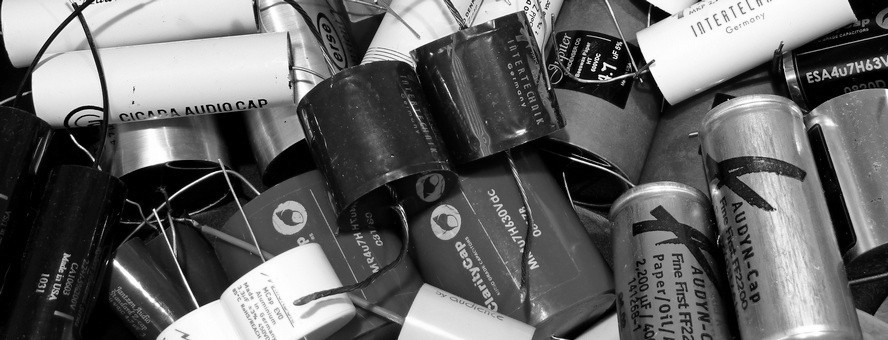
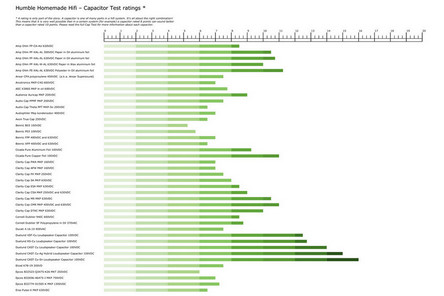
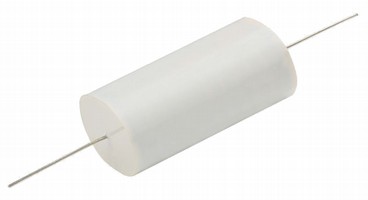 =
= 